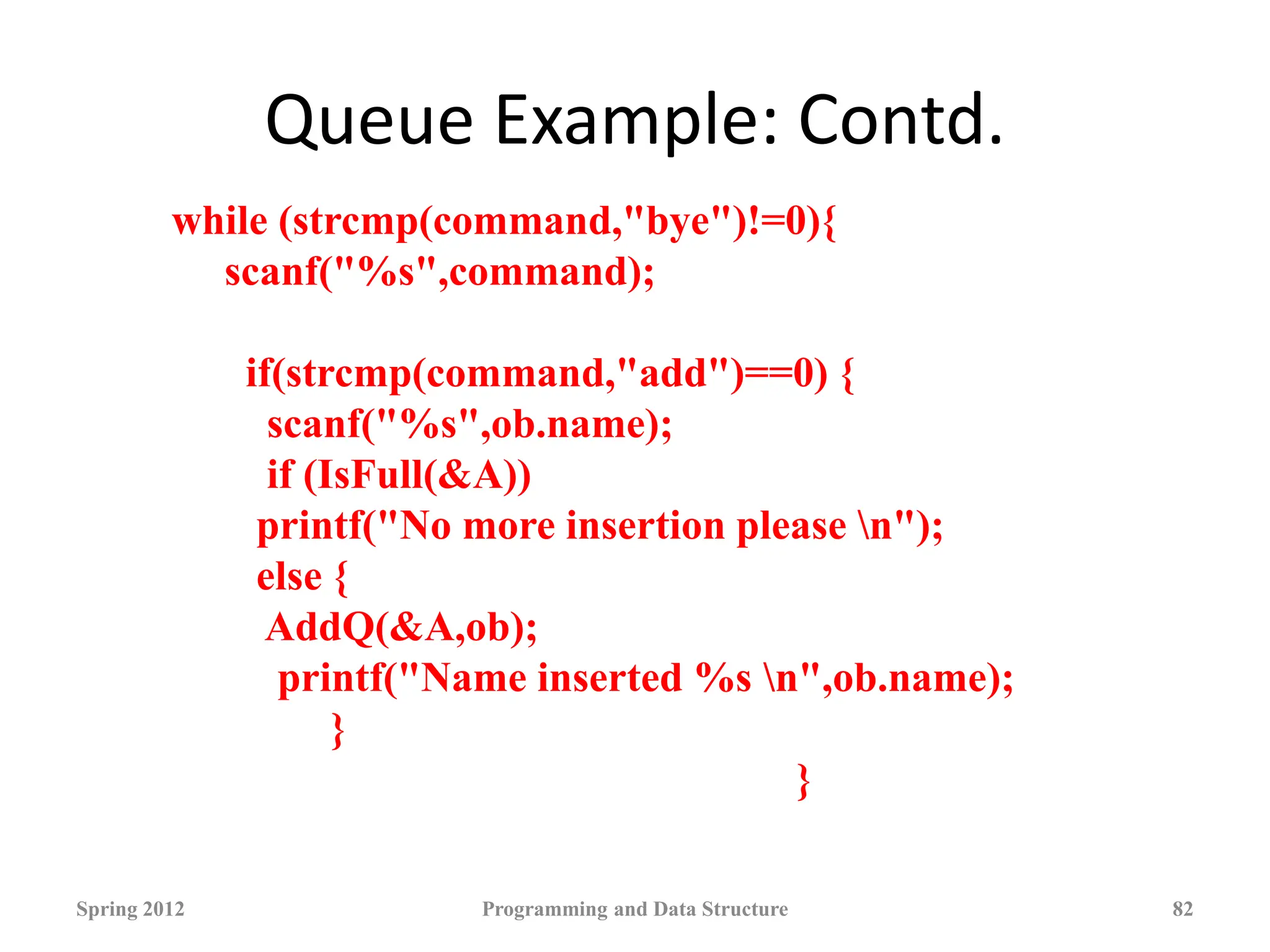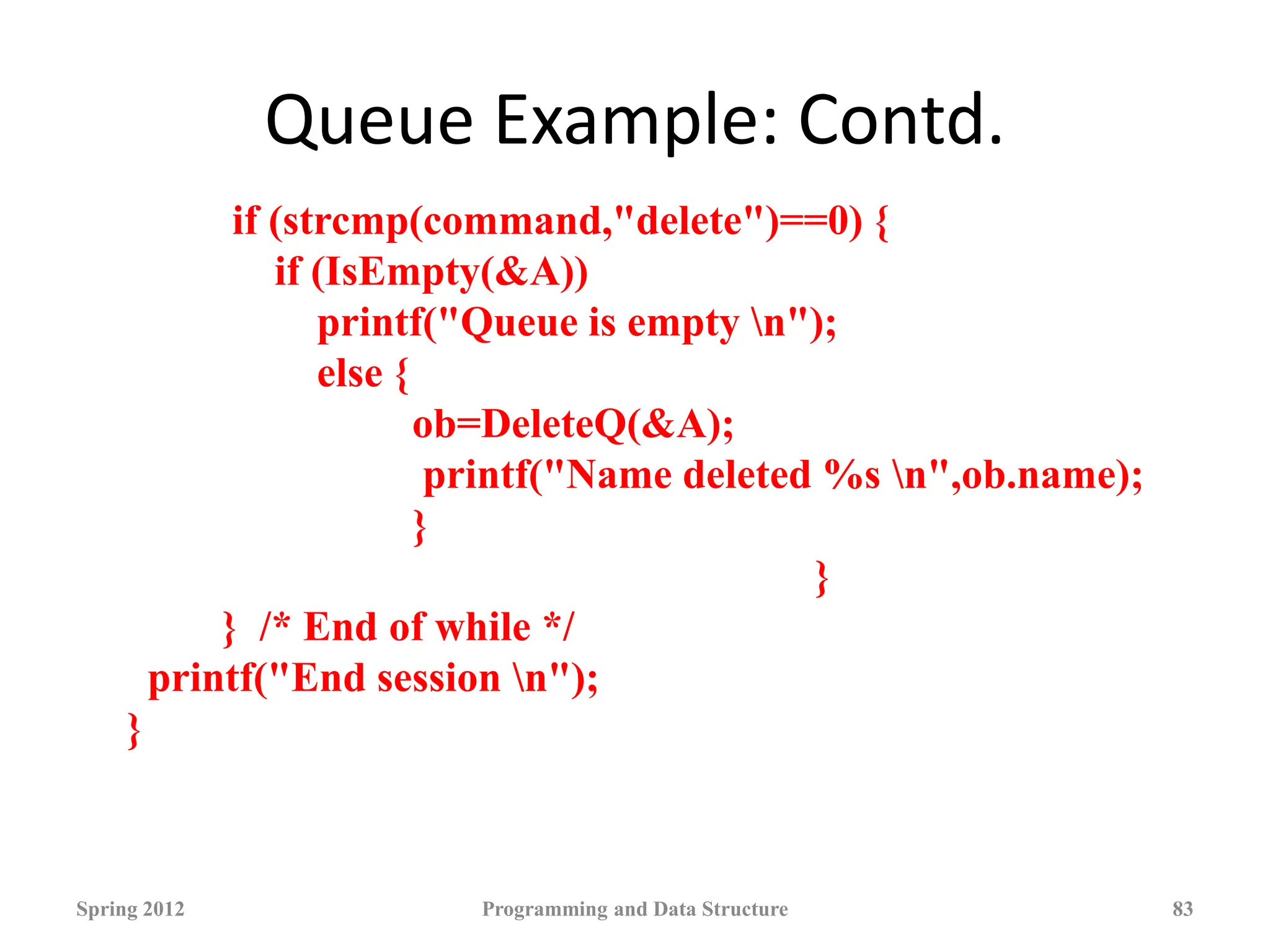This document provides an introduction to linked lists. Key points include:
- Linked lists can change size dynamically by adding or removing nodes using pointers. Each node contains a data element and a pointer to the next node.
- Basic linked list operations include traversing the list by following pointers, inserting nodes, and deleting nodes by modifying pointers.
- Linked lists are well-suited for sequential access of data and applications where the size is unknown, while arrays are better for random access and fixed sizes.

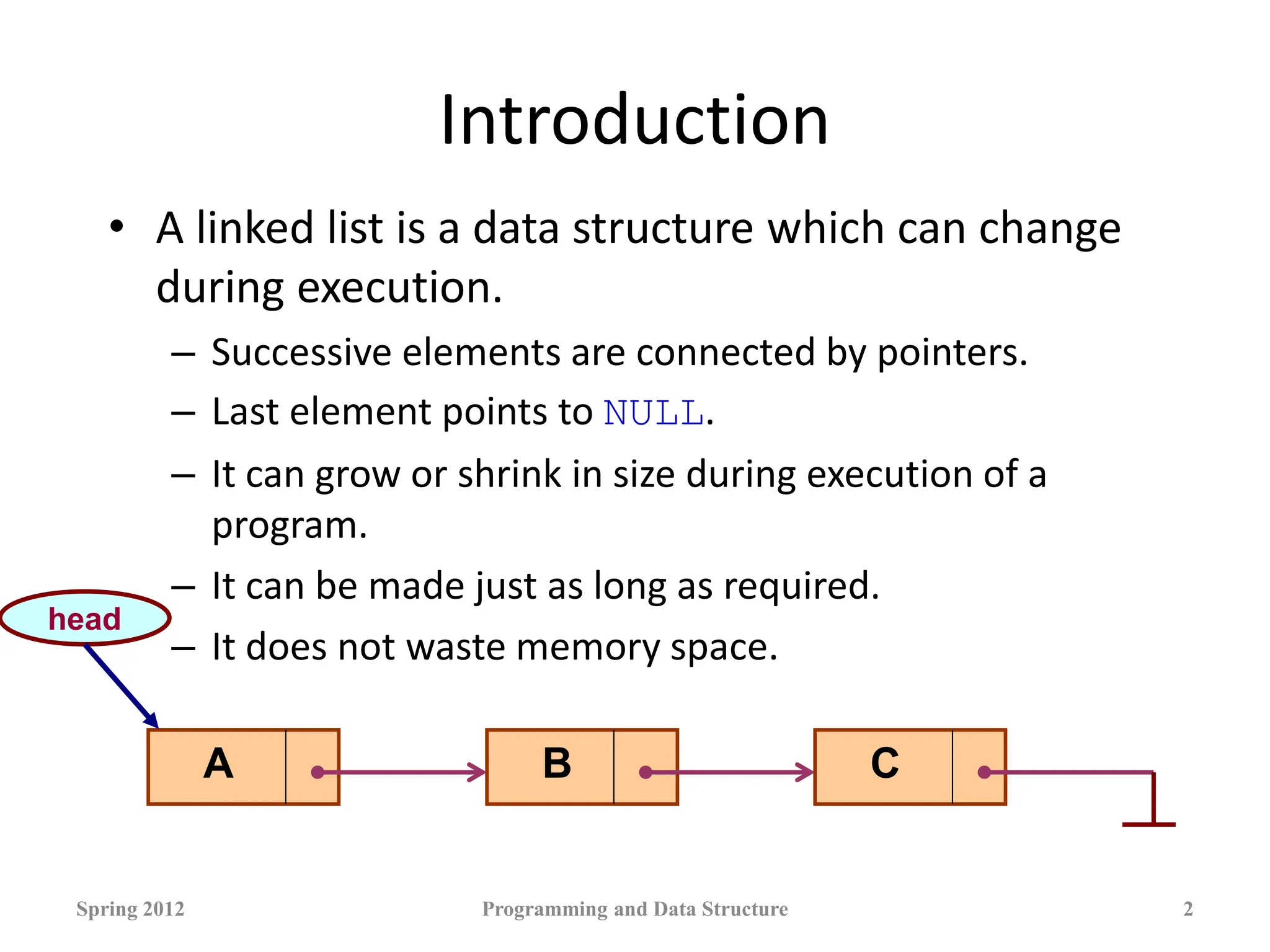
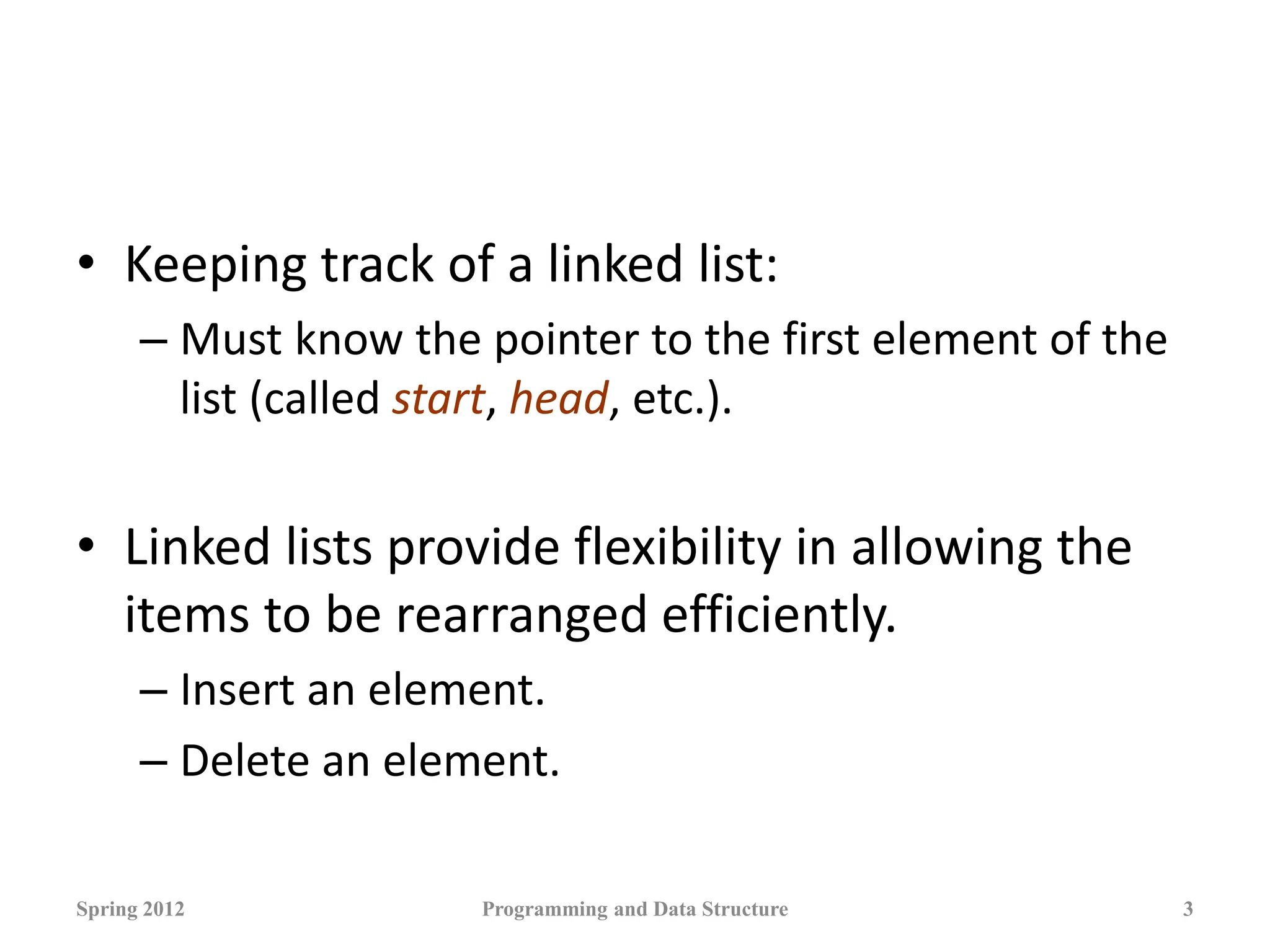

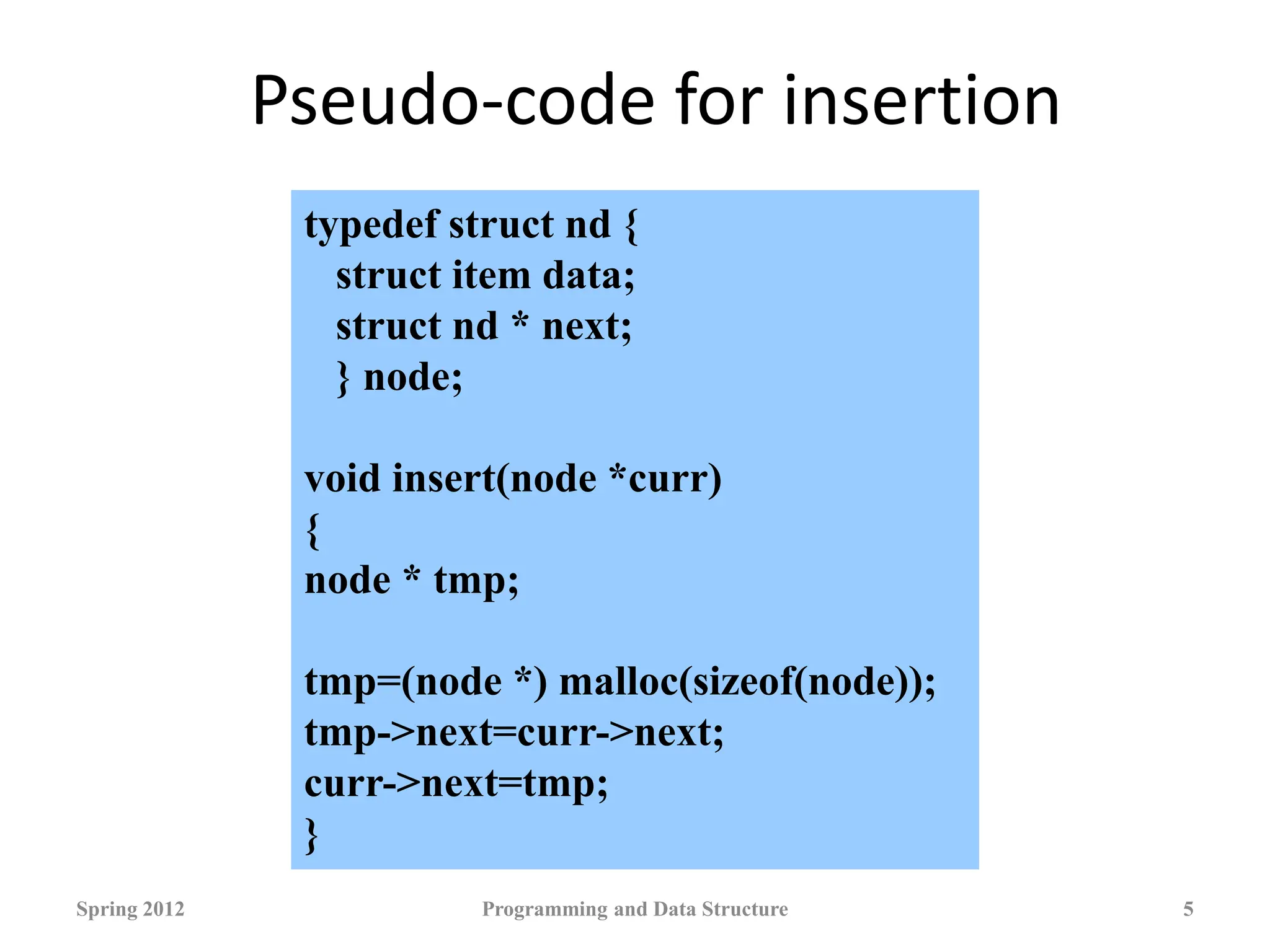
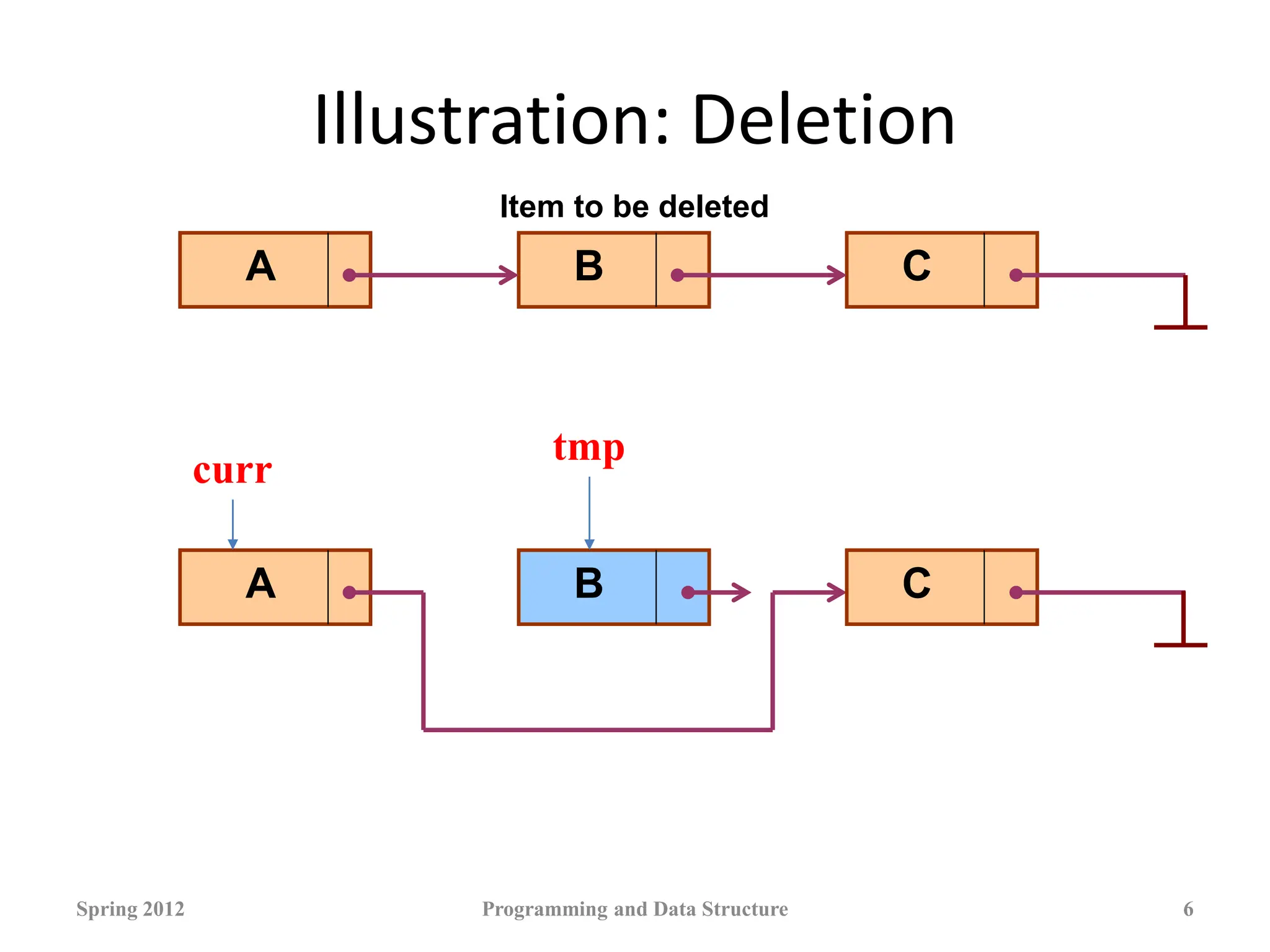
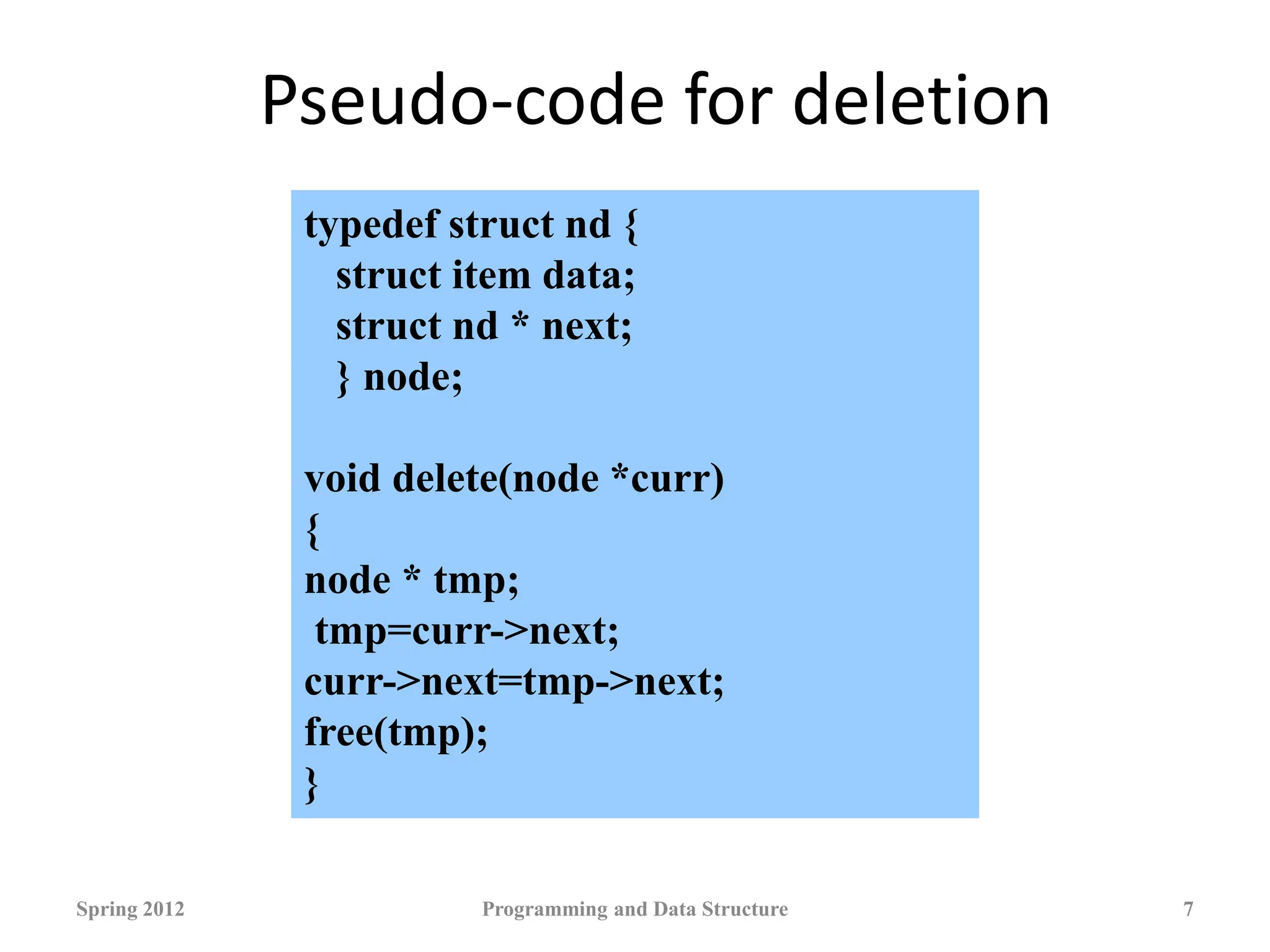
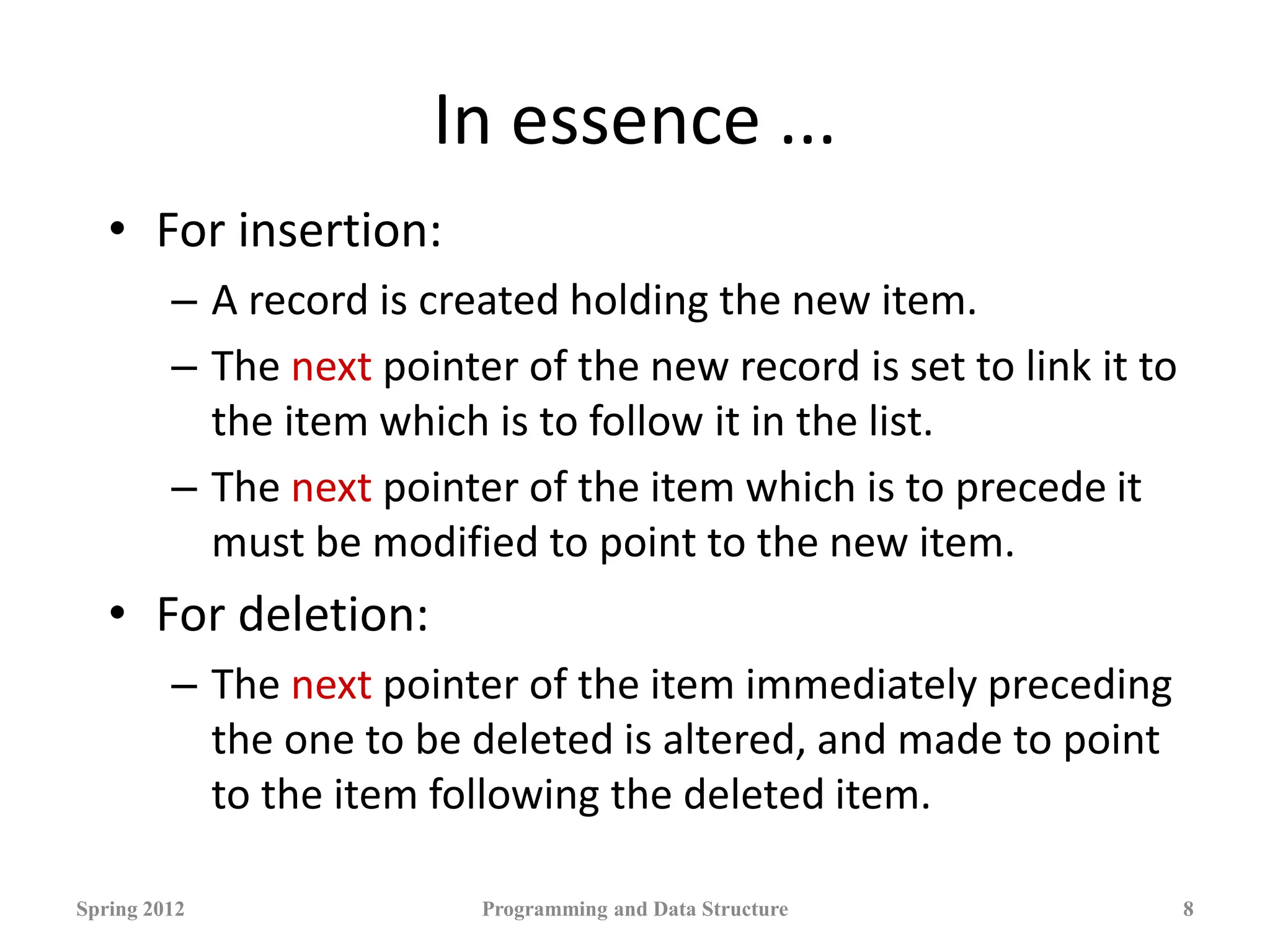
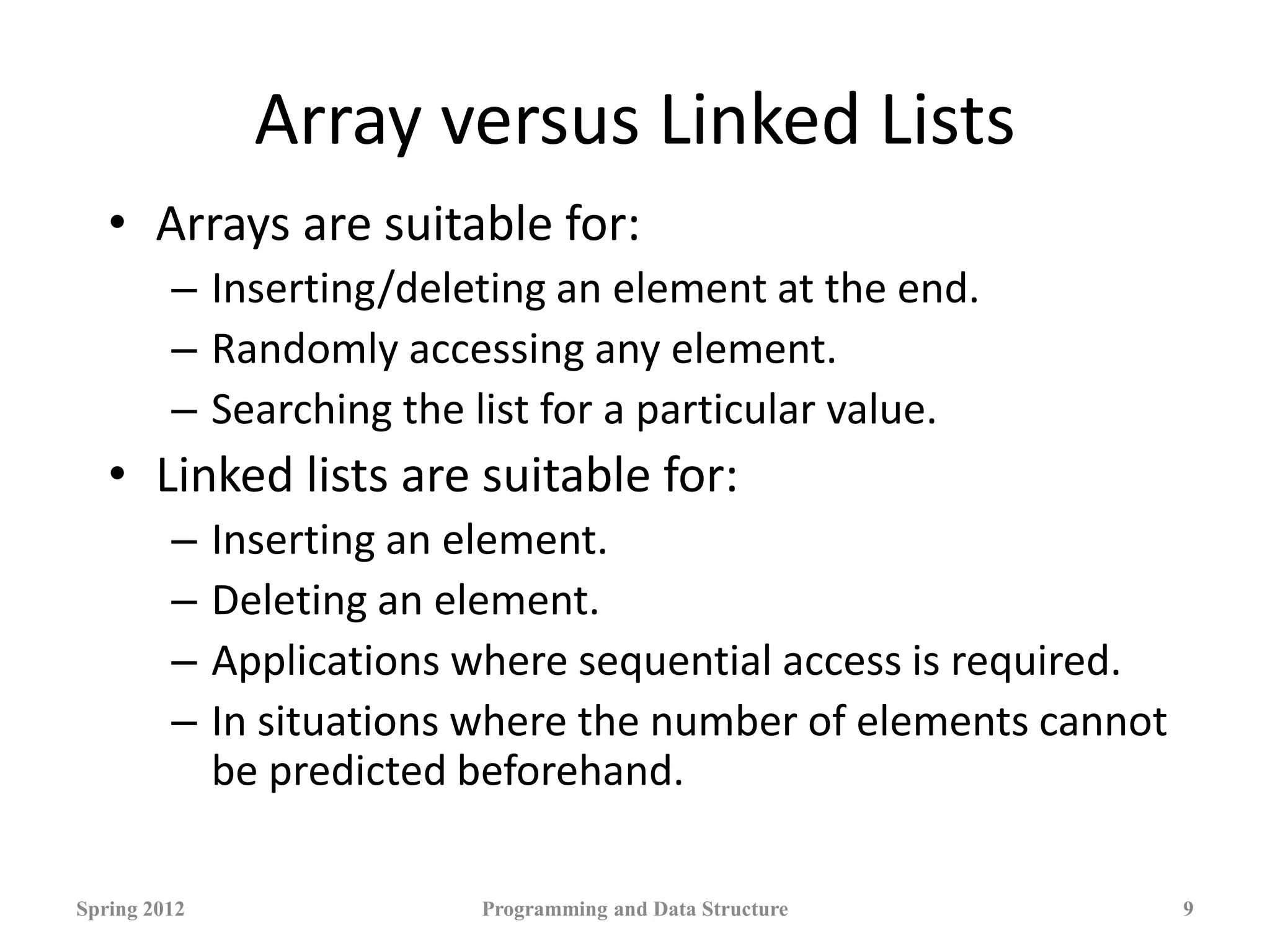
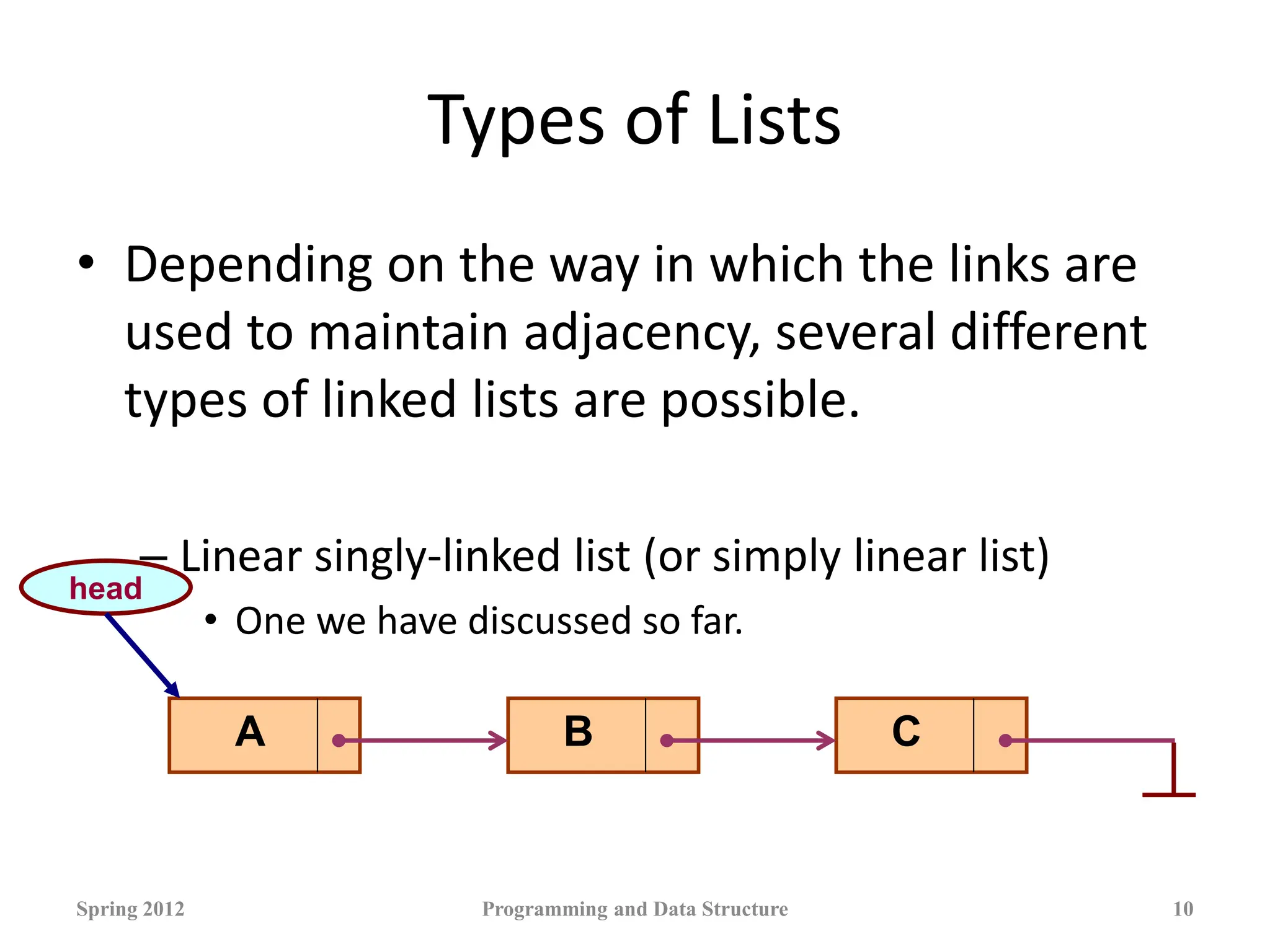
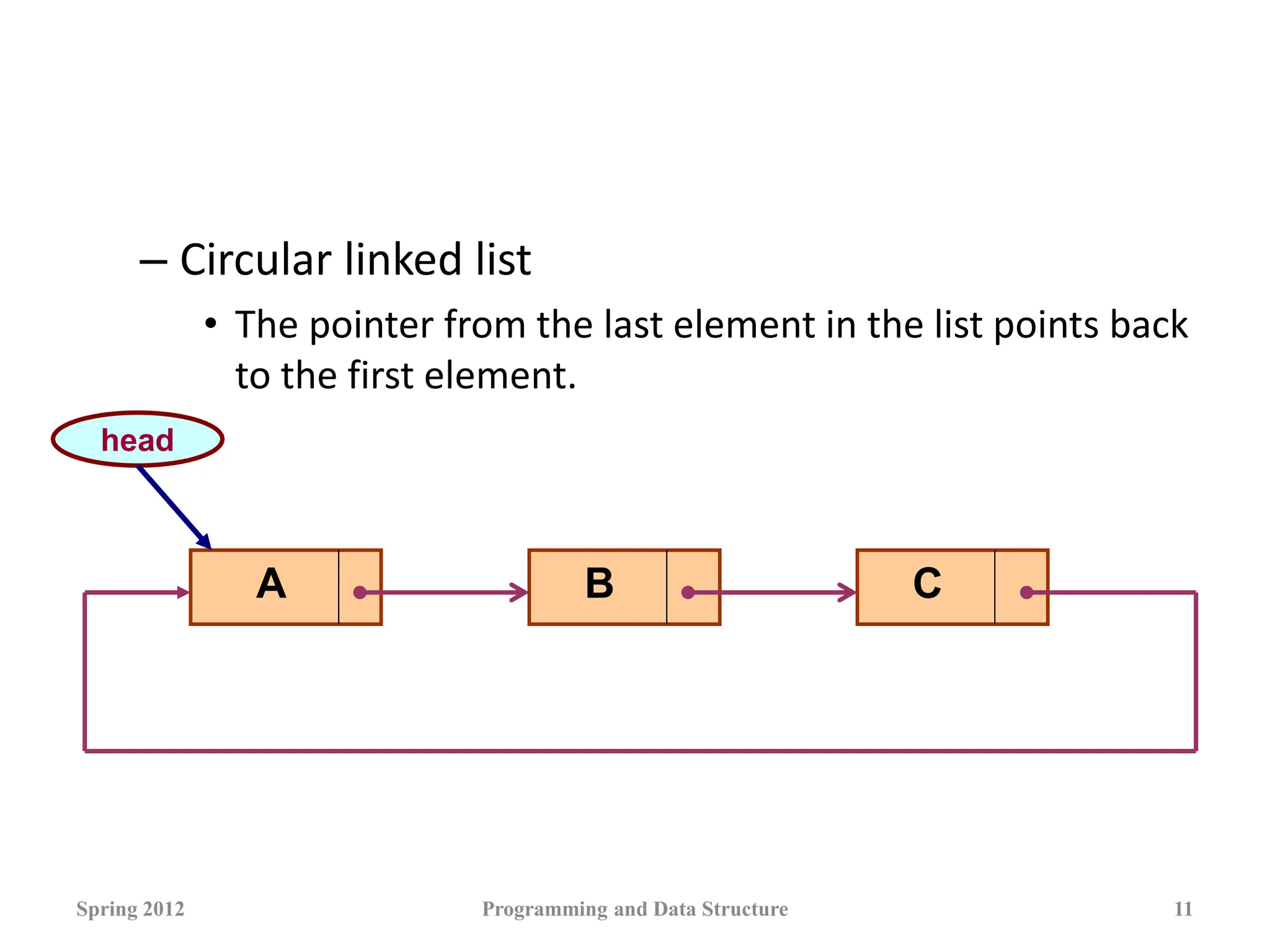
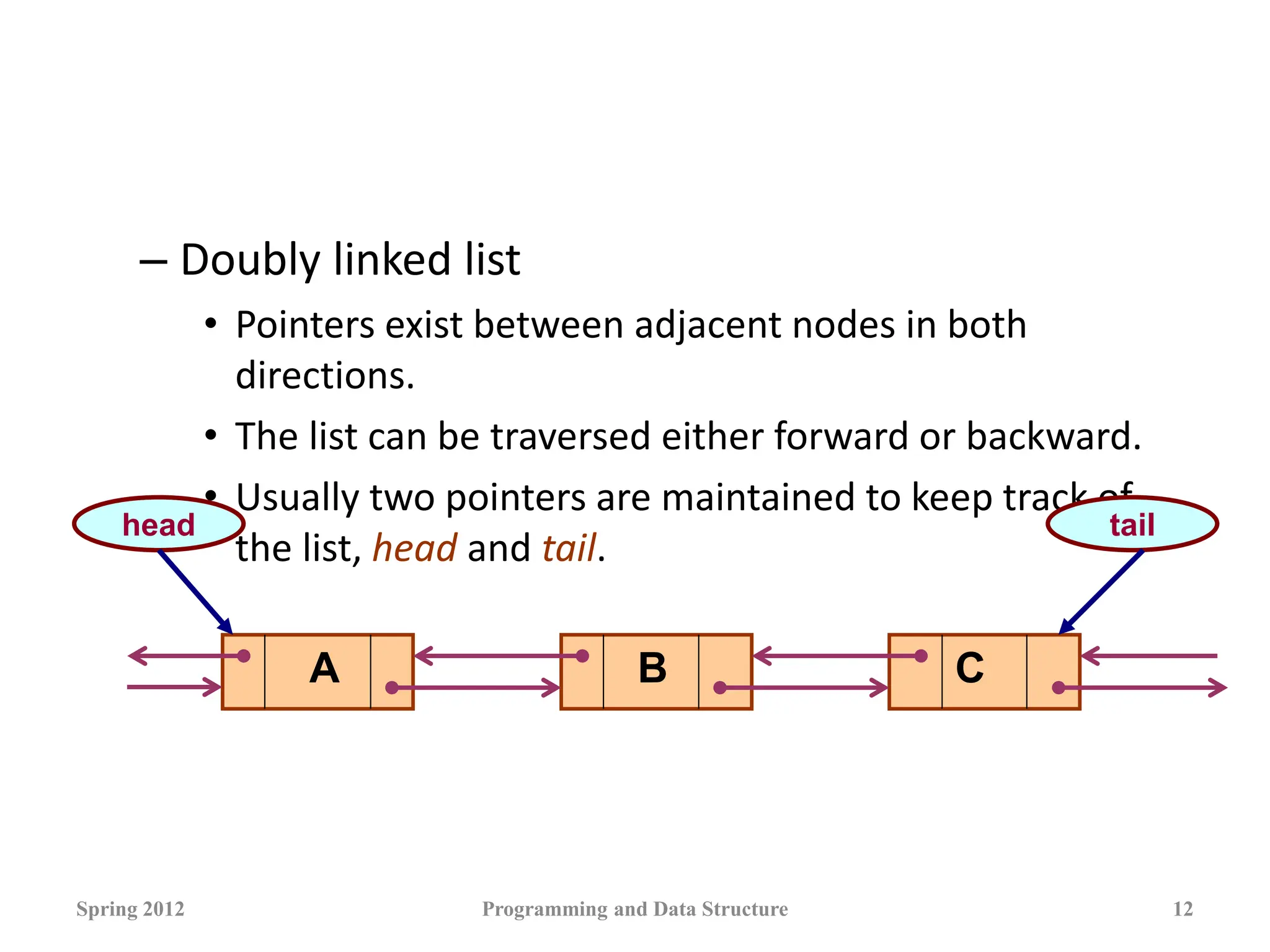

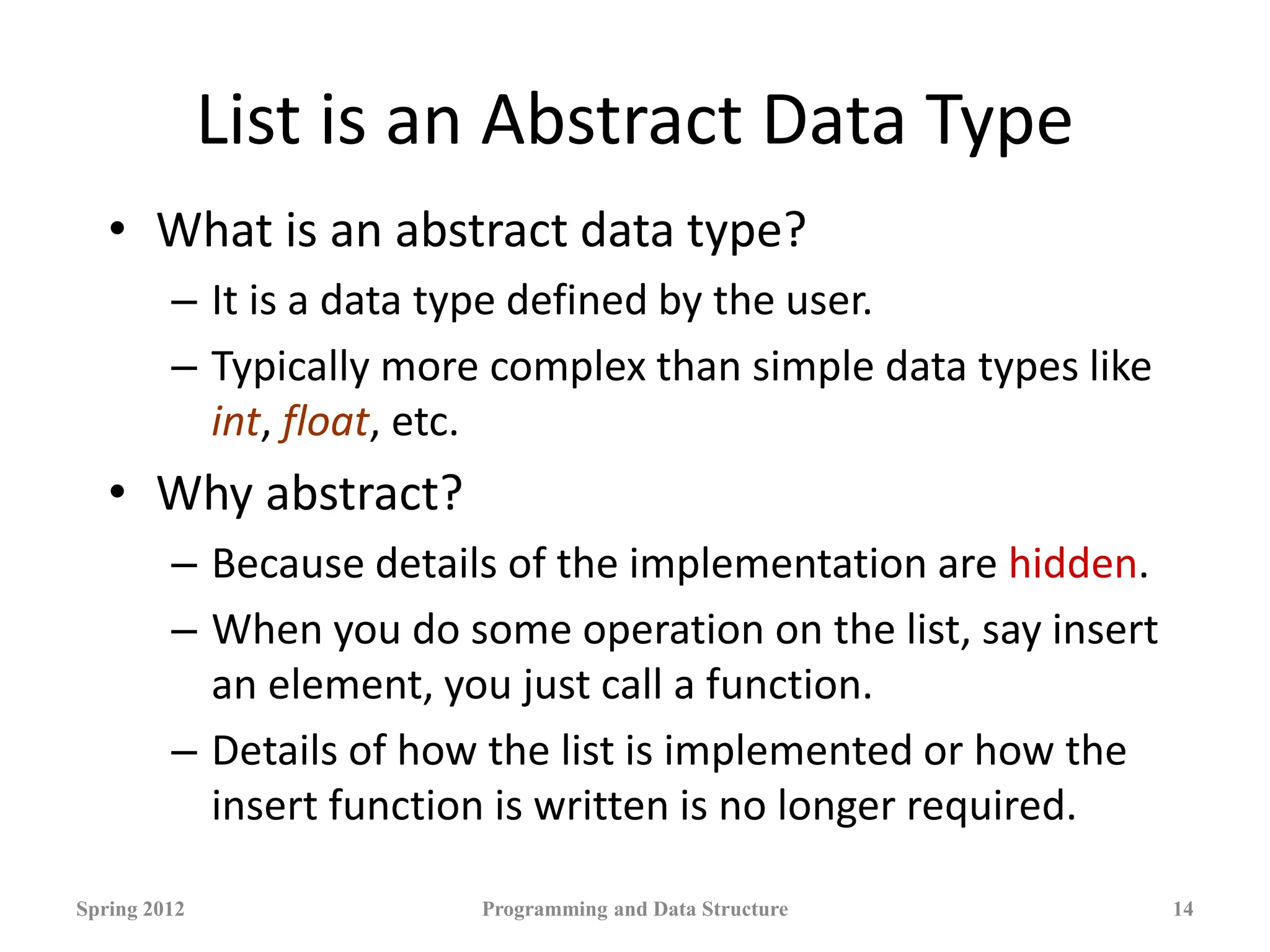
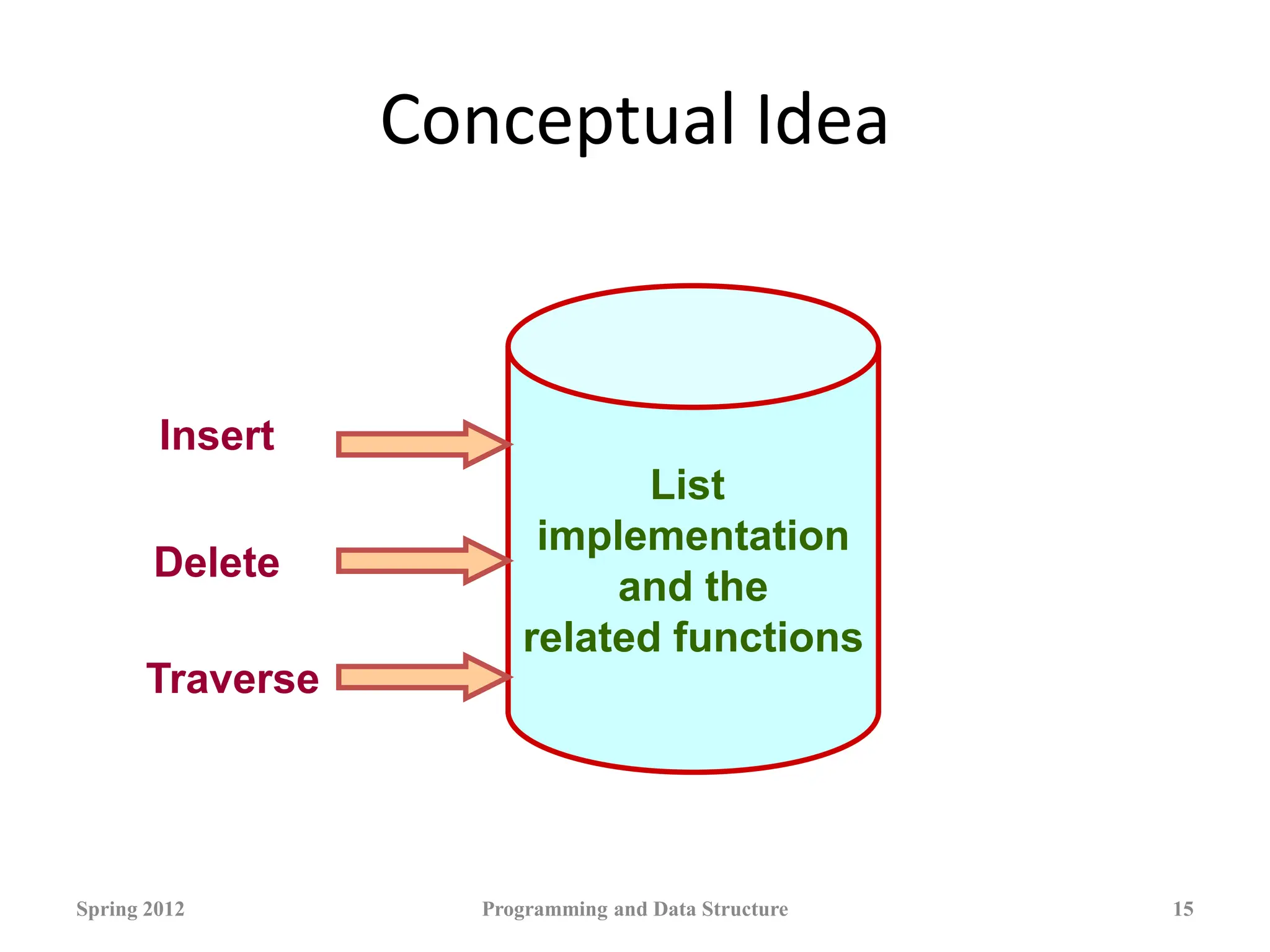
![Example: Working with linked list
• Consider the structure of a node as follows:
struct stud {
int roll;
char name[25];
int age;
struct stud *next;
};
/* A user-defined data type called “node” */
typedef struct stud node;
node *head;
Spring 2012 Programming and Data Structure 16](https://image.slidesharecdn.com/wk11-linkedlist-240122110853-9cf73267/75/Wk11-linkedlist-ppt-16-2048.jpg)
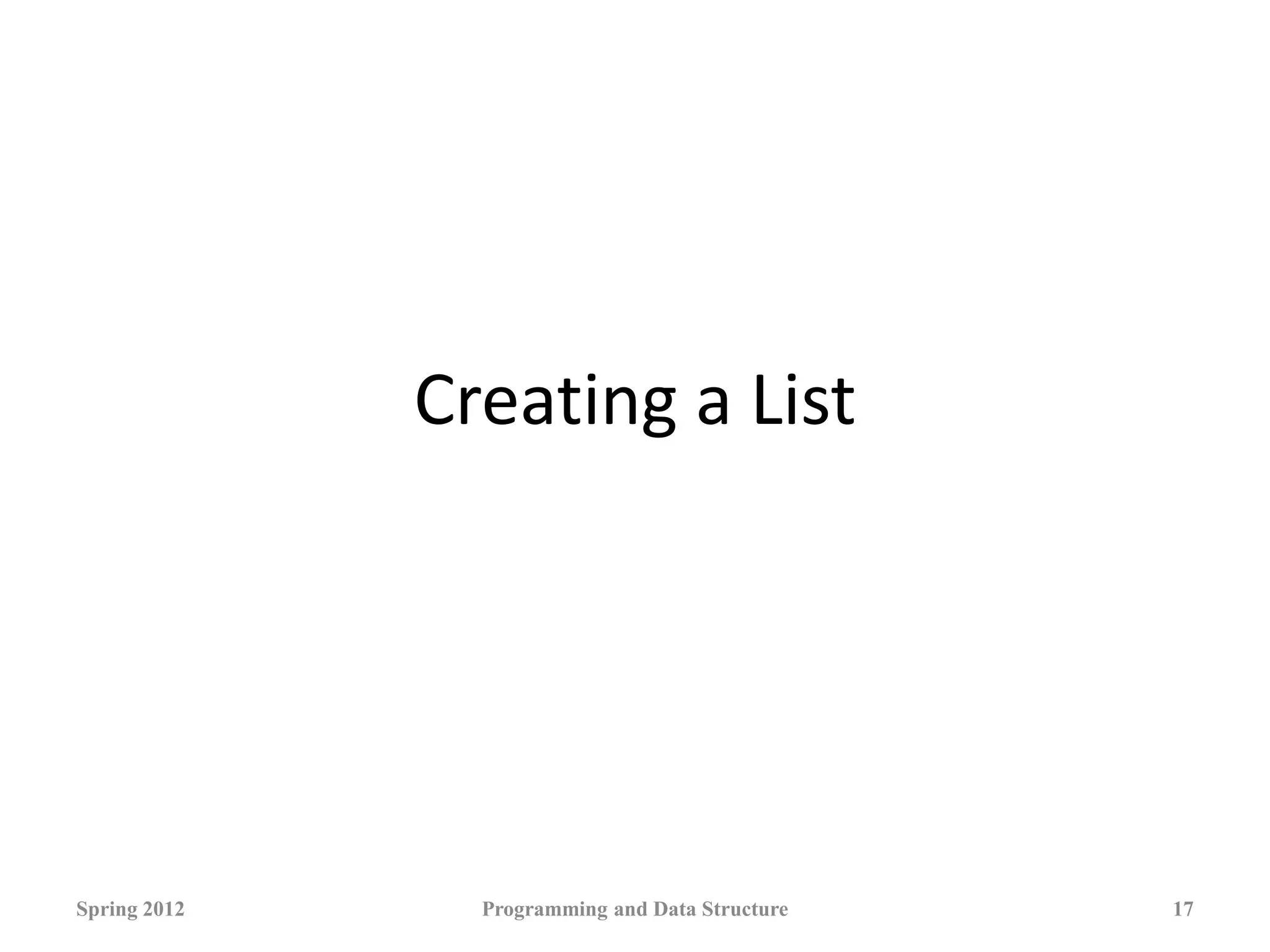
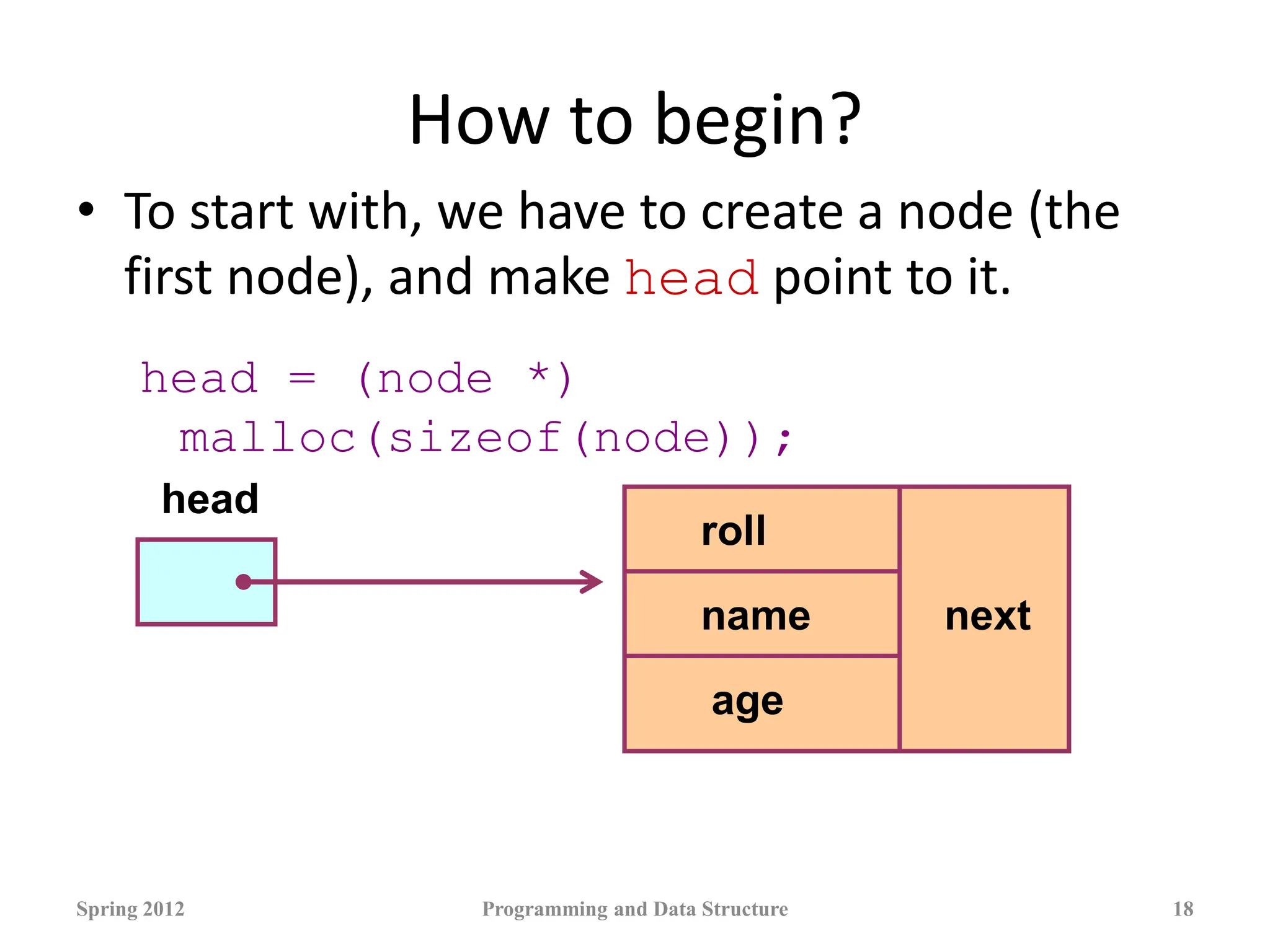
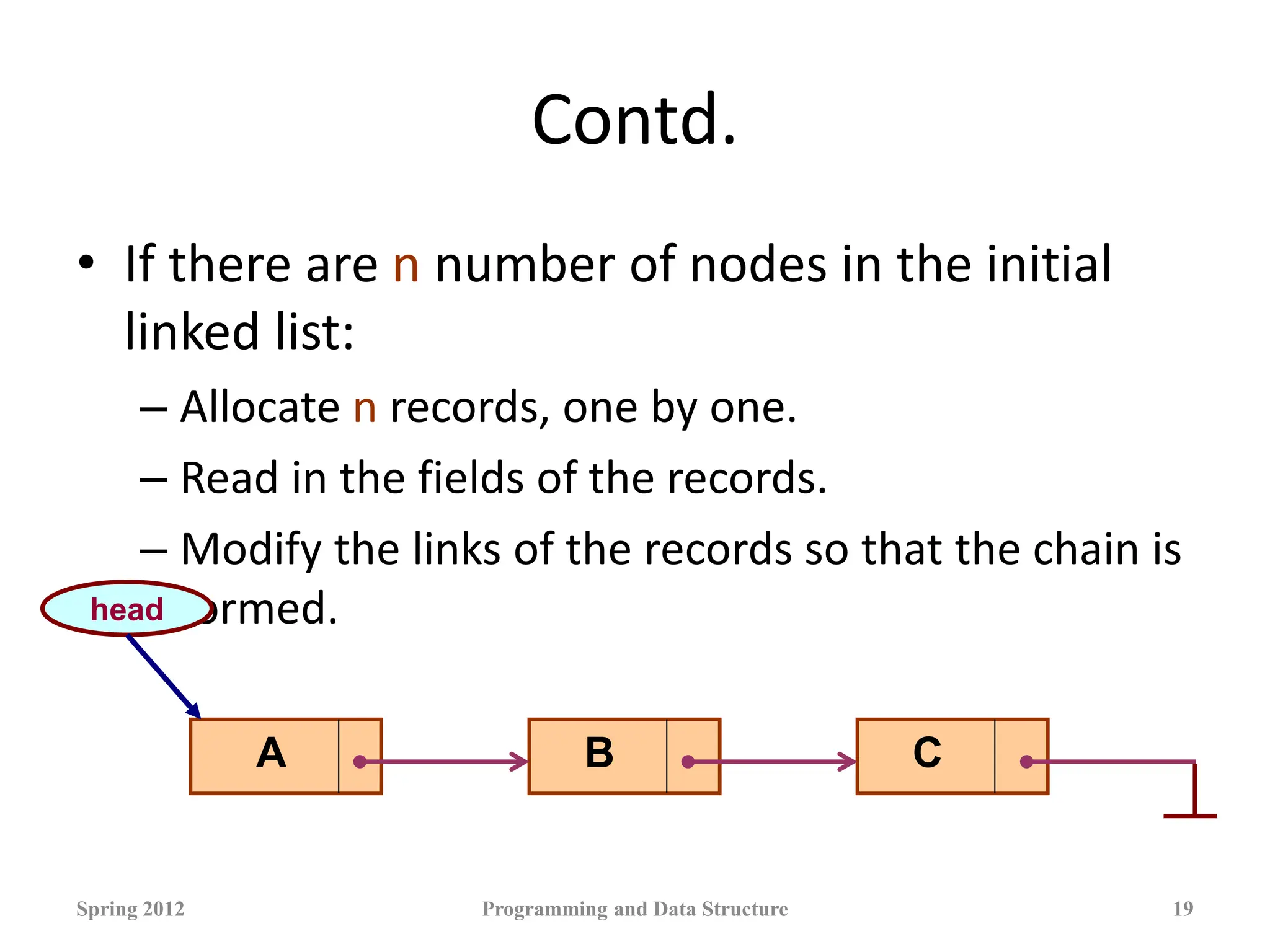

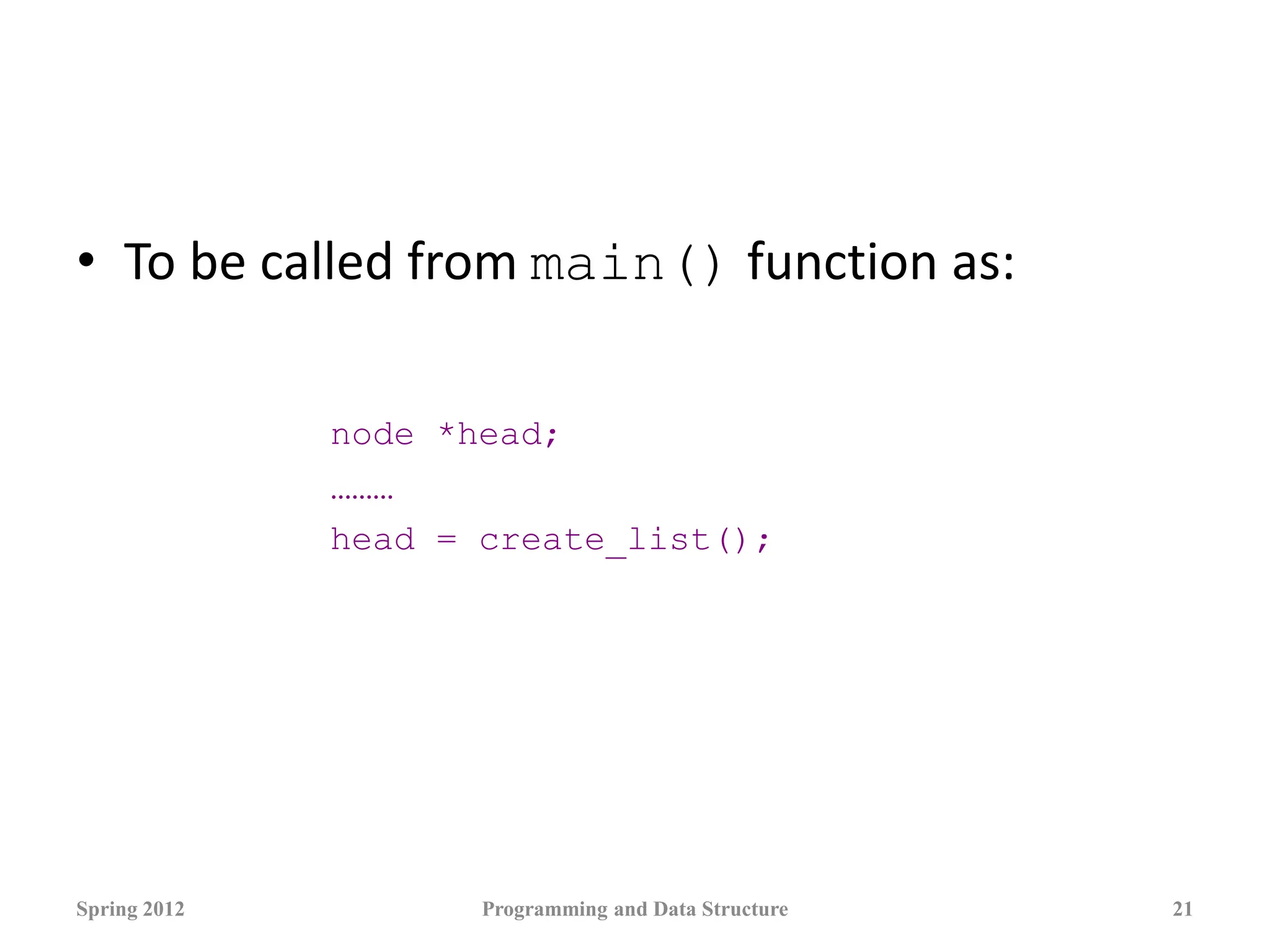
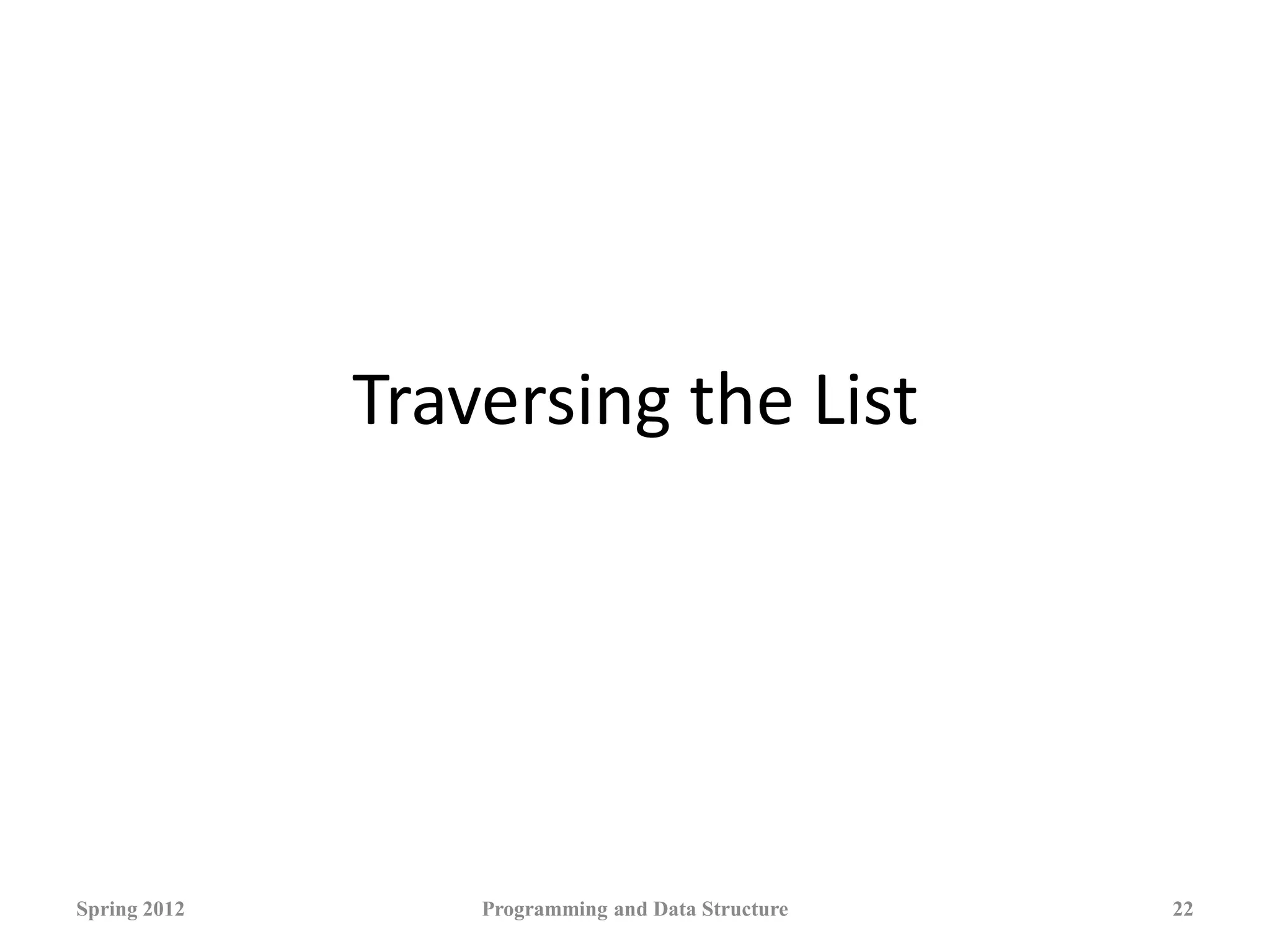

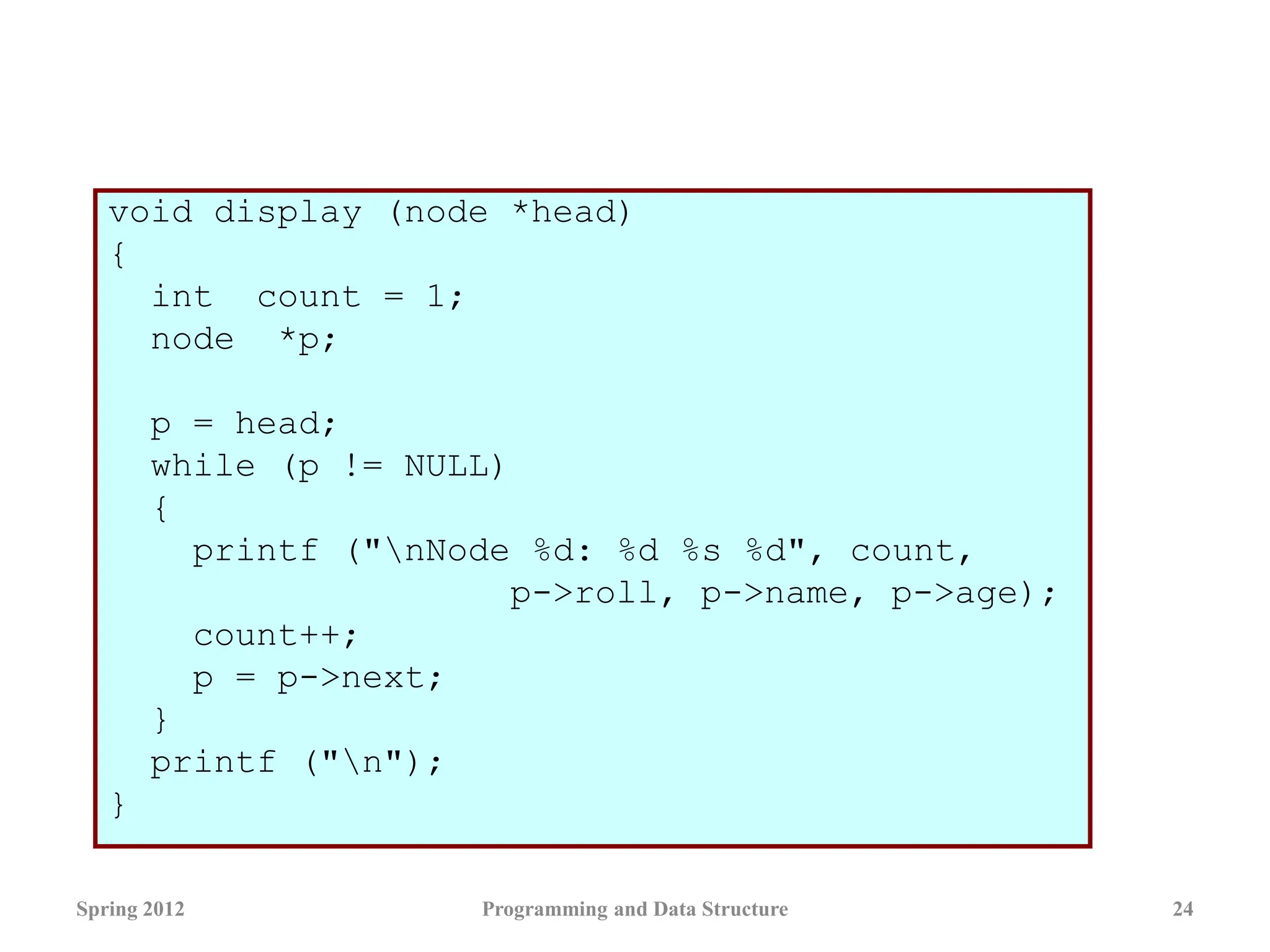
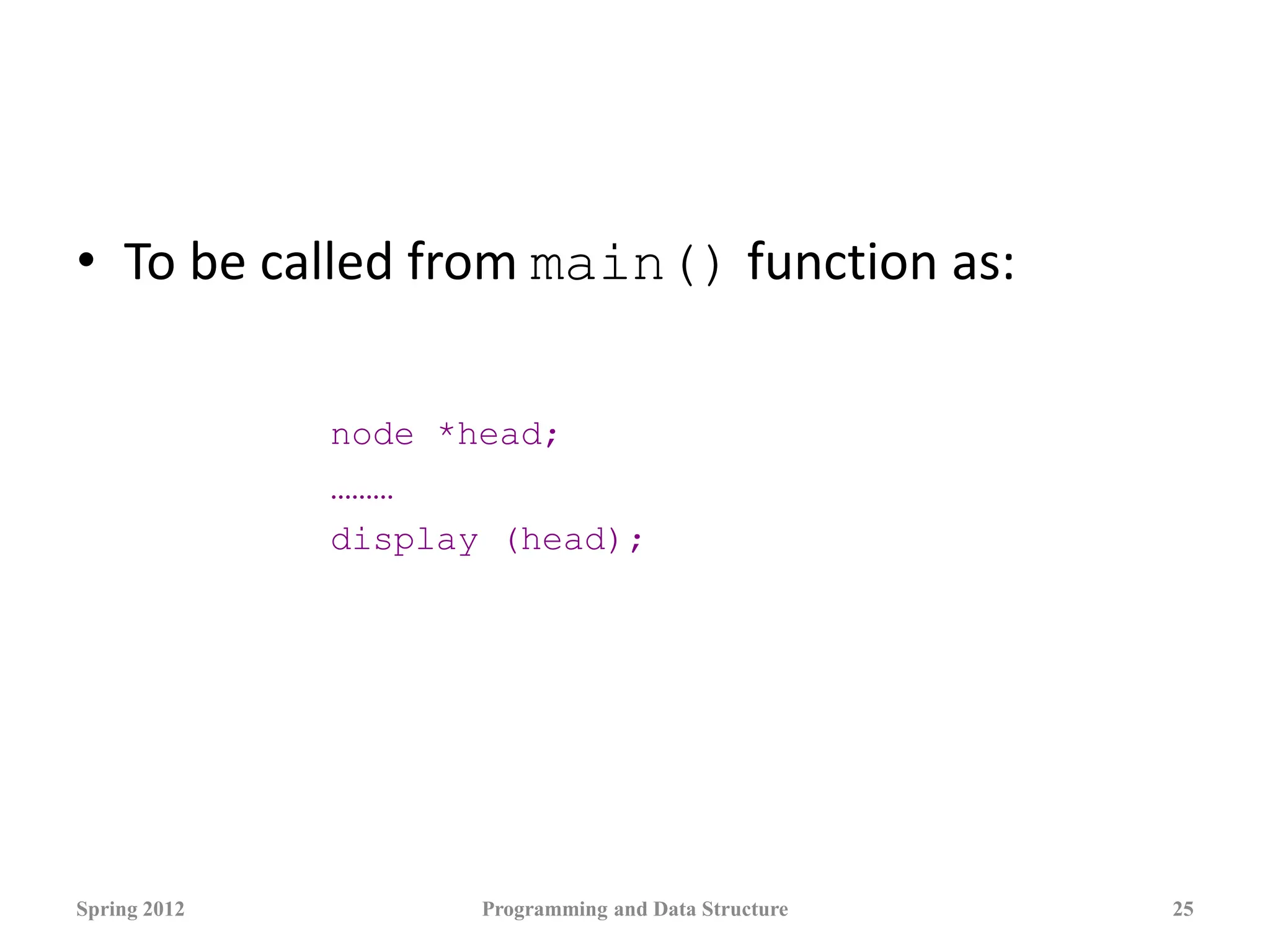
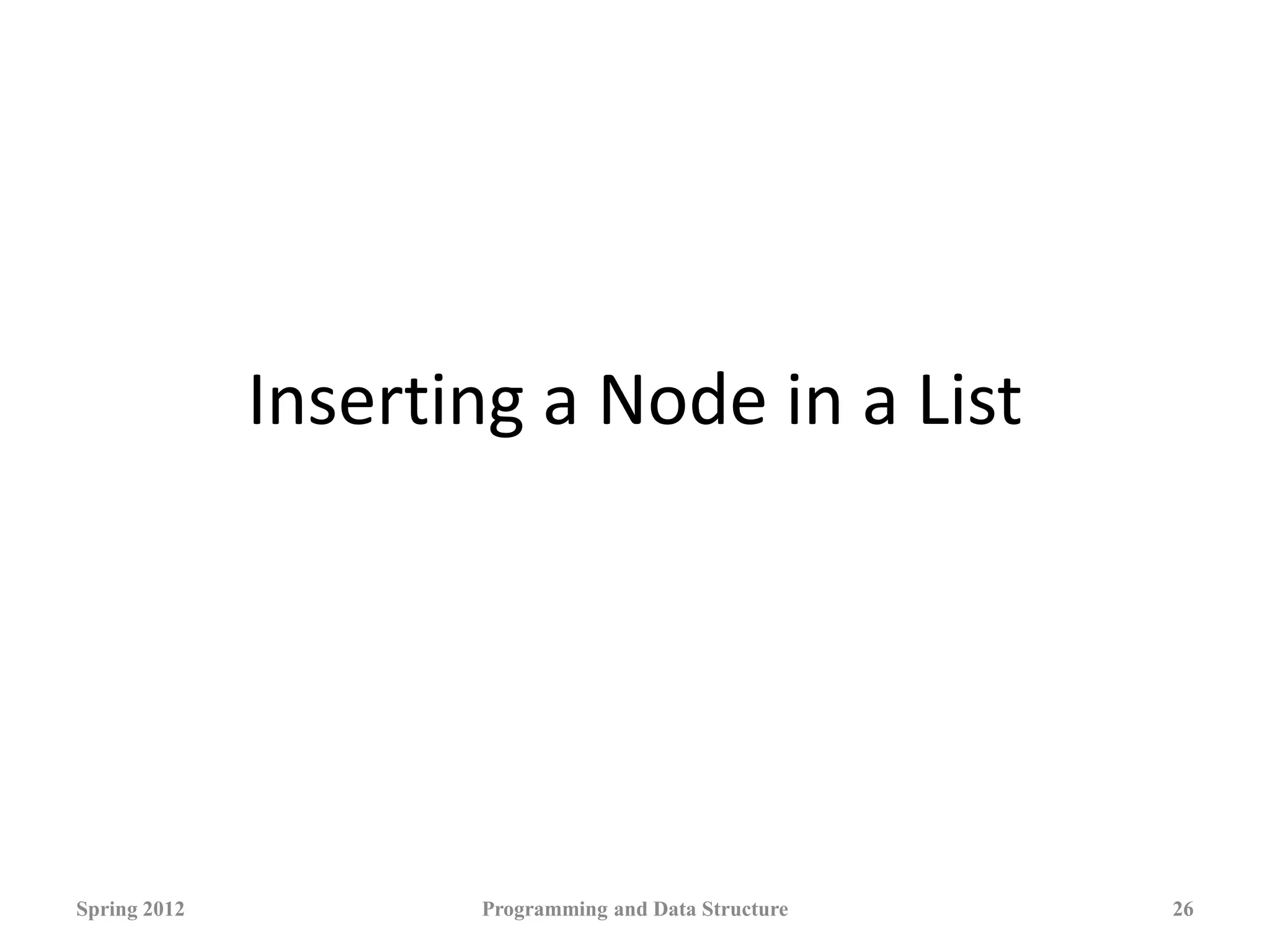
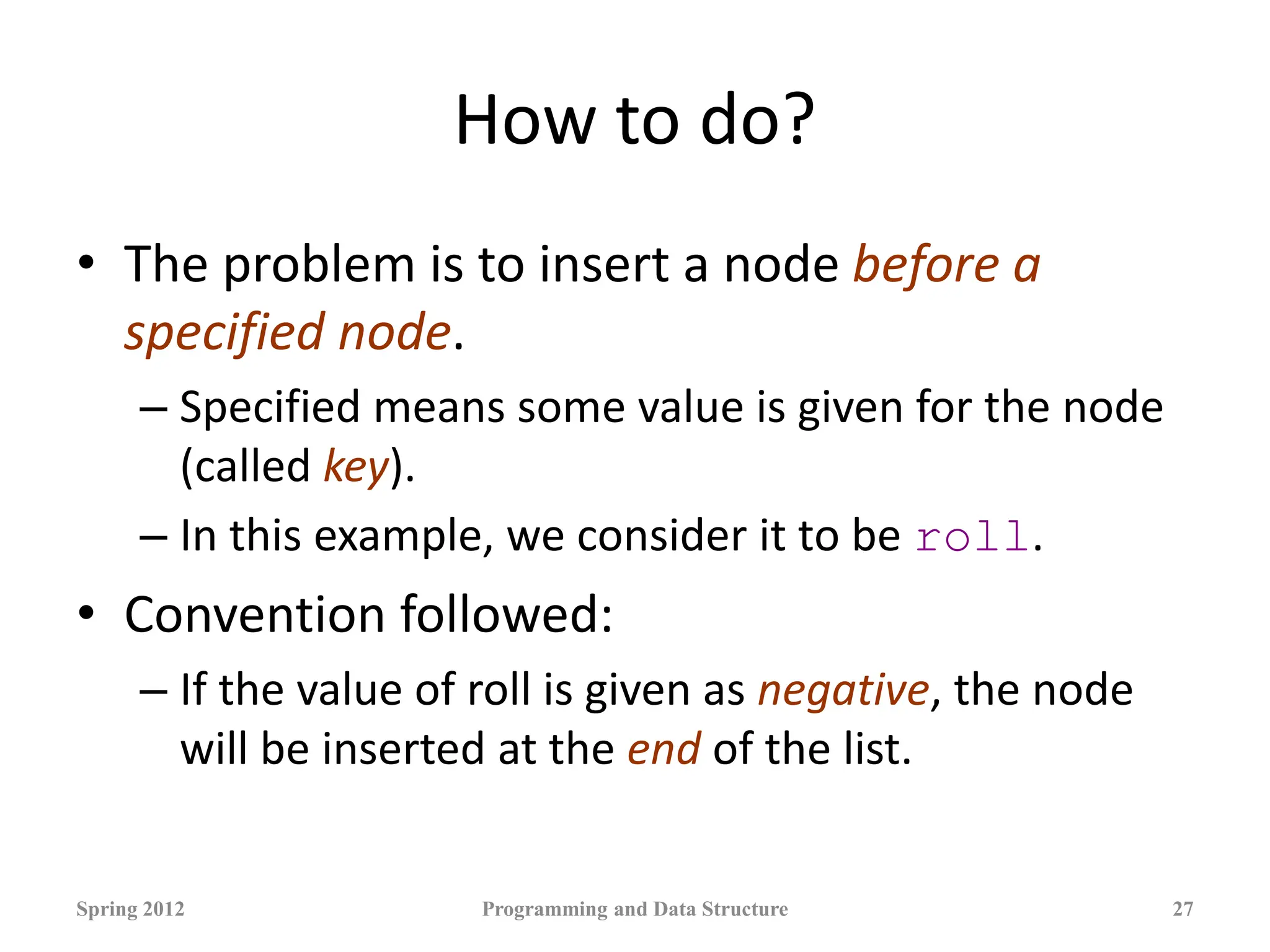
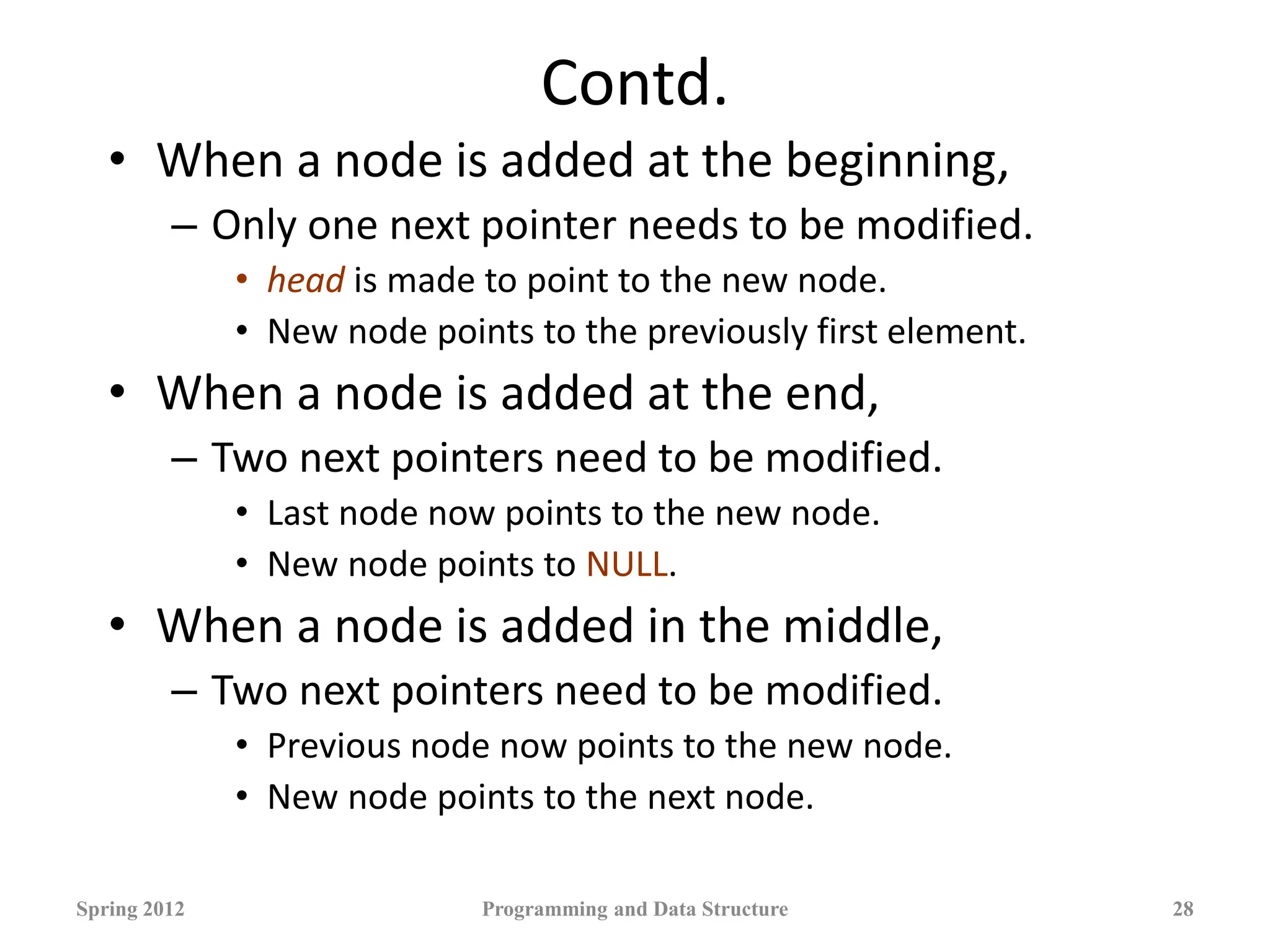
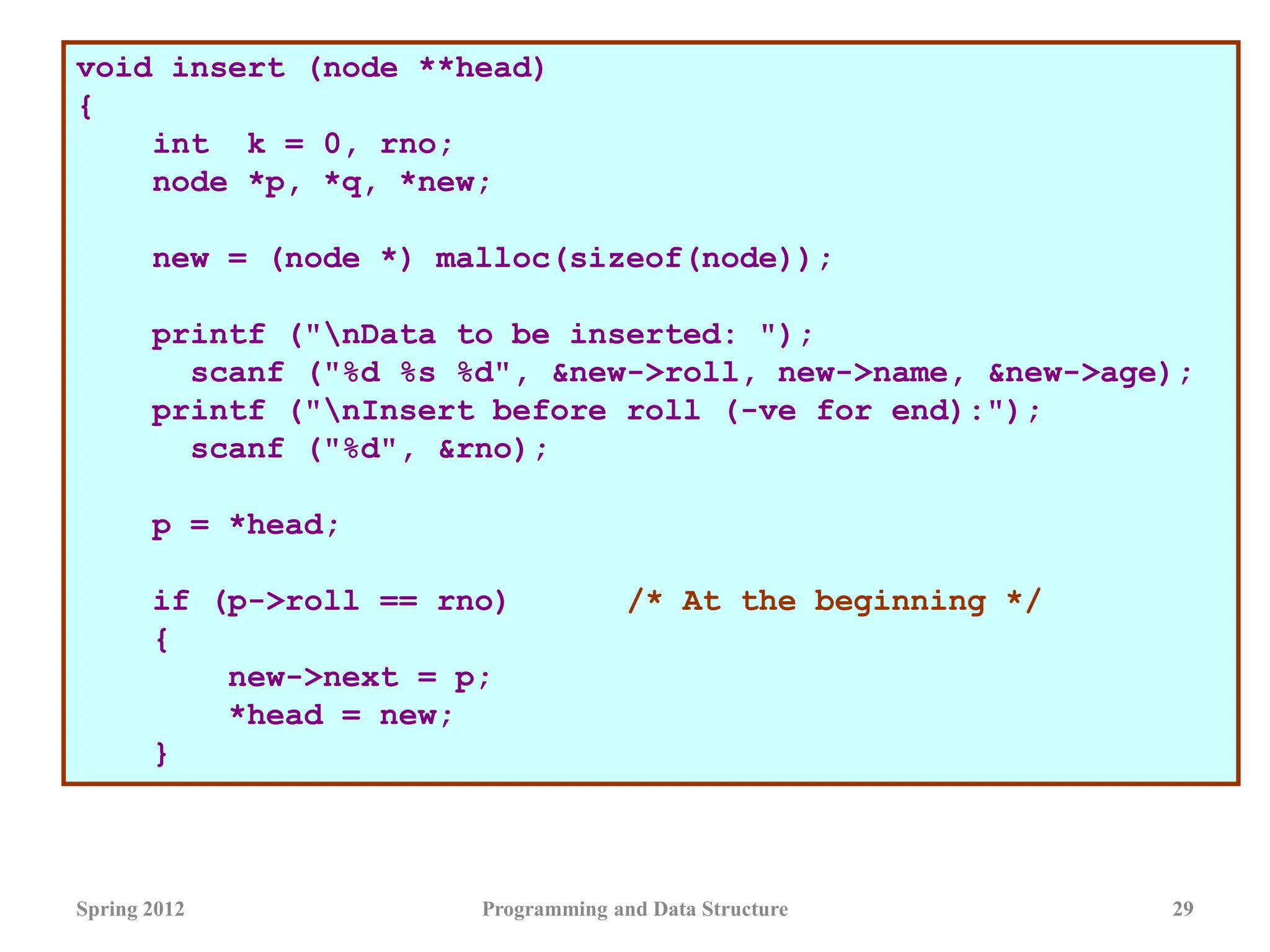

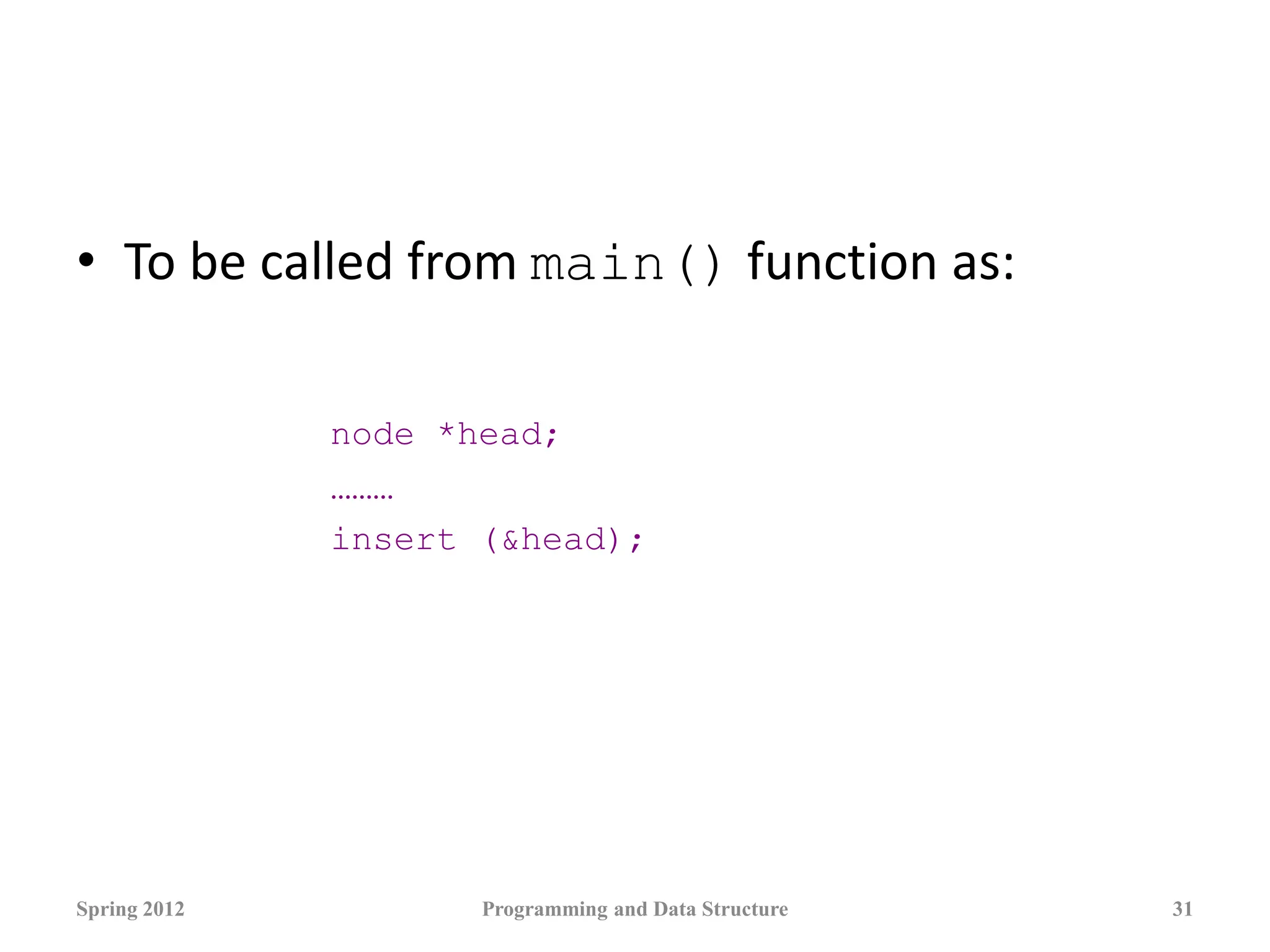
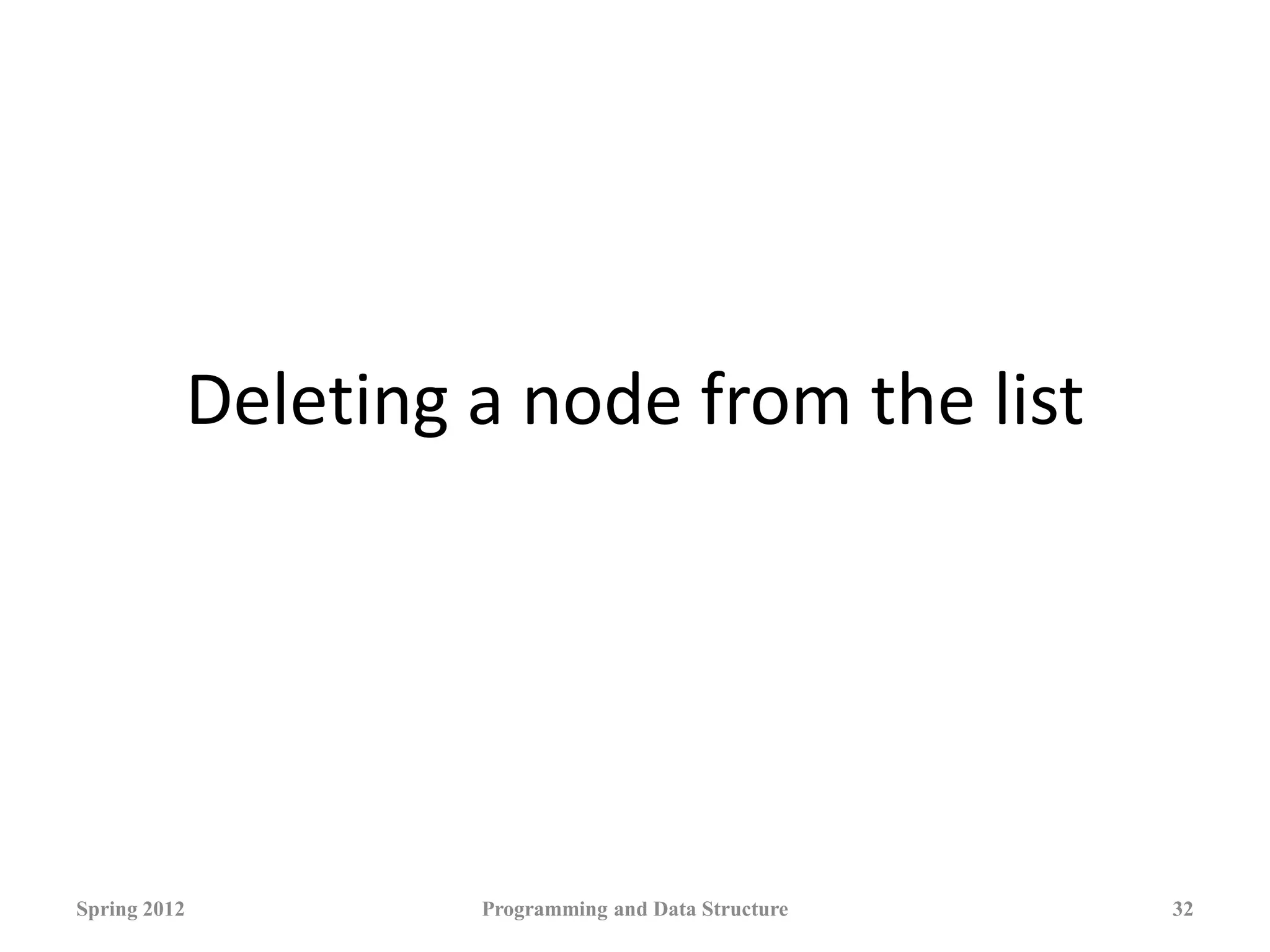
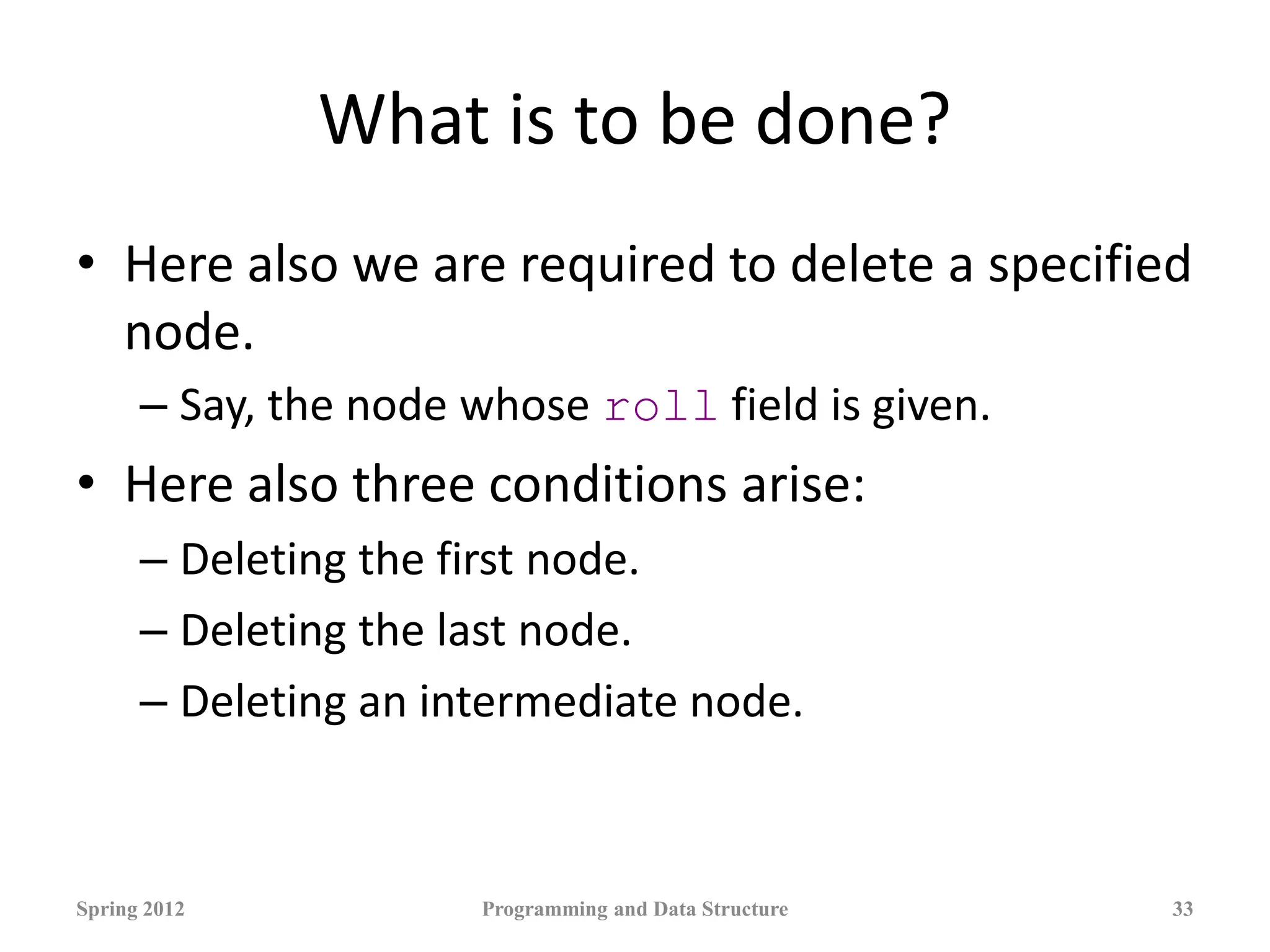
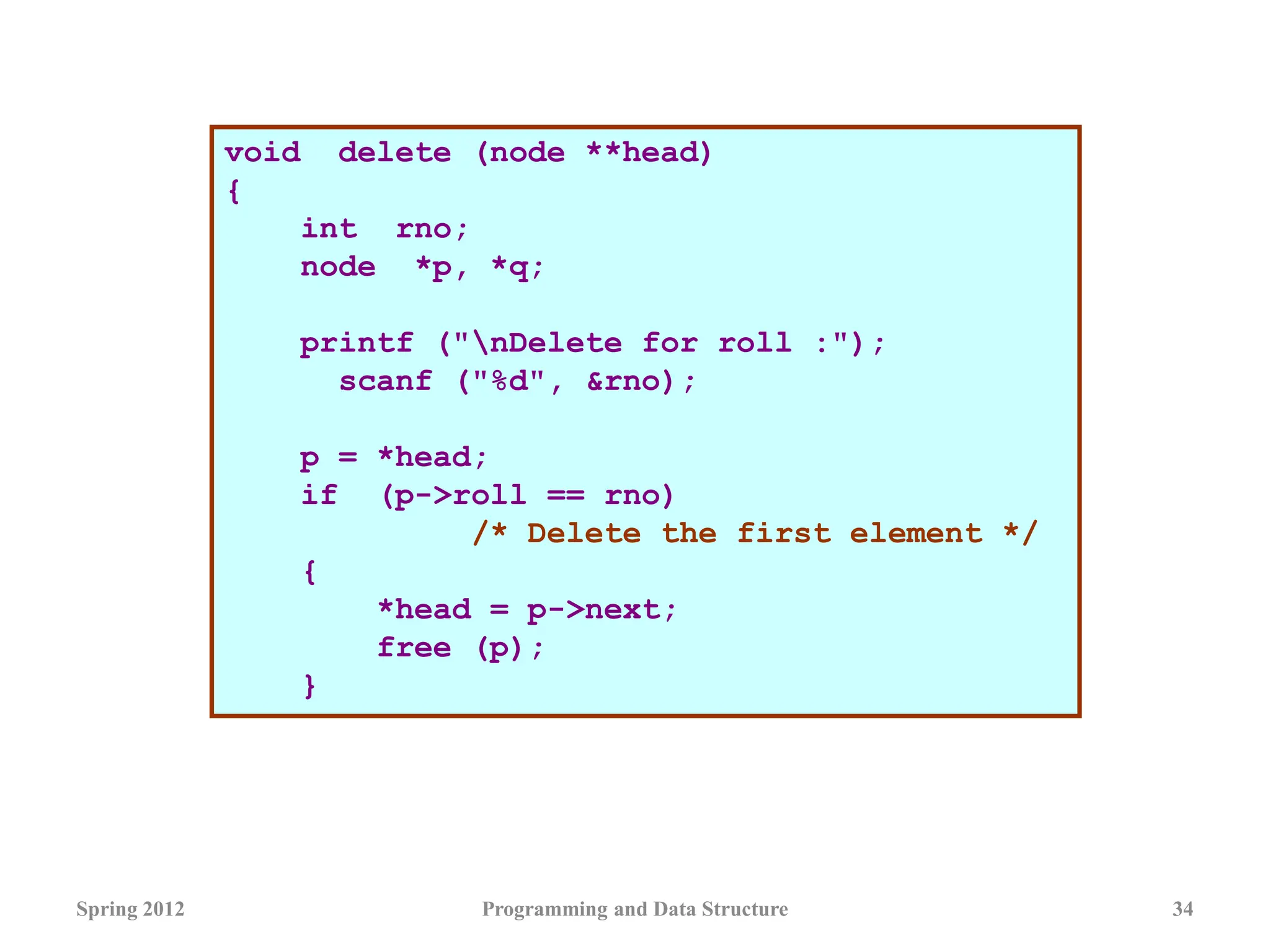
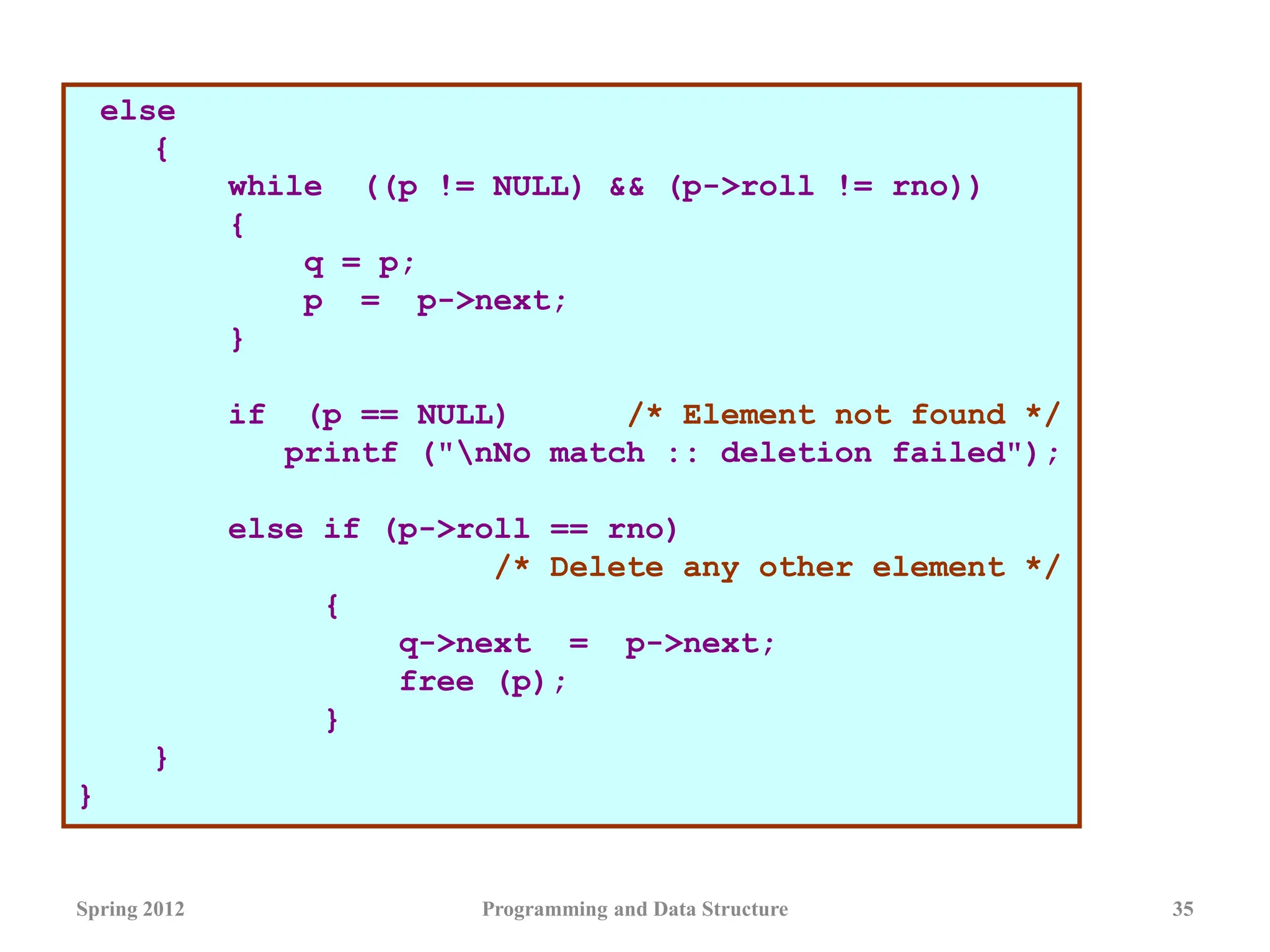
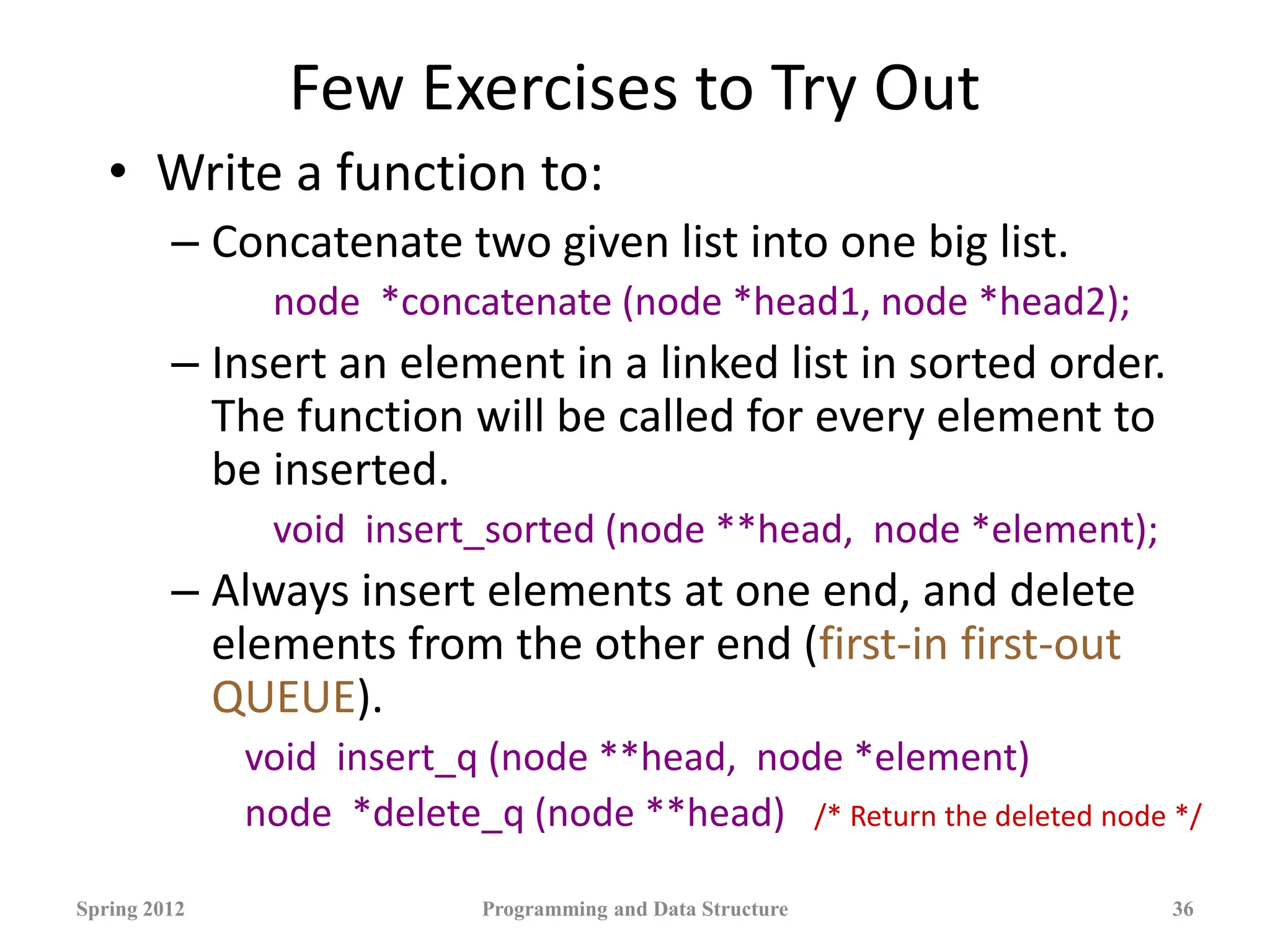
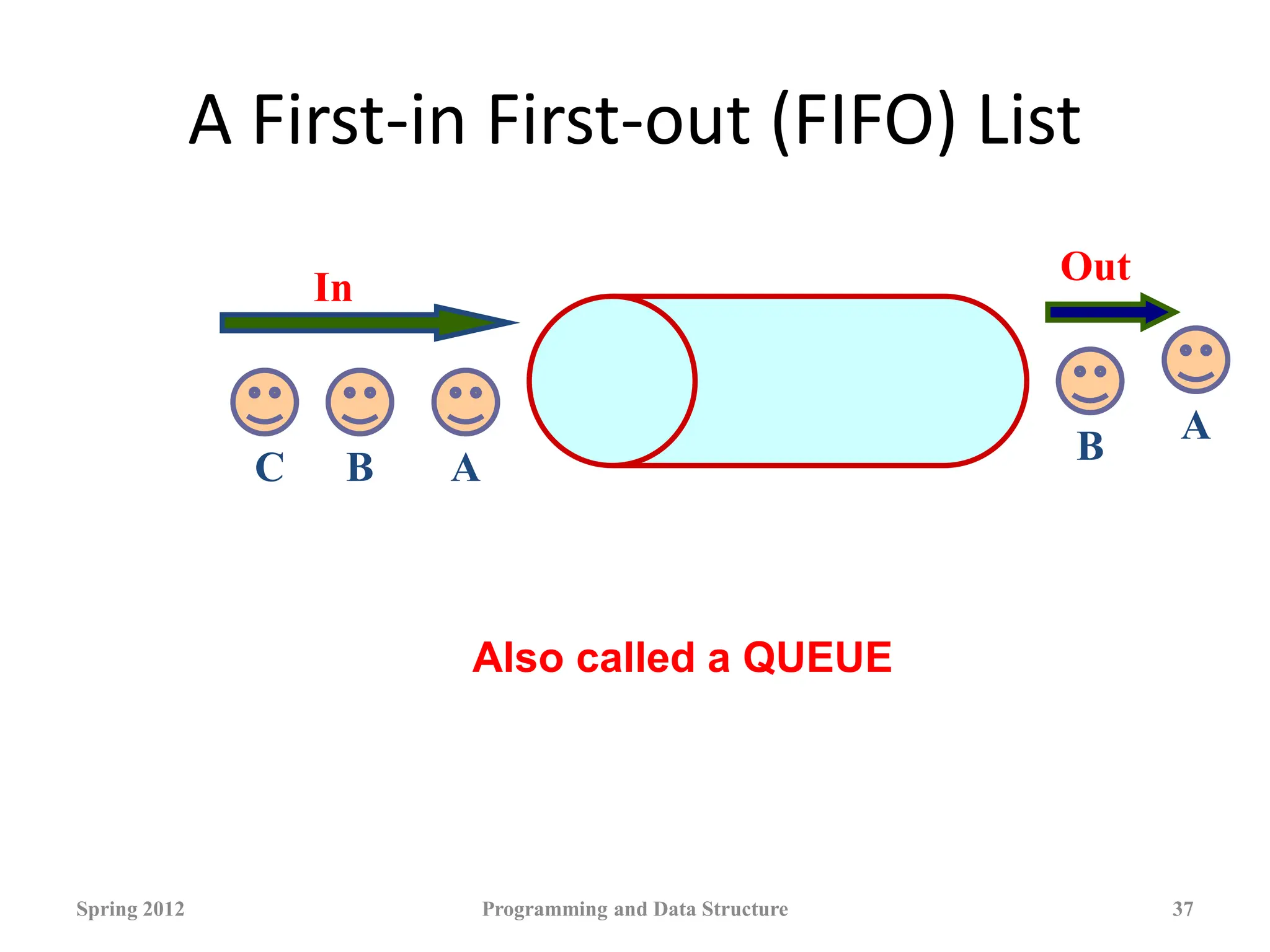
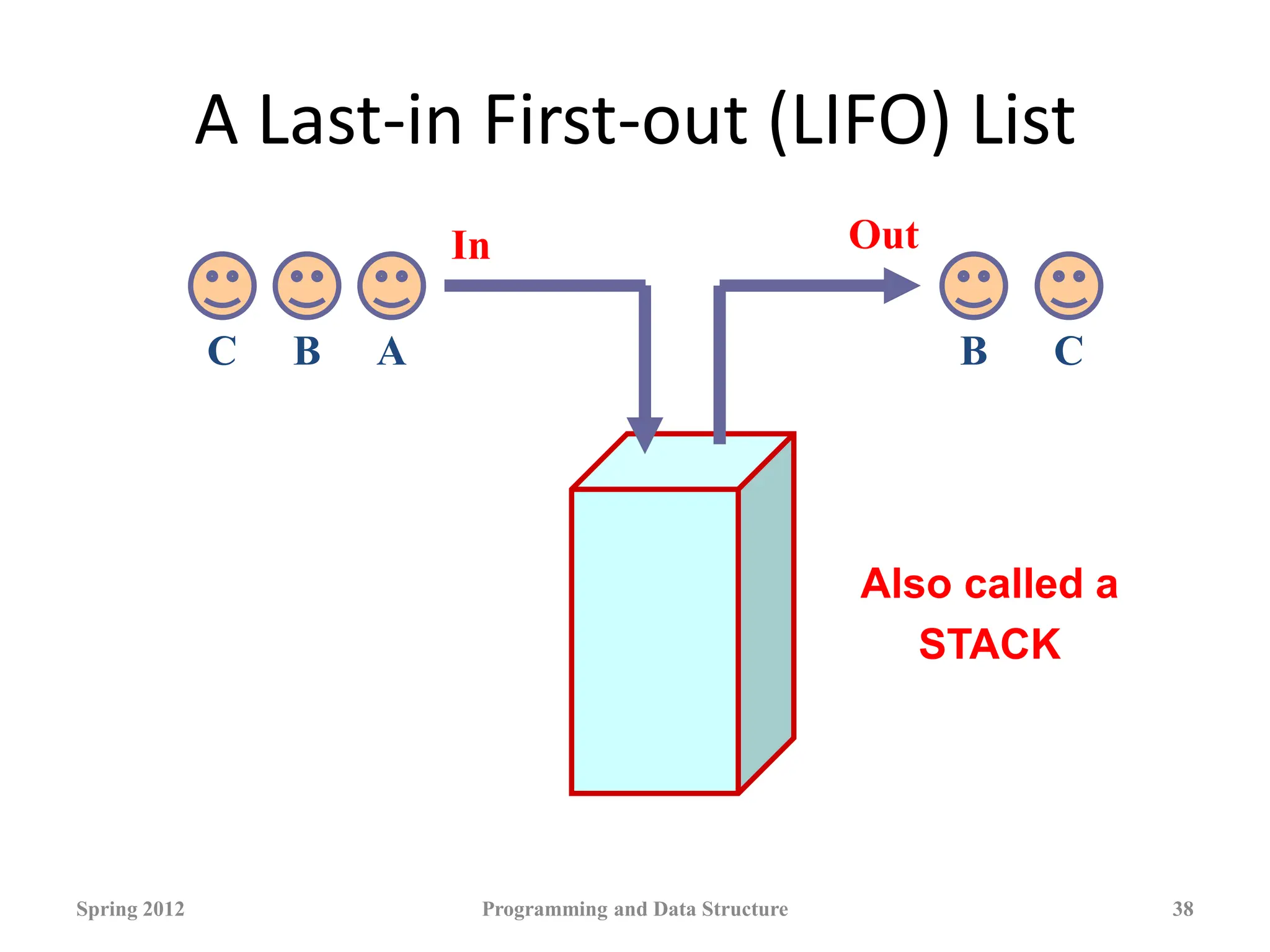
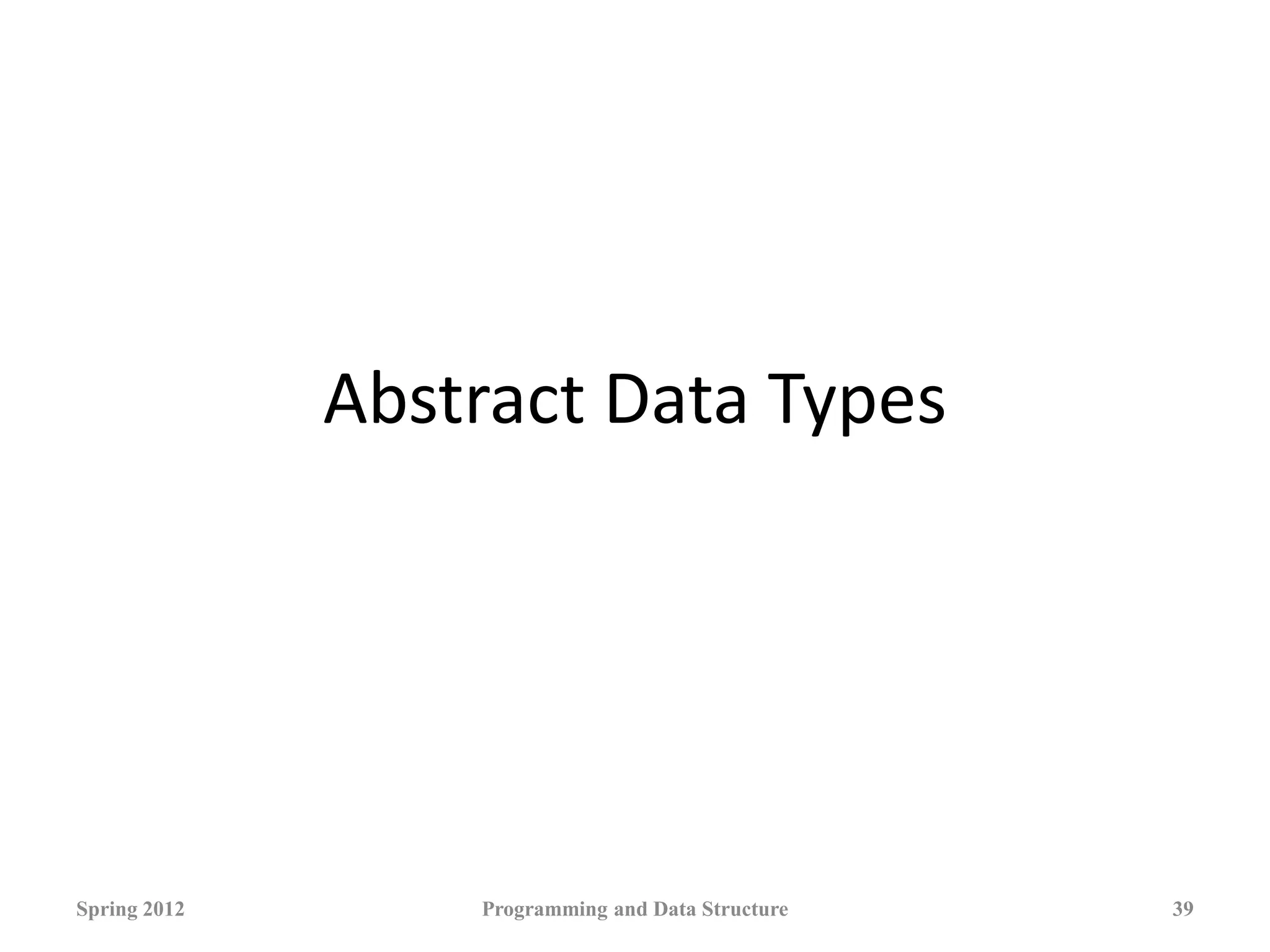
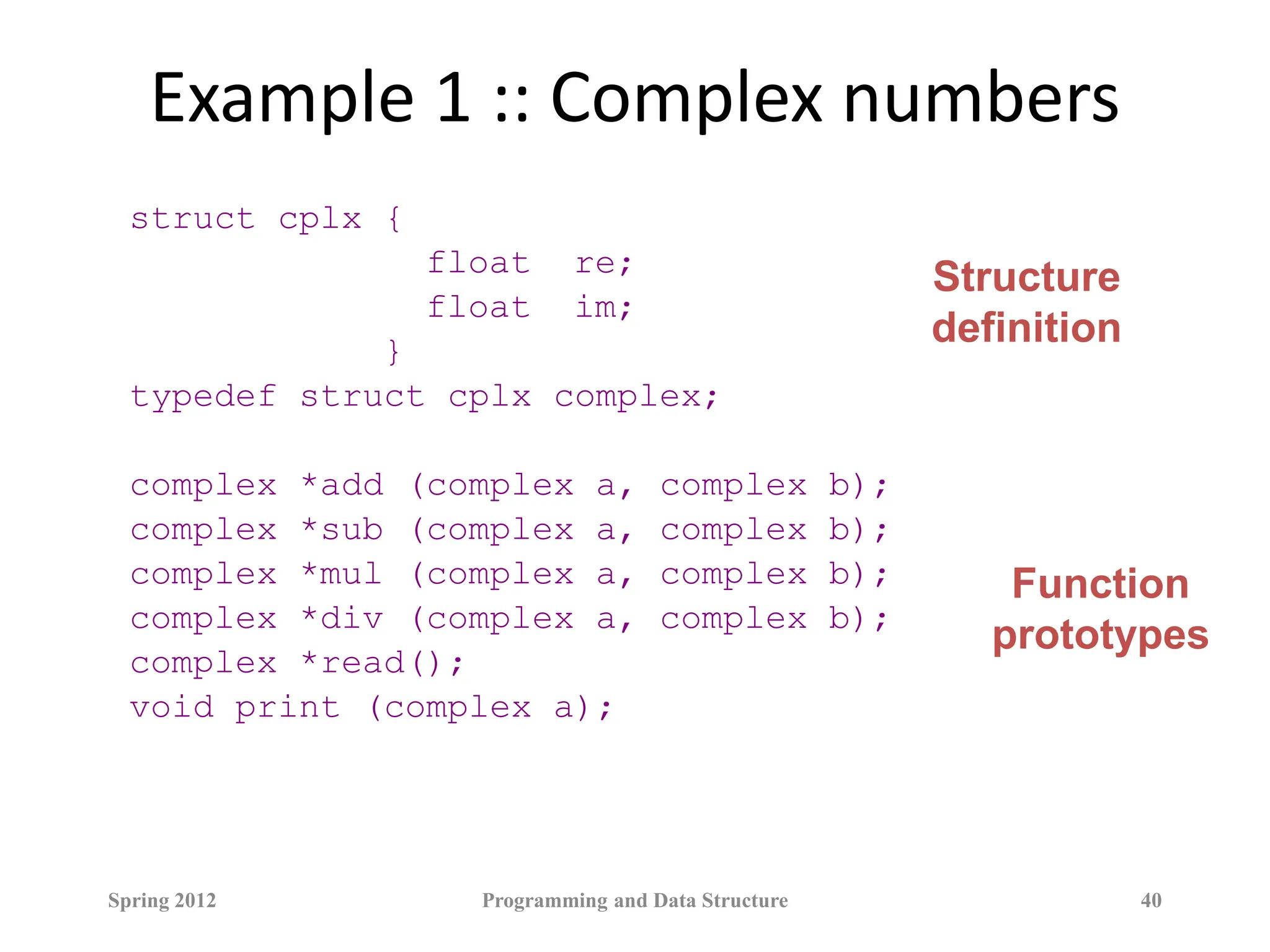
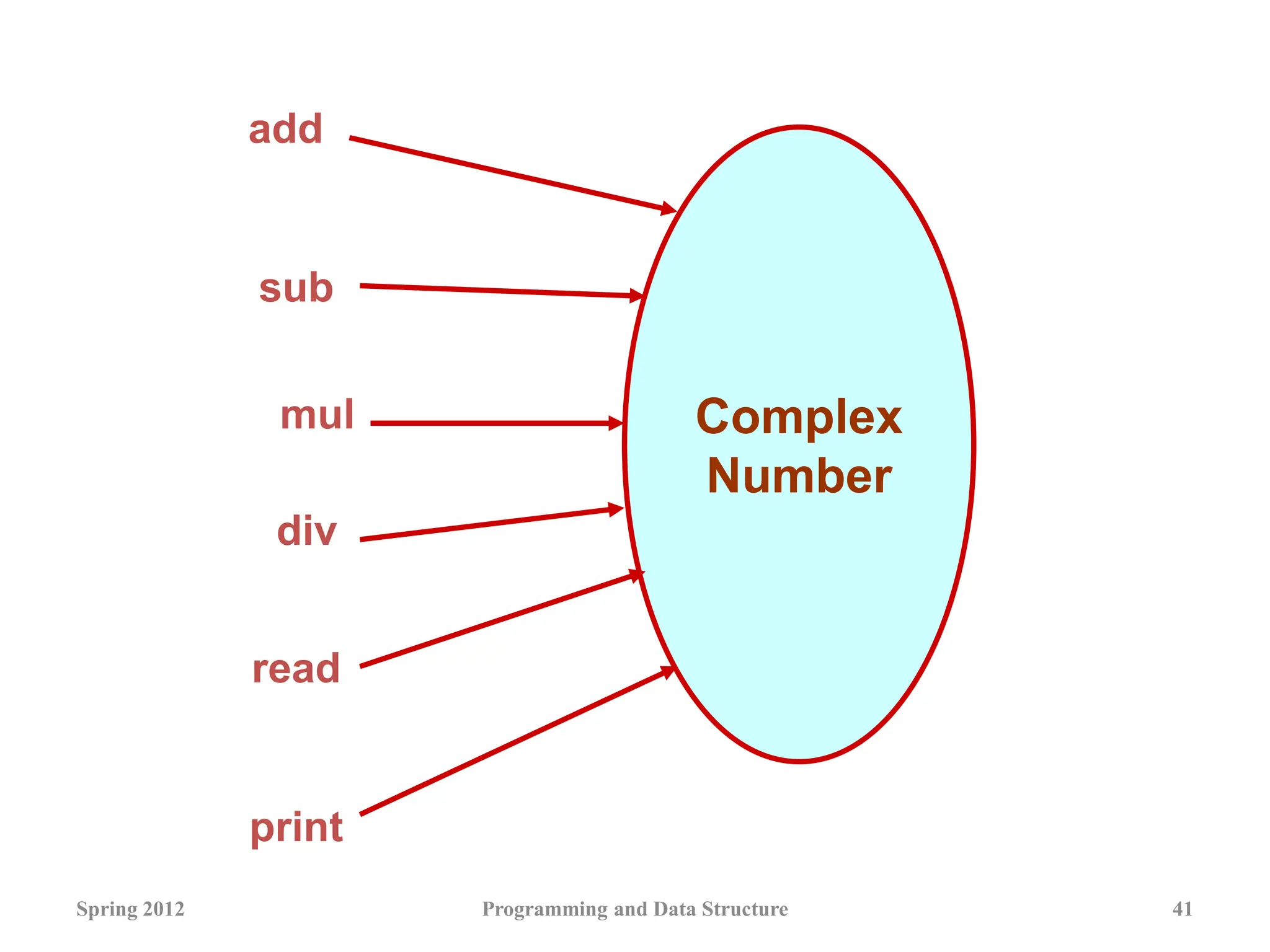

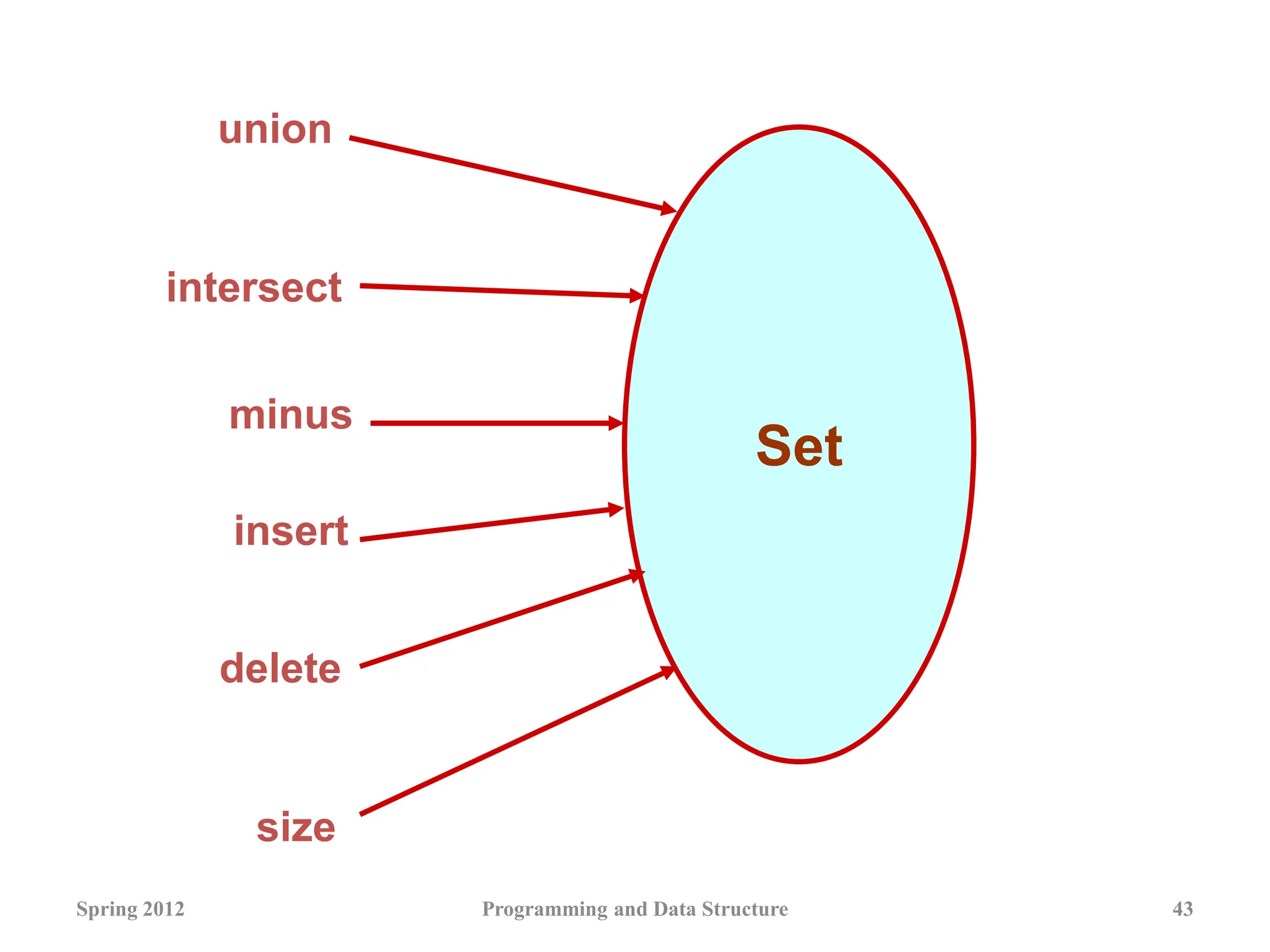
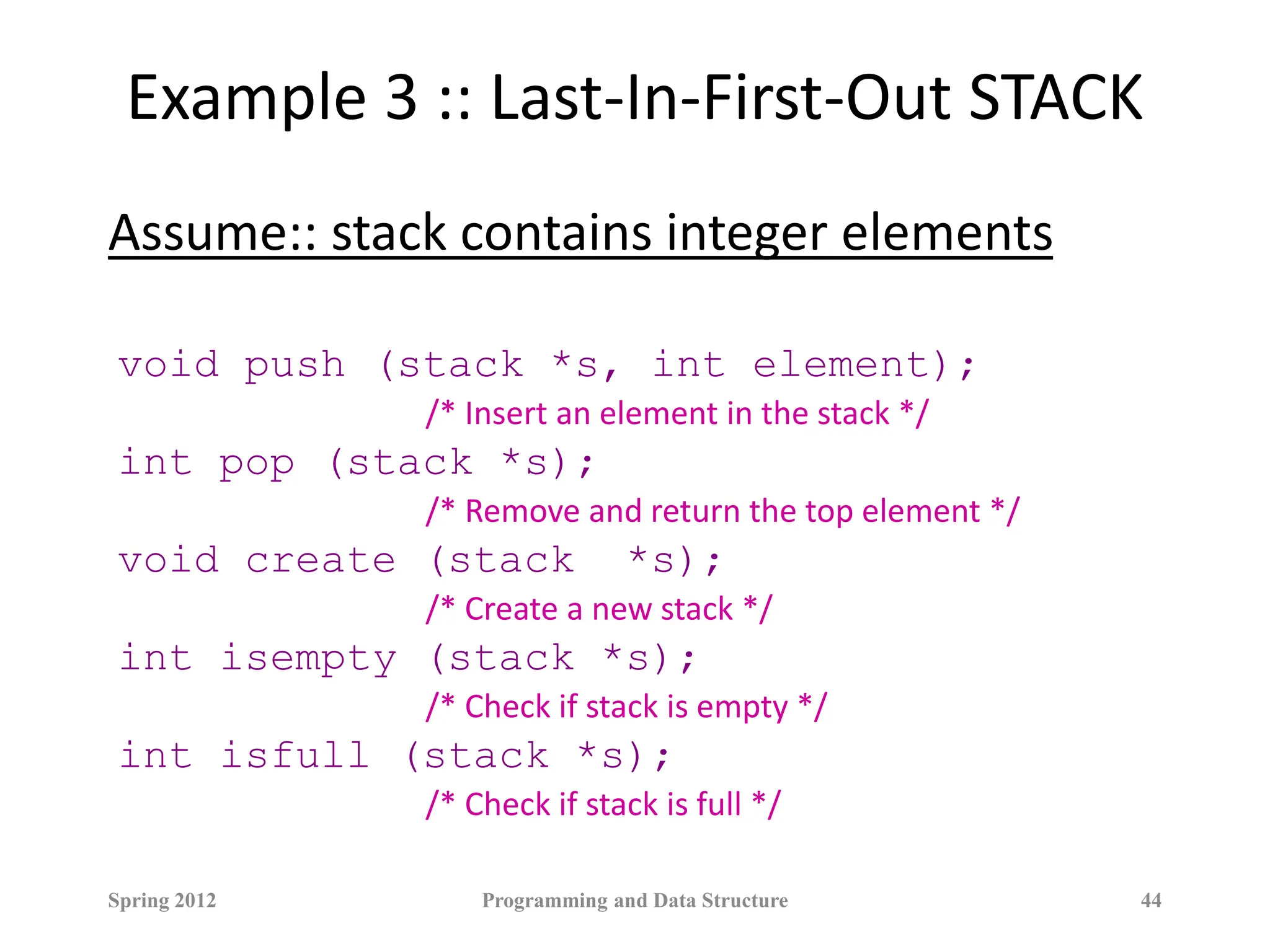
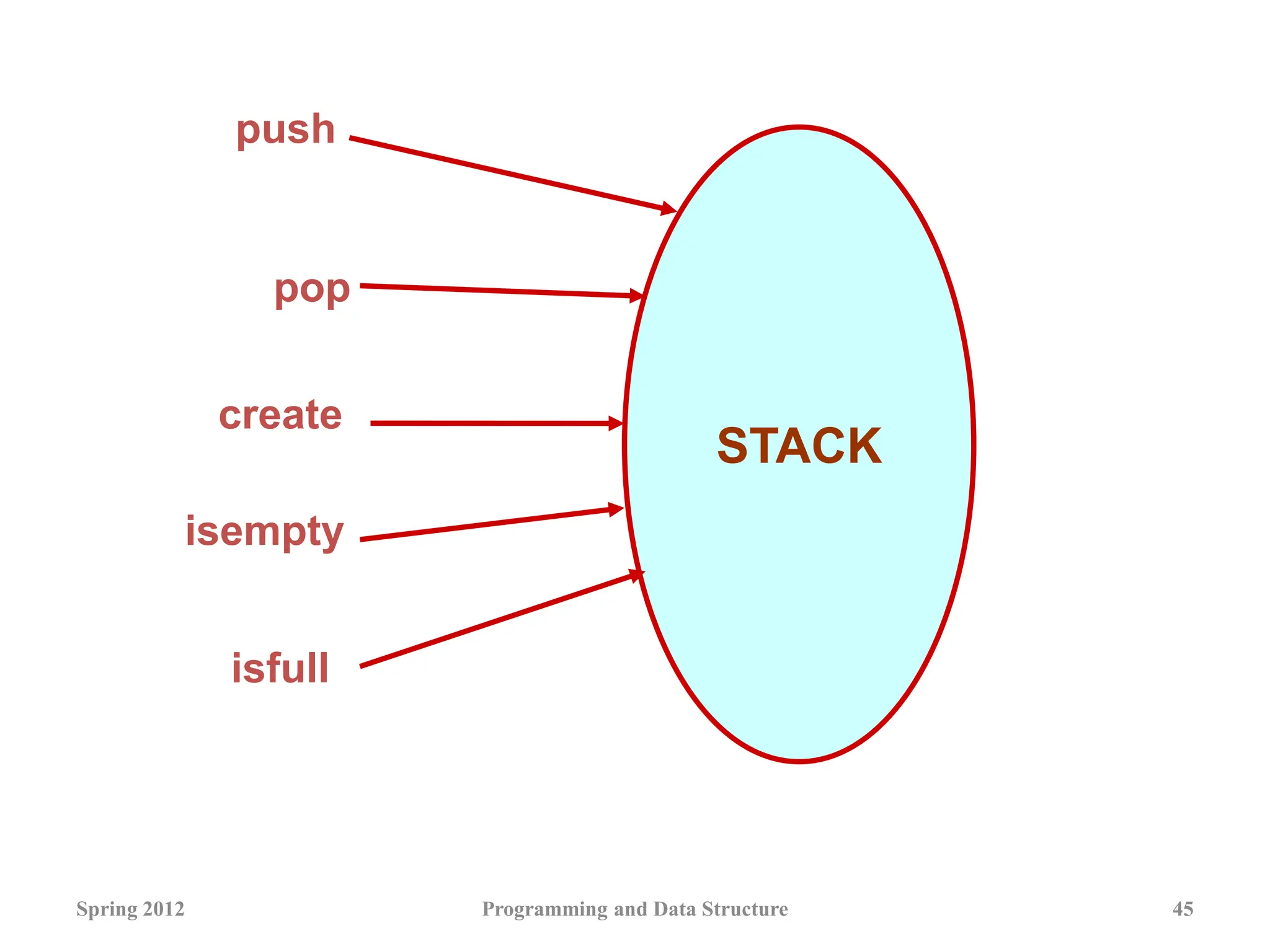
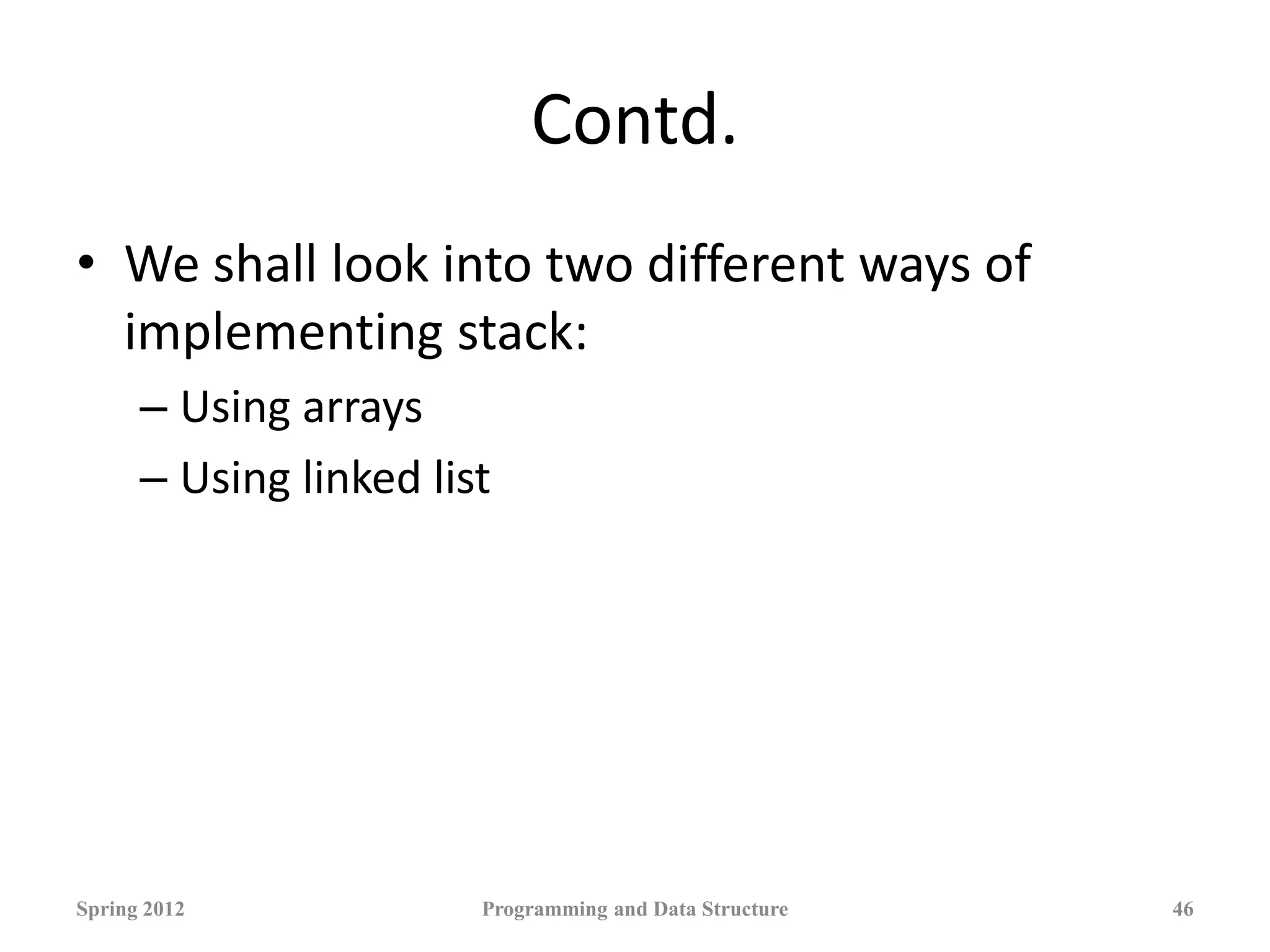

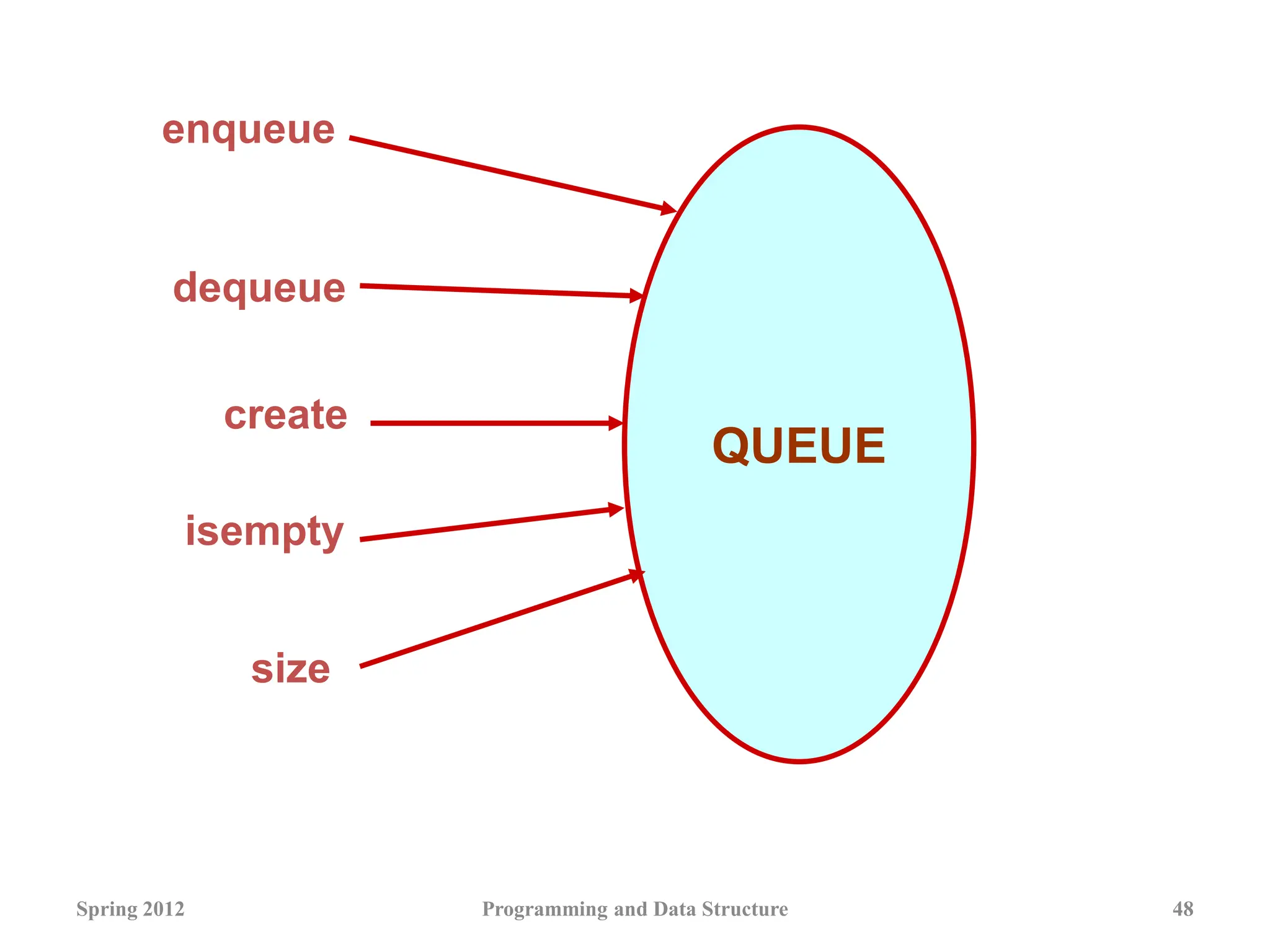
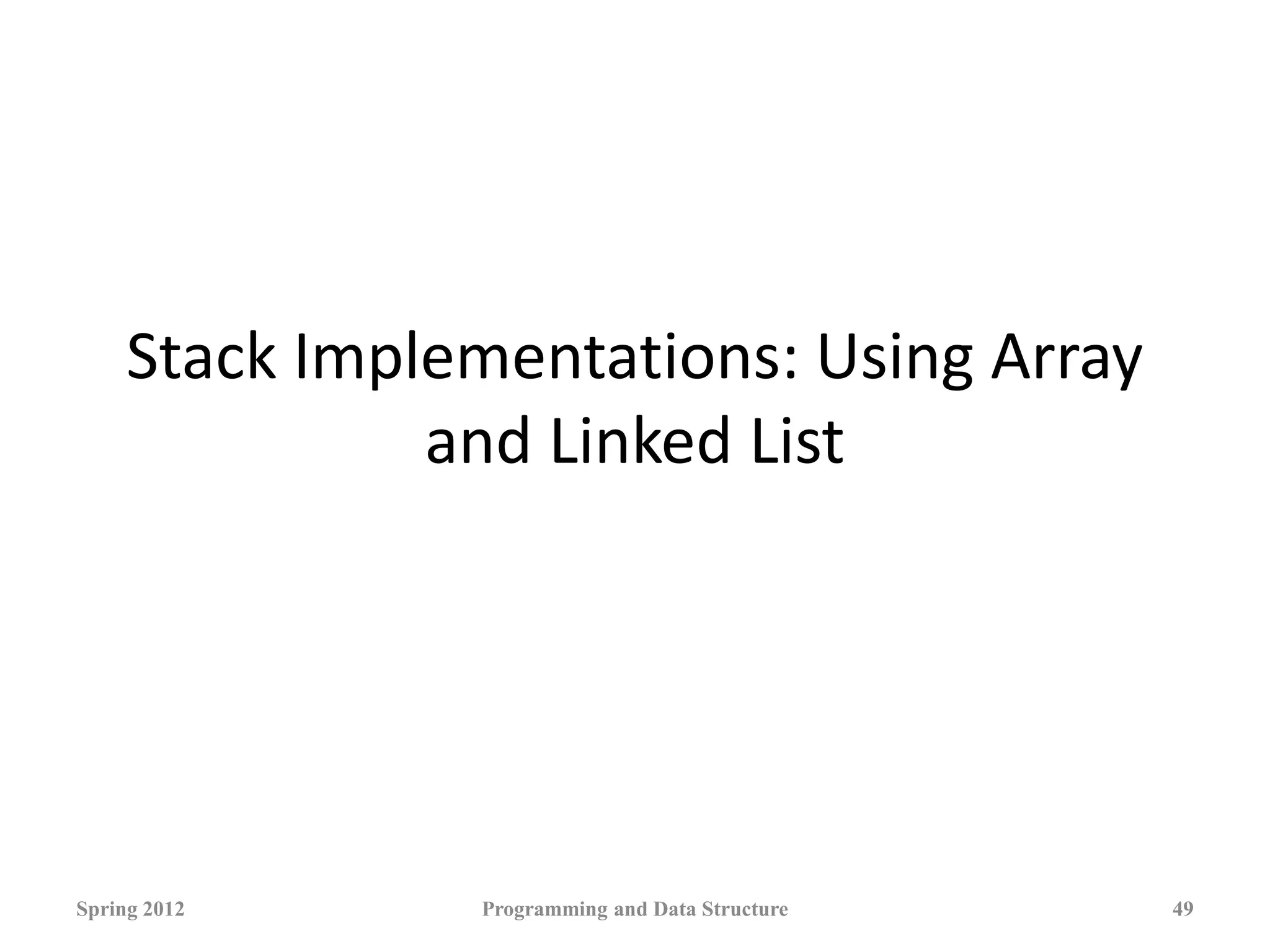
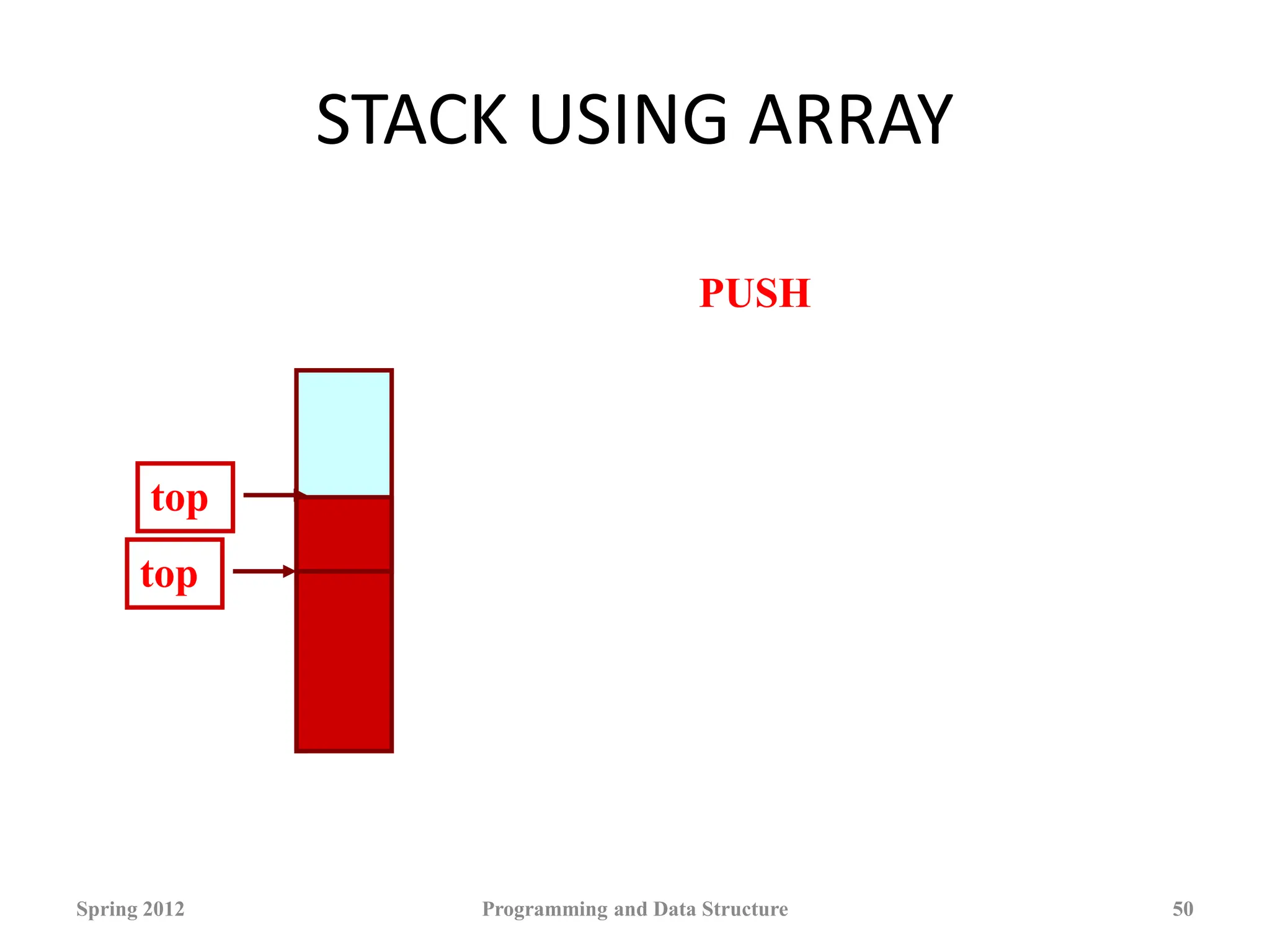
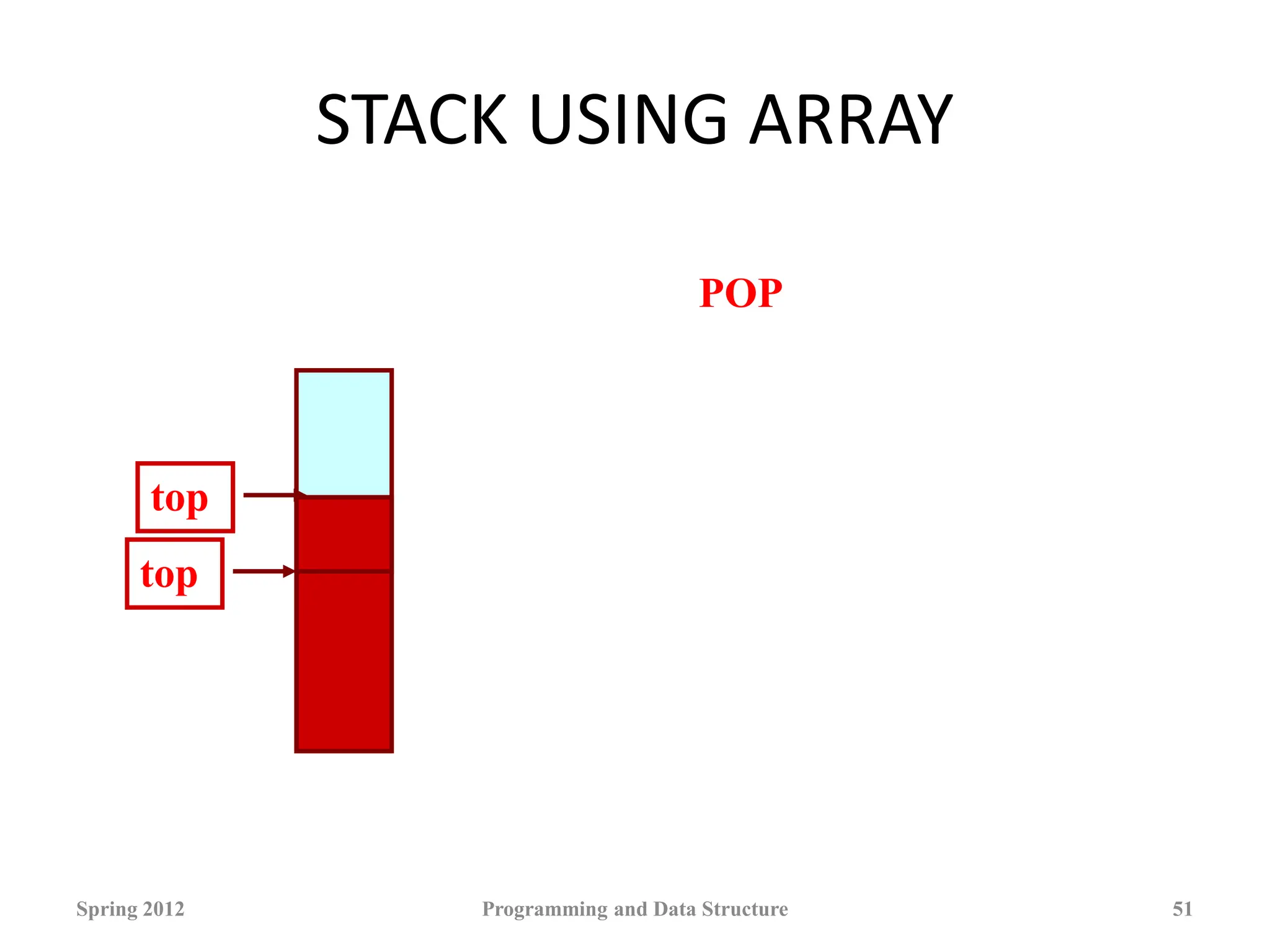

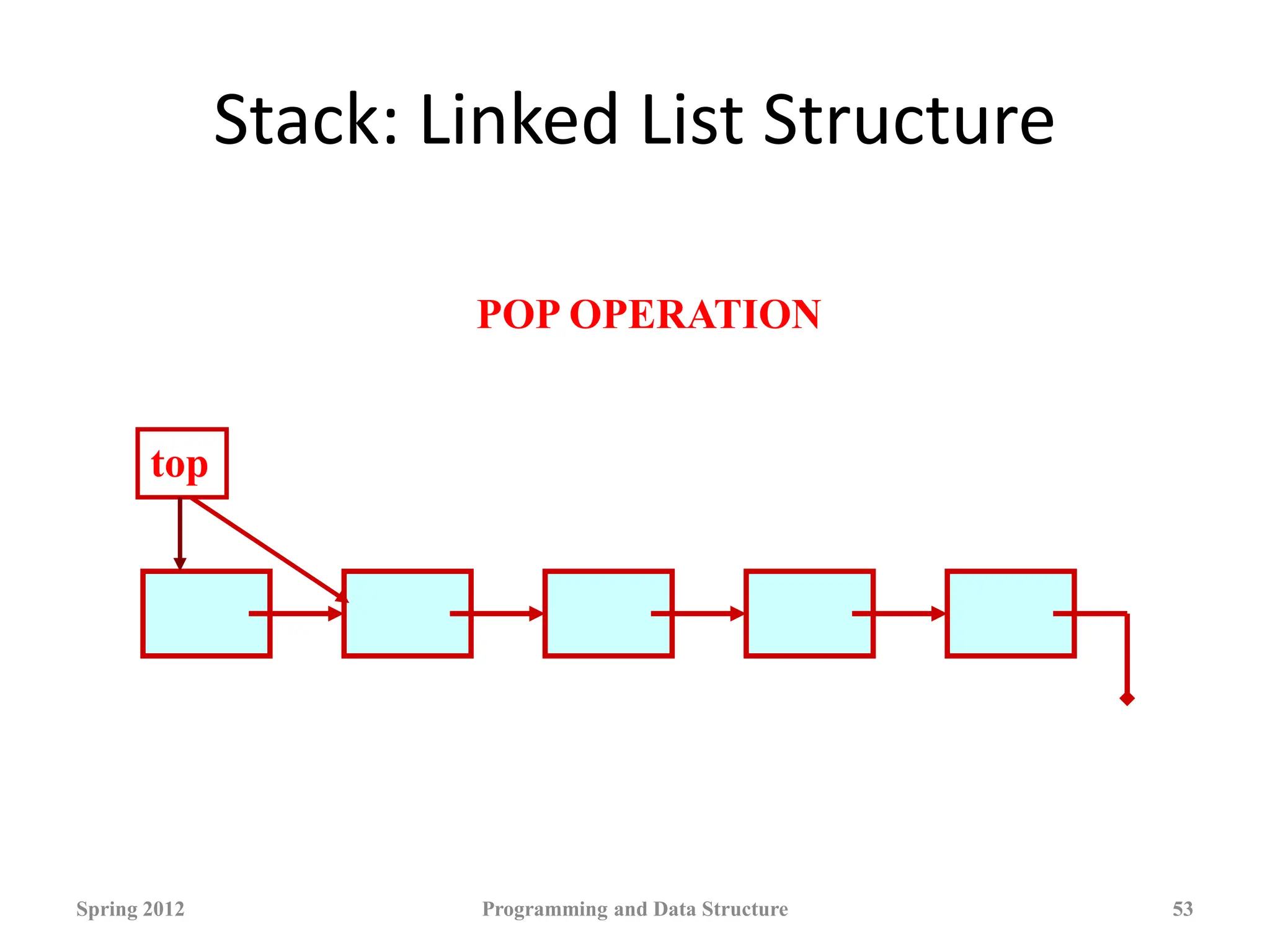

![Declaration
#define MAXSIZE 100
struct lifo
{
int st[MAXSIZE];
int top;
};
typedef struct lifo
stack;
stack s;
struct lifo
{
int value;
struct lifo *next;
};
typedef struct lifo
stack;
stack *top;
Spring 2012 Programming and Data Structure 56
ARRAY LINKED LIST](https://image.slidesharecdn.com/wk11-linkedlist-240122110853-9cf73267/75/Wk11-linkedlist-ppt-55-2048.jpg)
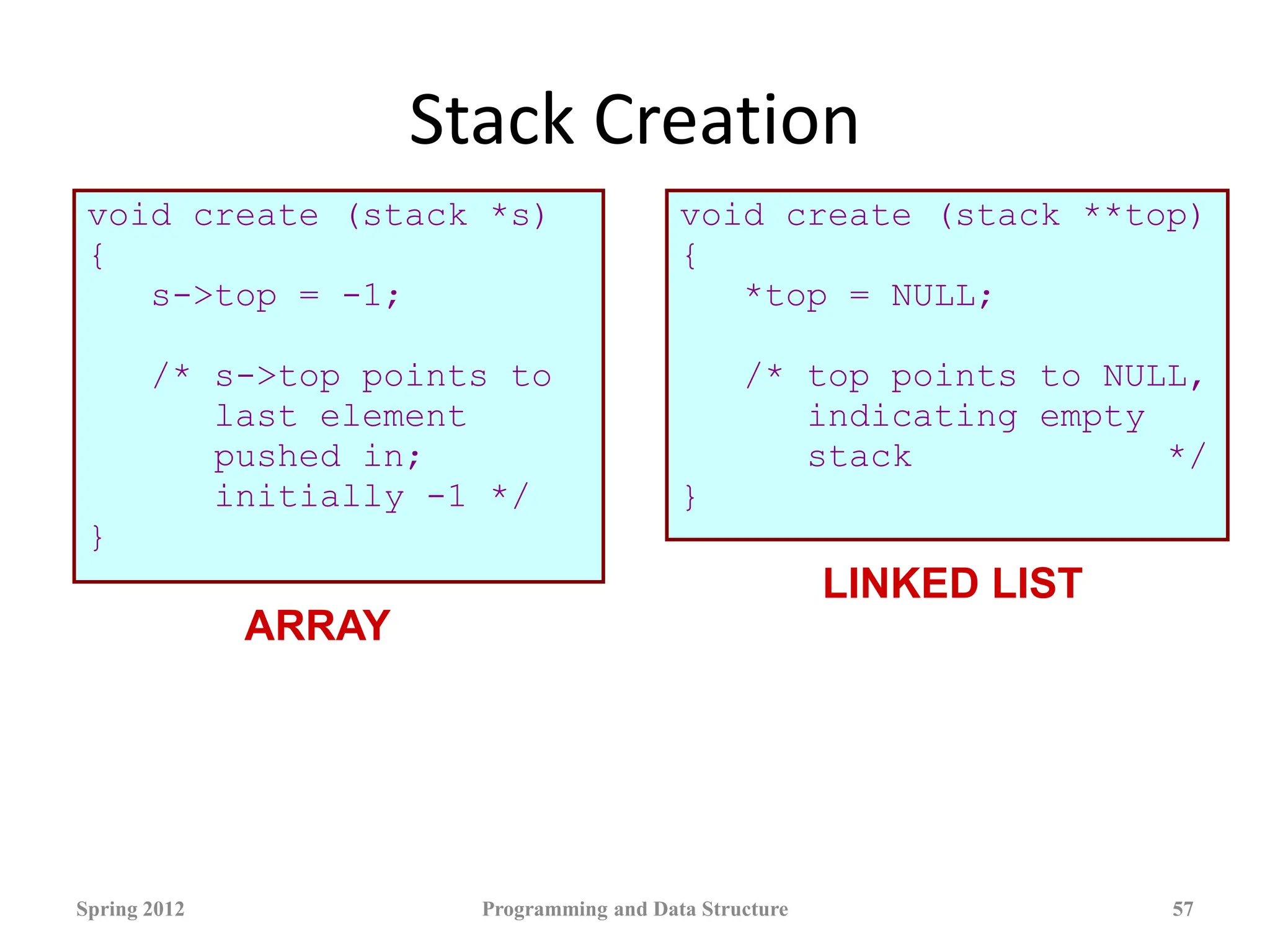
![Pushing an element into the stack
void push (stack *s, int element)
{
if (s->top == (MAXSIZE-1))
{
printf (“n Stack overflow”);
exit(-1);
}
else
{
s->top ++;
s->st[s->top] = element;
}
}
Spring 2012 Programming and Data Structure 58
ARRAY](https://image.slidesharecdn.com/wk11-linkedlist-240122110853-9cf73267/75/Wk11-linkedlist-ppt-57-2048.jpg)
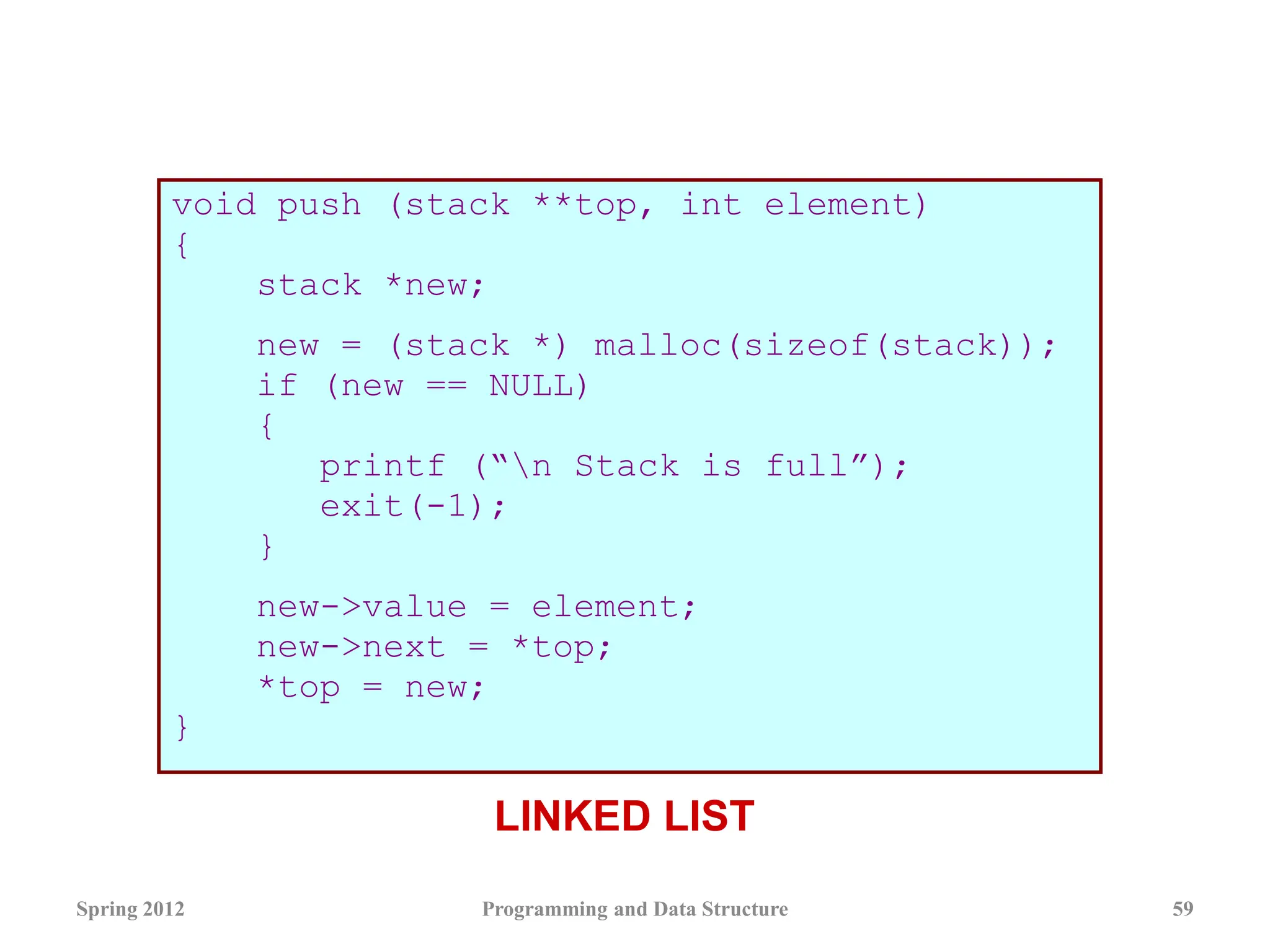
![Popping an element from the stack
int pop (stack *s)
{
if (s->top == -1)
{
printf (“n Stack underflow”);
exit(-1);
}
else
{
return (s->st[s->top--]);
}
}
Spring 2012 Programming and Data Structure 60
ARRAY](https://image.slidesharecdn.com/wk11-linkedlist-240122110853-9cf73267/75/Wk11-linkedlist-ppt-59-2048.jpg)
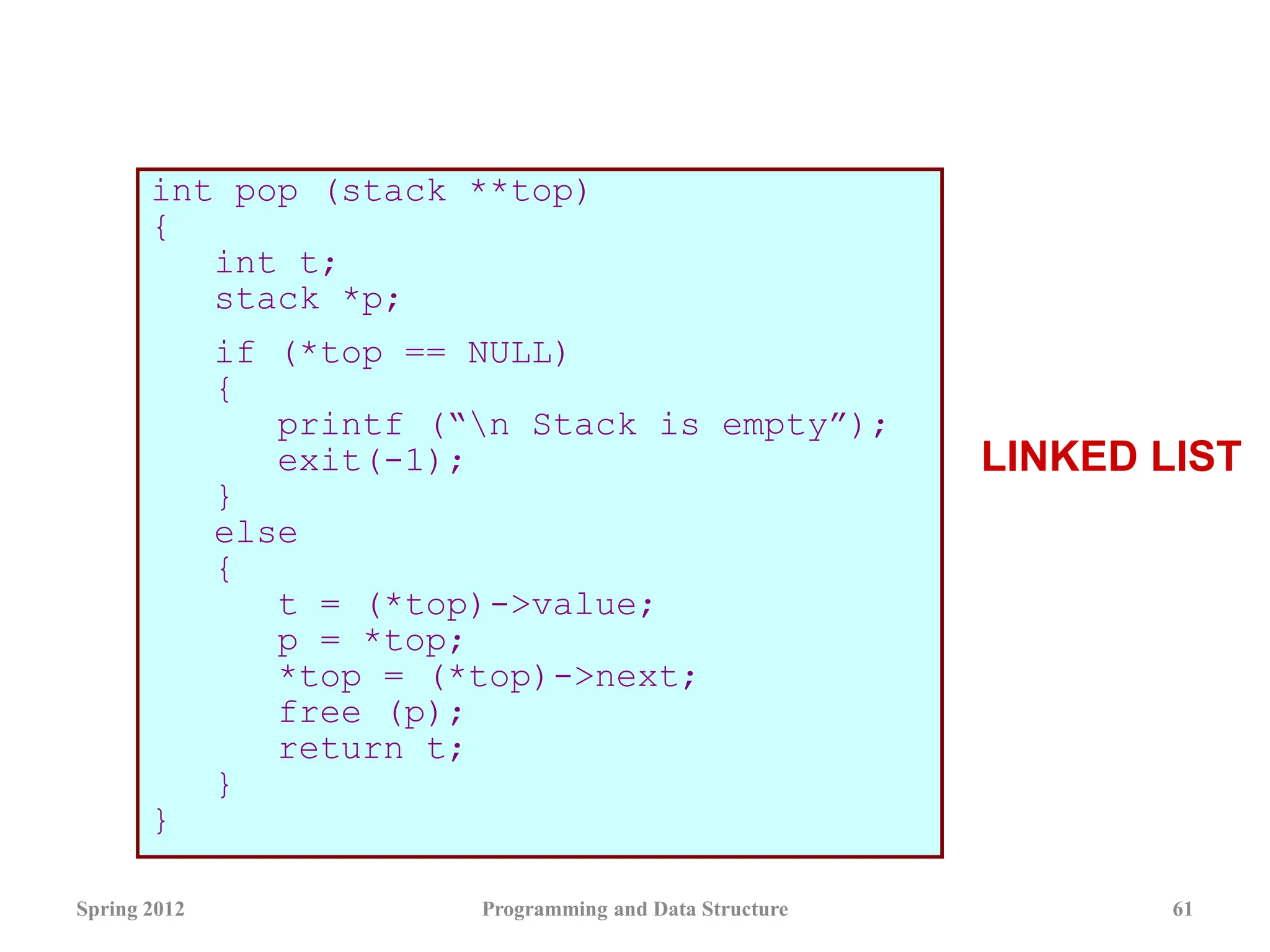
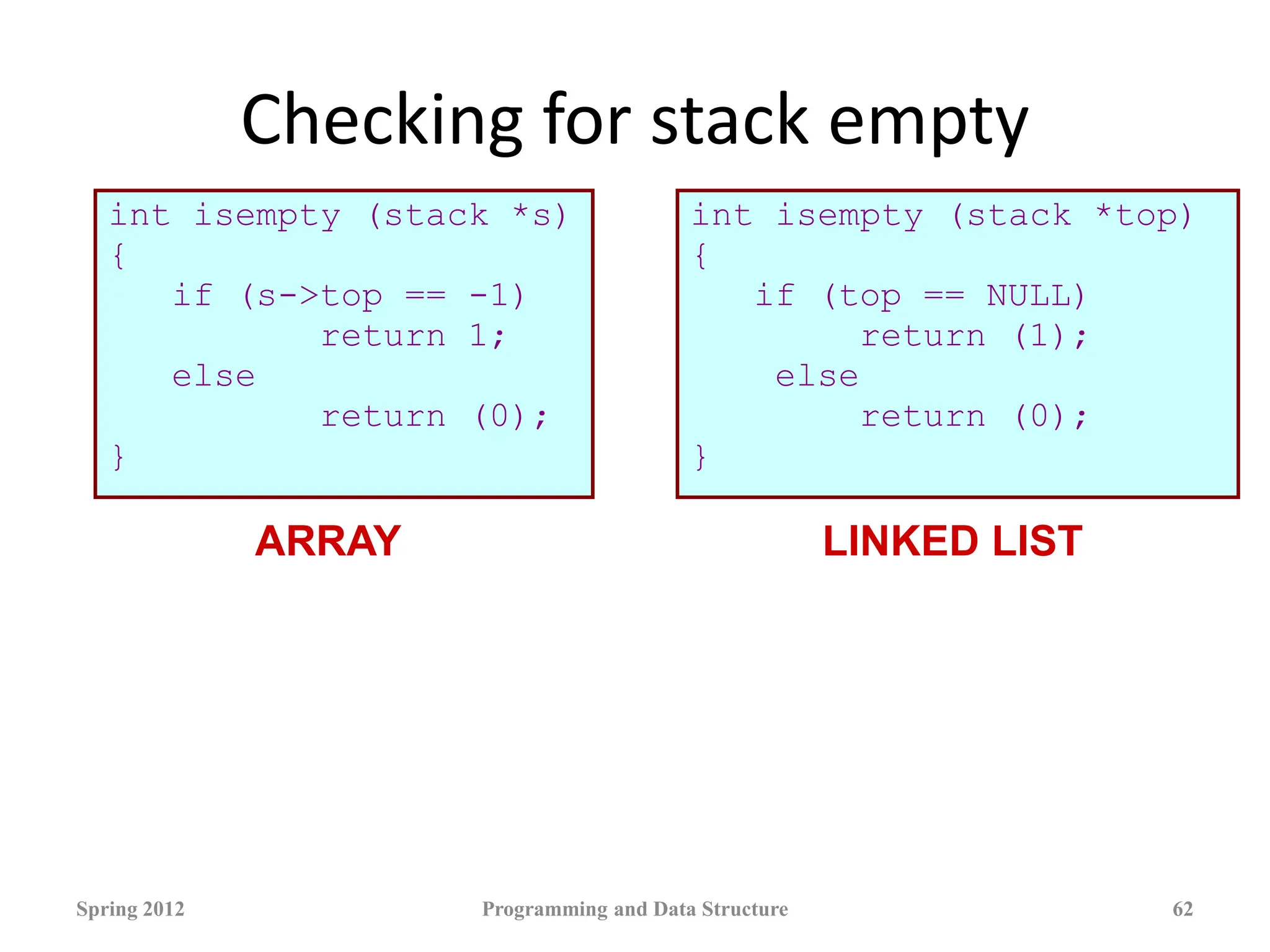
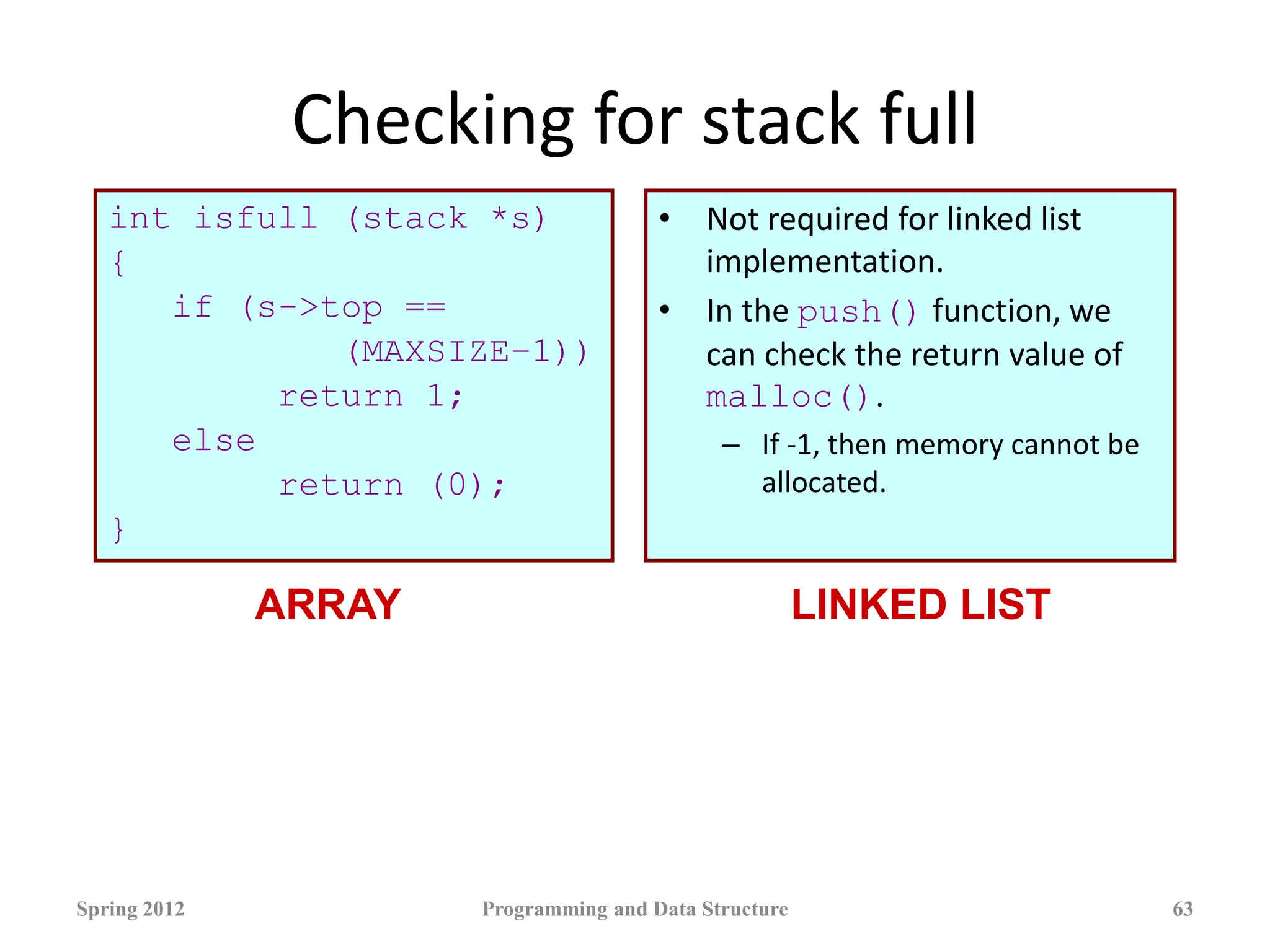
![Example main function :: array
#include <stdio.h>
#define MAXSIZE 100
struct lifo
{
int st[MAXSIZE];
int top;
};
typedef struct lifo stack;
main()
{
stack A, B;
create(&A); create(&B);
push(&A,10);
push(&A,20);
push(&A,30);
push(&B,100); push(&B,5);
printf (“%d %d”, pop(&A),
pop(&B));
push (&A, pop(&B));
if (isempty(&B))
printf (“n B is empty”);
}
Spring 2012 Programming and Data Structure 64](https://image.slidesharecdn.com/wk11-linkedlist-240122110853-9cf73267/75/Wk11-linkedlist-ppt-63-2048.jpg)
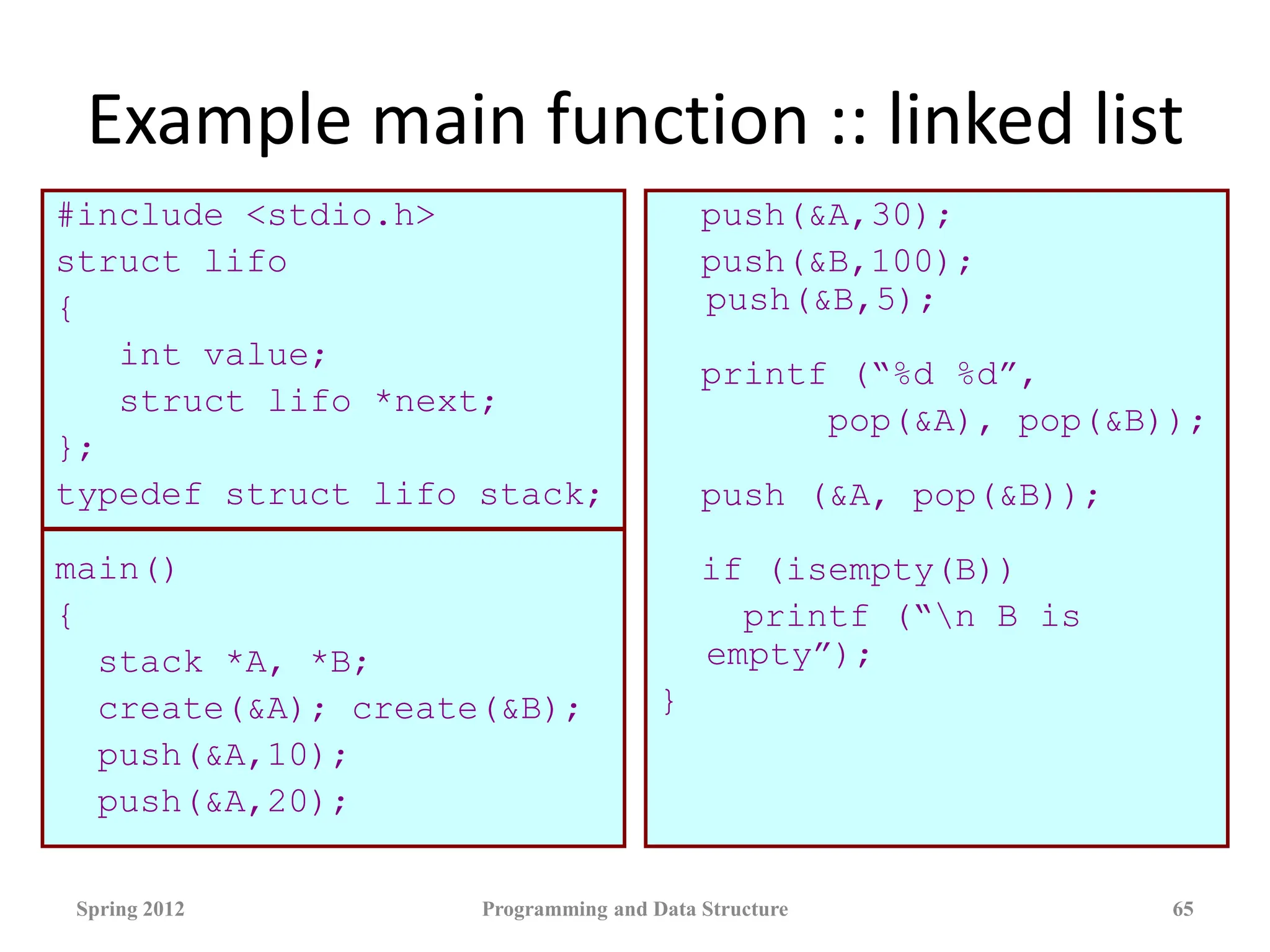
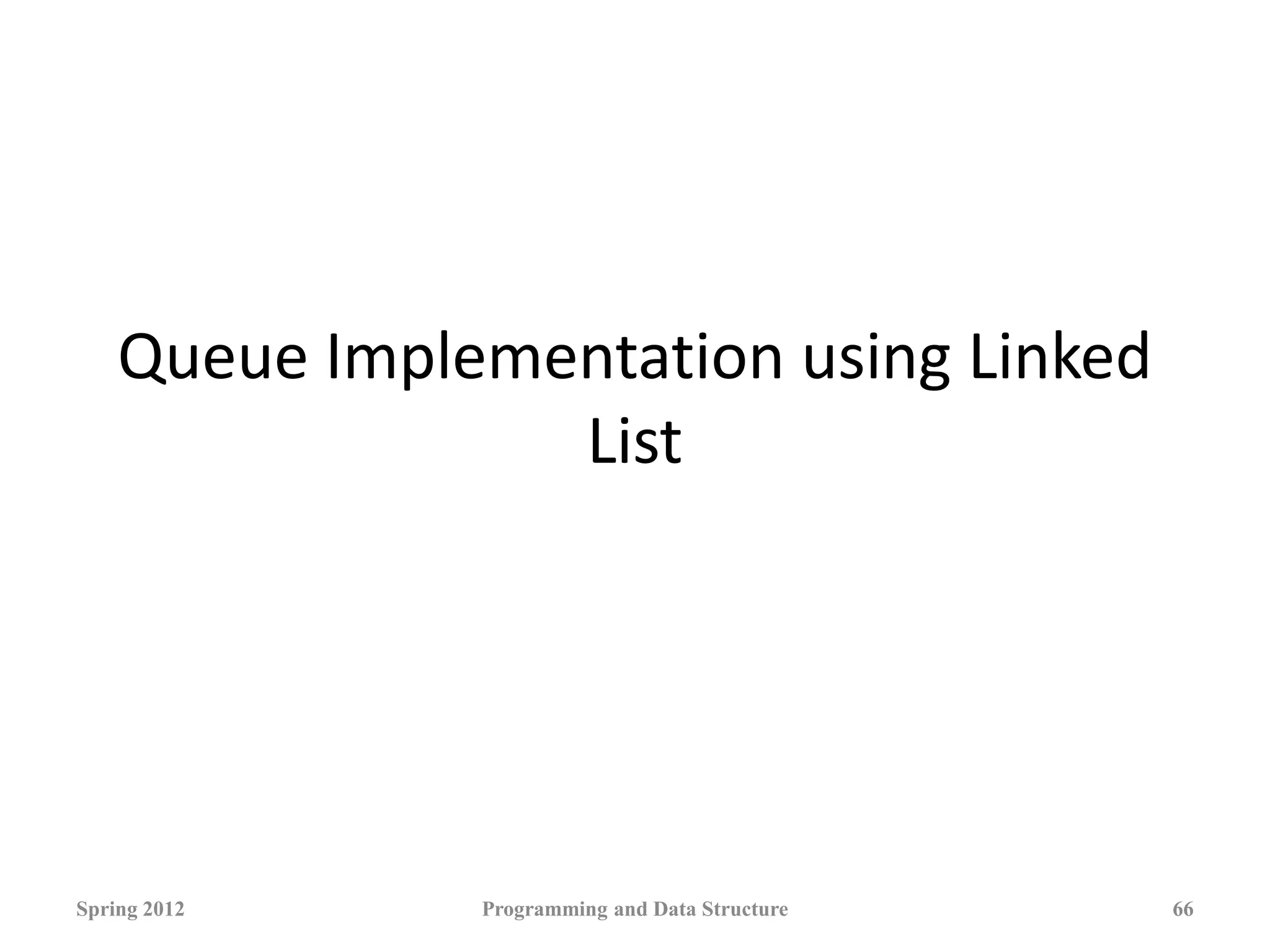
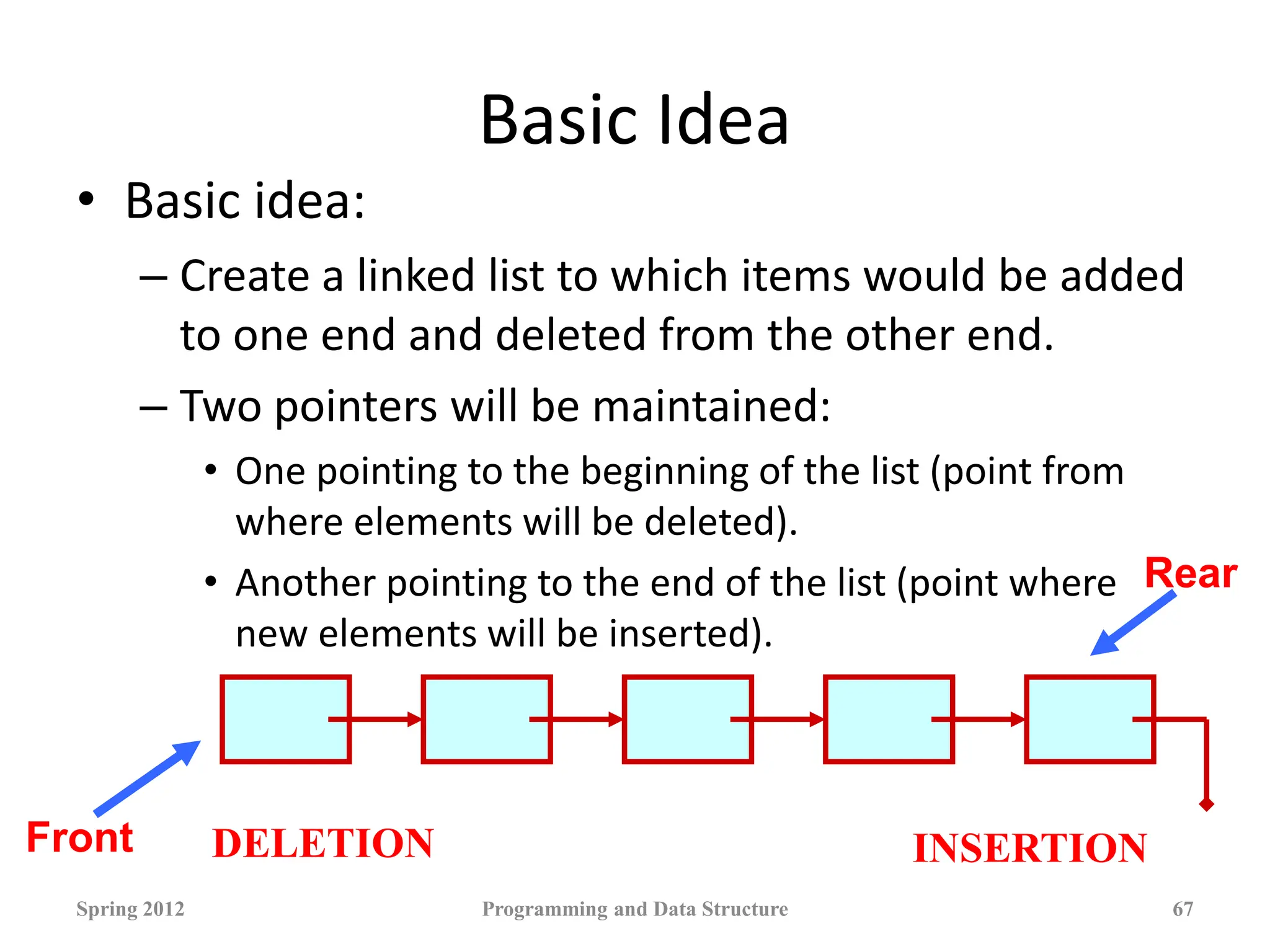
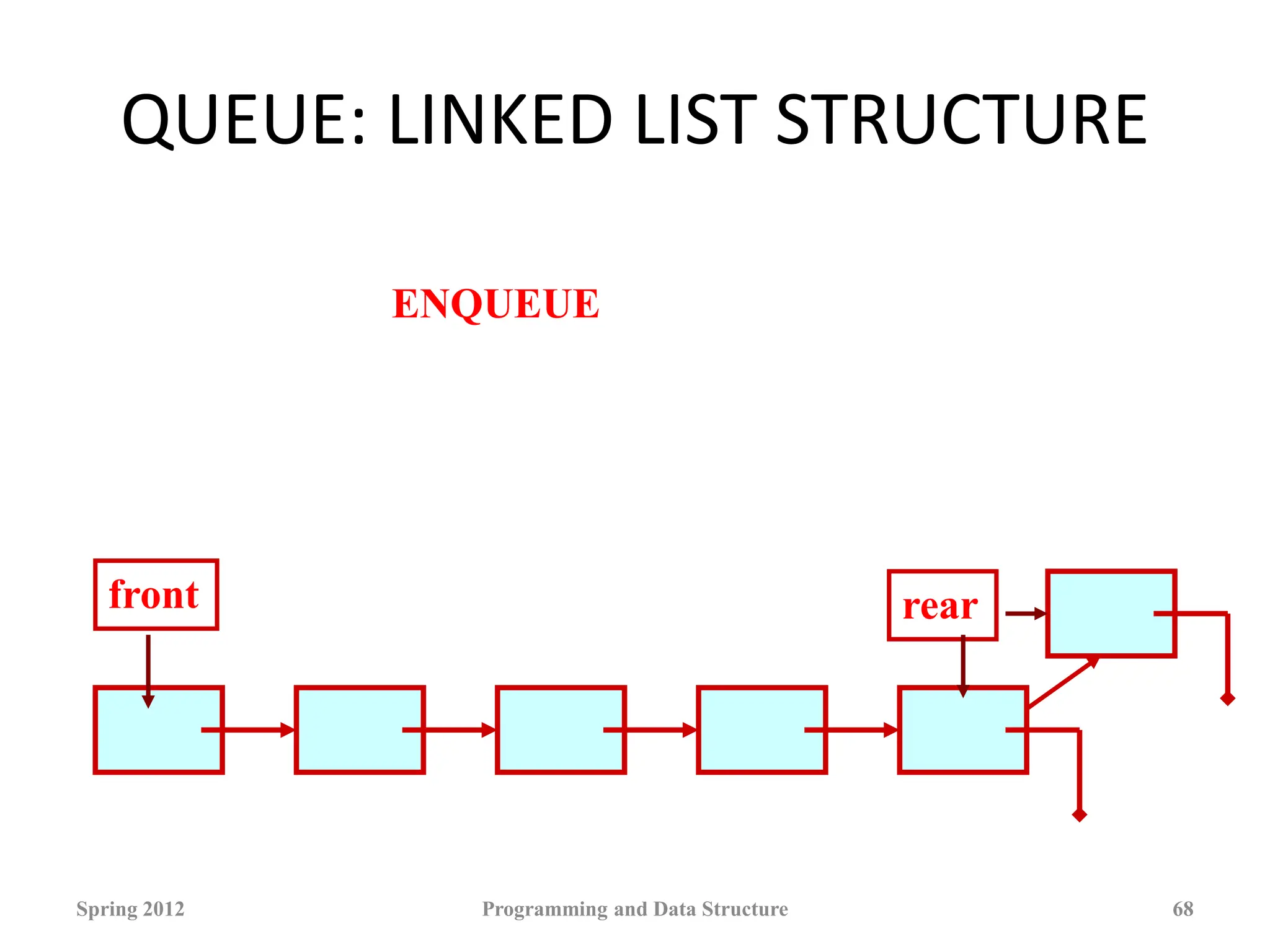
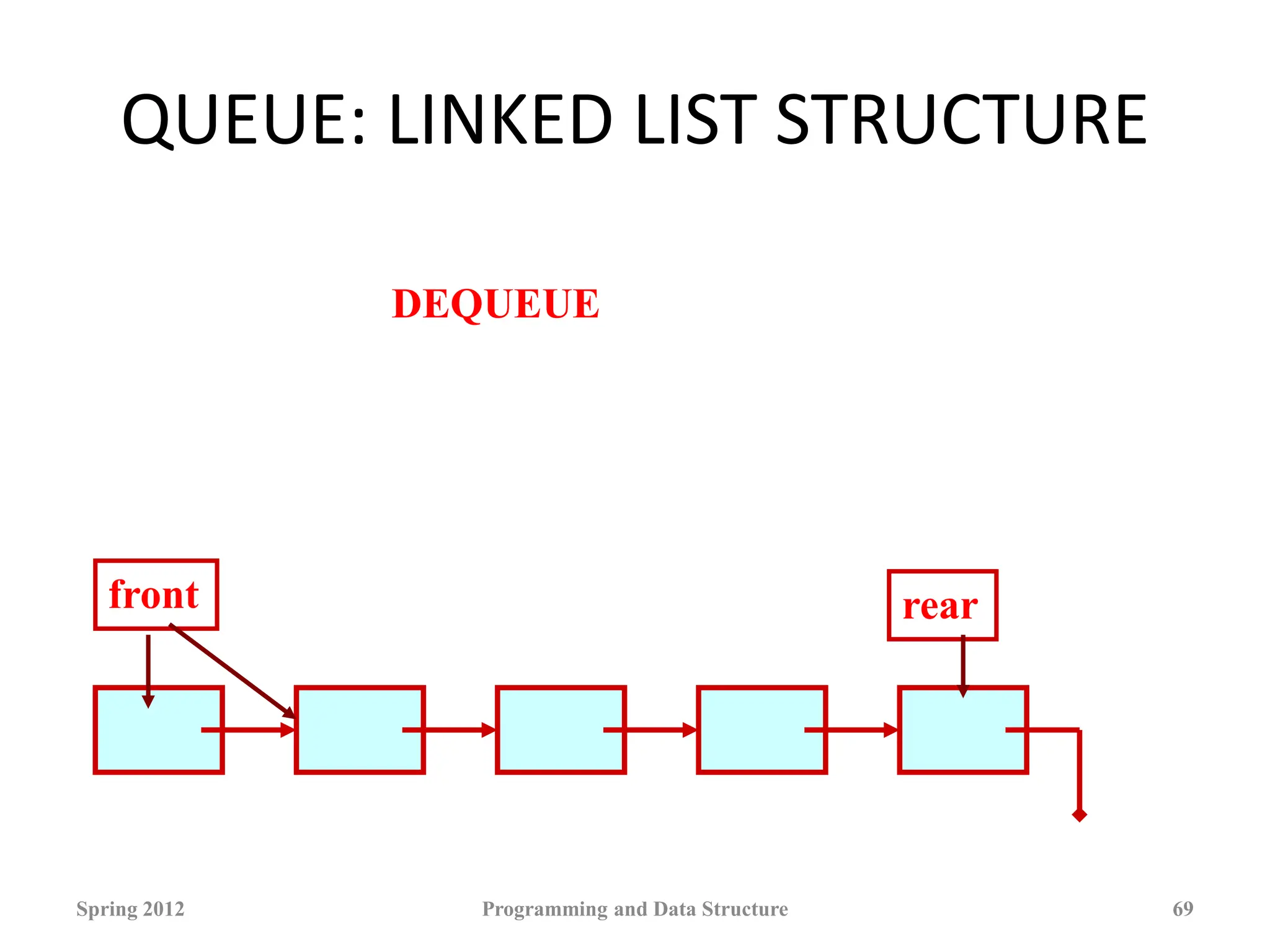
![QUEUE using Linked List
Spring 2012 Programming and Data Structure 70
#include <stdio.h>
#include <stdlib.h>
#include <string.h>
struct node{
char name[30];
struct node *next;
};
typedef struct node _QNODE;
typedef struct {
_QNODE *queue_front, *queue_rear;
} _QUEUE;](https://image.slidesharecdn.com/wk11-linkedlist-240122110853-9cf73267/75/Wk11-linkedlist-ppt-69-2048.jpg)
![Spring 2012 Programming and Data Structure 71
_QNODE *enqueue (_QUEUE *q, char x[])
{
_QNODE *temp;
temp= (_QNODE *)
malloc (sizeof(_QNODE));
if (temp==NULL){
printf(“Bad allocation n");
return NULL;
}
strcpy(temp->name,x);
temp->next=NULL;
if(q->queue_rear==NULL)
{
q->queue_rear=temp;
q->queue_front=
q->queue_rear;
}
else
{
q->queue_rear->next=temp;
q->queue_rear=temp;
}
return(q->queue_rear);
}](https://image.slidesharecdn.com/wk11-linkedlist-240122110853-9cf73267/75/Wk11-linkedlist-ppt-70-2048.jpg)
![Spring 2012 Programming and Data Structure 72
char *dequeue(_QUEUE *q,char x[])
{
_QNODE *temp_pnt;
if(q->queue_front==NULL){
q->queue_rear=NULL;
printf("Queue is empty n");
return(NULL);
}
else{
strcpy(x,q->queue_front->name);
temp_pnt=q->queue_front;
q->queue_front=
q->queue_front->next;
free(temp_pnt);
if(q->queue_front==NULL)
q->queue_rear=NULL;
return(x);
}
}](https://image.slidesharecdn.com/wk11-linkedlist-240122110853-9cf73267/75/Wk11-linkedlist-ppt-71-2048.jpg)
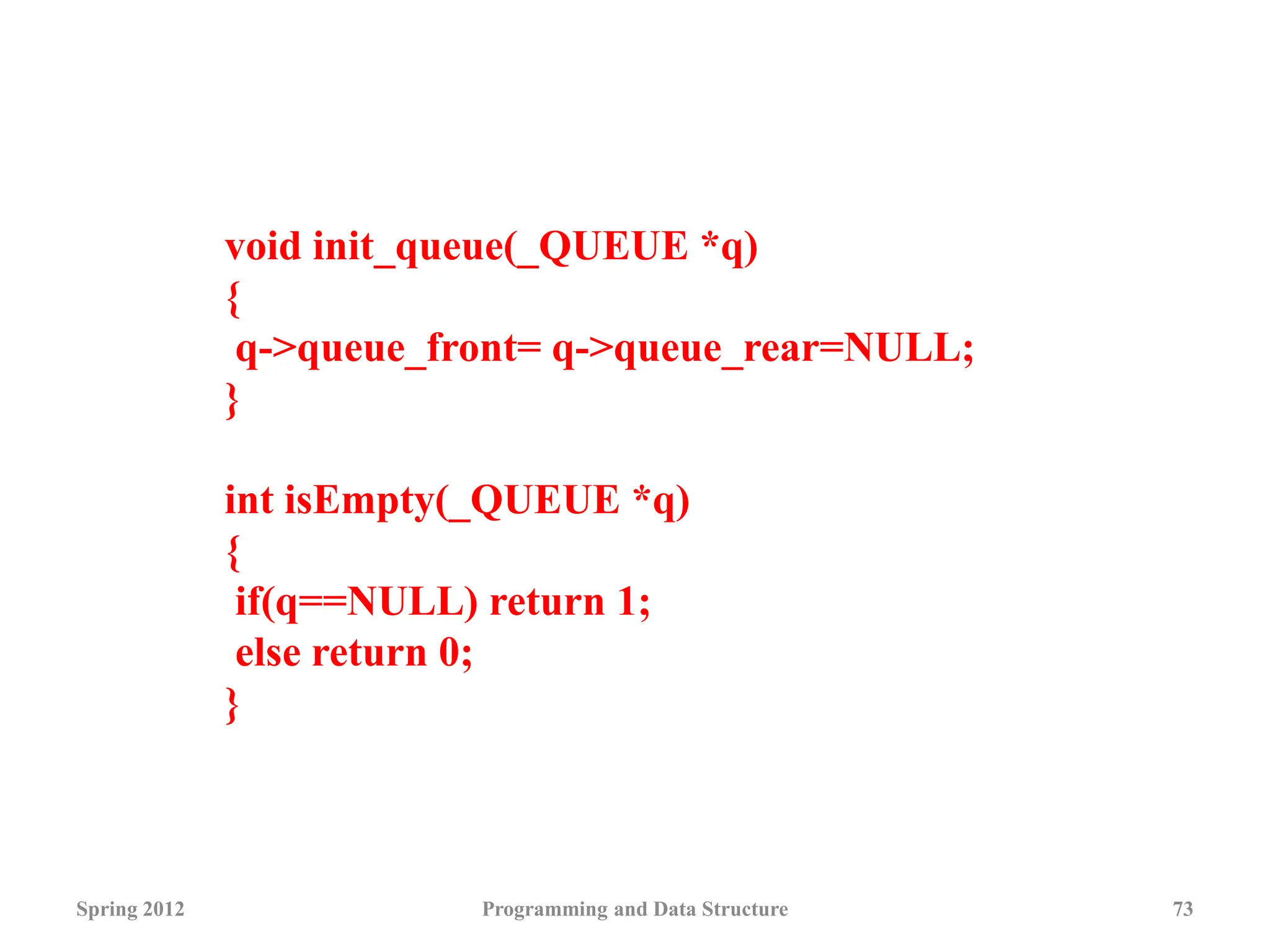
![Spring 2012 Programming and Data Structure 74
main()
{
int i,j;
char command[5],val[30];
_QUEUE q;
init_queue(&q);
command[0]='0';
printf("For entering a name use 'enter <name>'n");
printf("For deleting use 'delete' n");
printf("To end the session use 'bye' n");
while(strcmp(command,"bye")){
scanf("%s",command);](https://image.slidesharecdn.com/wk11-linkedlist-240122110853-9cf73267/75/Wk11-linkedlist-ppt-73-2048.jpg)

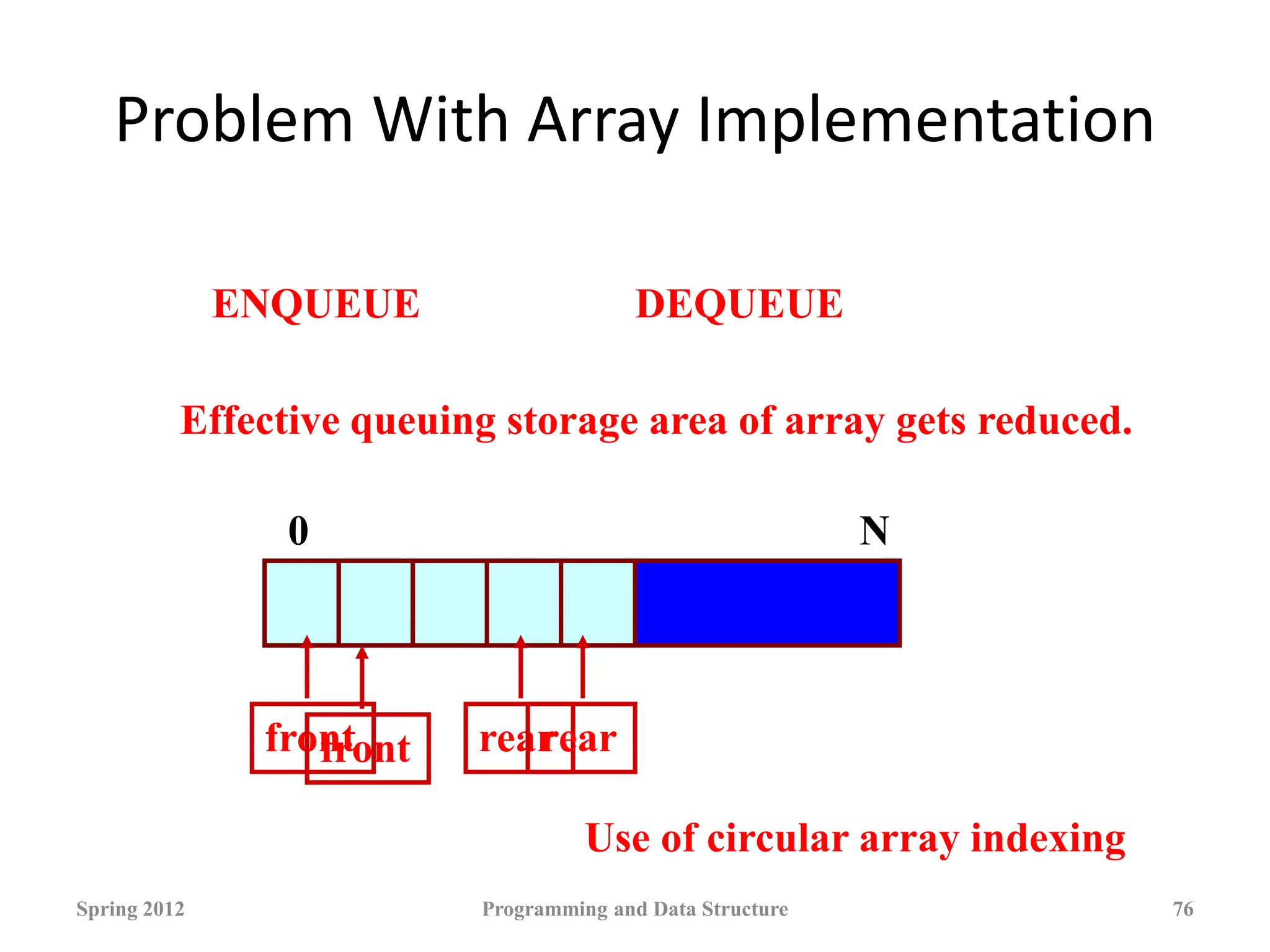
![Queue: Example with Array Implementation
Spring 2012 Programming and Data Structure 77
typedef struct { char name[30];
} _ELEMENT;
typedef struct {
_ELEMENT q_elem[MAX_SIZE];
int rear;
int front;
int full,empty;
} _QUEUE;
#define MAX_SIZE 100](https://image.slidesharecdn.com/wk11-linkedlist-240122110853-9cf73267/75/Wk11-linkedlist-ppt-76-2048.jpg)
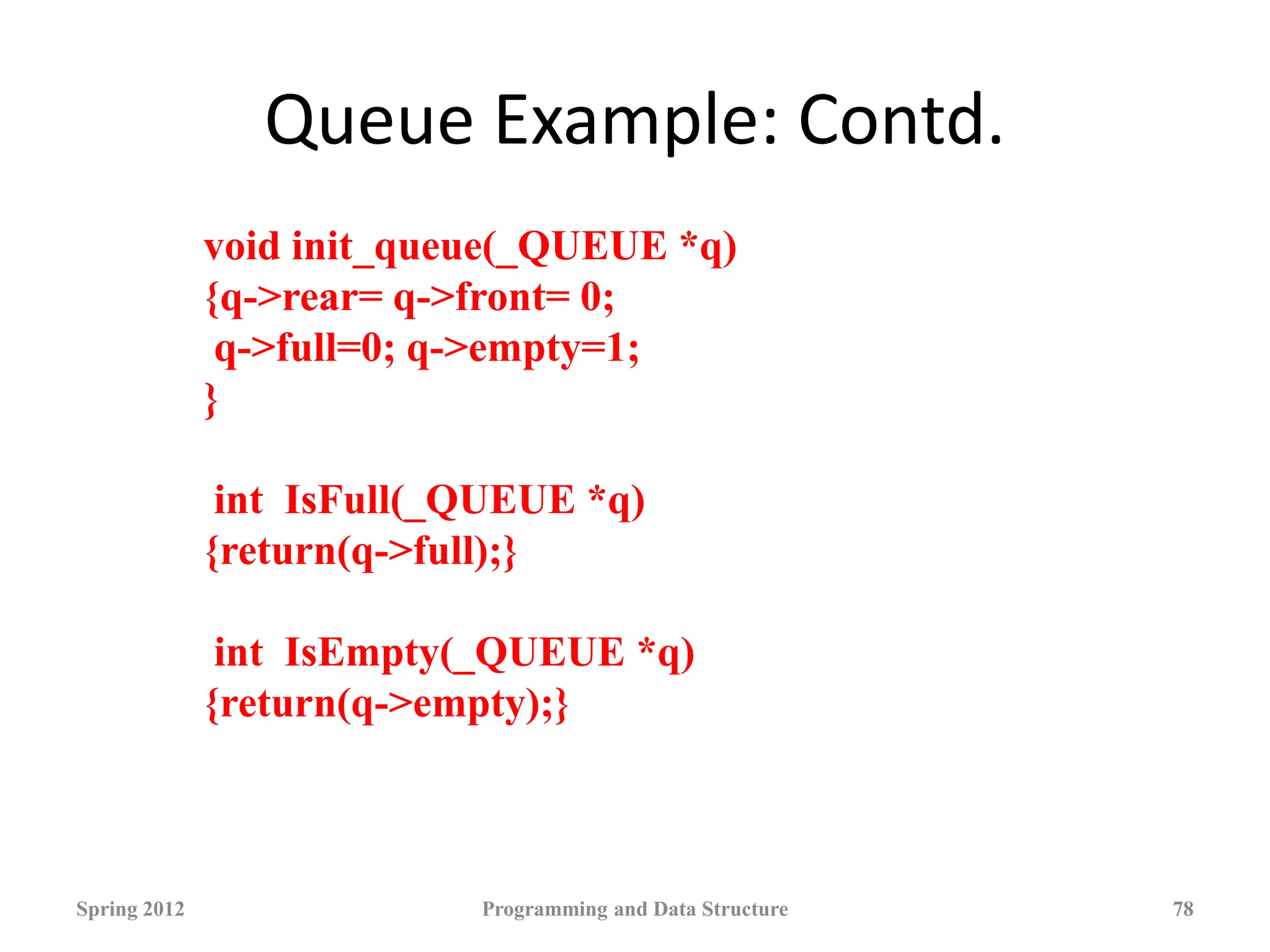
![Queue Example: Contd.
Spring 2012 Programming and Data Structure 79
void AddQ(_QUEUE *q, _ELEMENT ob)
{
if(IsFull(q)) {printf("Queue is Full n"); return;}
q->rear=(q->rear+1)%(MAX_SIZE);
q->q_elem[q->rear]=ob;
if(q->front==q->rear) q->full=1; else q->full=0;
q->empty=0;
return;
}](https://image.slidesharecdn.com/wk11-linkedlist-240122110853-9cf73267/75/Wk11-linkedlist-ppt-78-2048.jpg)
![Queue Example: Contd.
Spring 2012 Programming and Data Structure 80
_ELEMENT DeleteQ(_QUEUE *q)
{
_ELEMENT temp;
temp.name[0]='0';
if(IsEmpty(q)) {printf("Queue is EMPTYn");return(temp);}
q->front=(q->front+1)%(MAX_SIZE);
temp=q->q_elem[q->front];
if(q->rear==q->front) q->empty=1; else q->empty=0;
q->full=0;
return(temp);
}](https://image.slidesharecdn.com/wk11-linkedlist-240122110853-9cf73267/75/Wk11-linkedlist-ppt-79-2048.jpg)
![Queue Example: Contd.
Spring 2012 Programming and Data Structure 81
main()
{
int i,j;
char command[5];
_ELEMENT ob;
_QUEUE A;
init_queue(&A);
command[0]='0';
printf("For adding a name use 'add [name]'n");
printf("For deleting use 'delete' n");
printf("To end the session use 'bye' n");
#include <stdio.h>
#include <stdlib.h>
#include <string.h>](https://image.slidesharecdn.com/wk11-linkedlist-240122110853-9cf73267/75/Wk11-linkedlist-ppt-80-2048.jpg)
